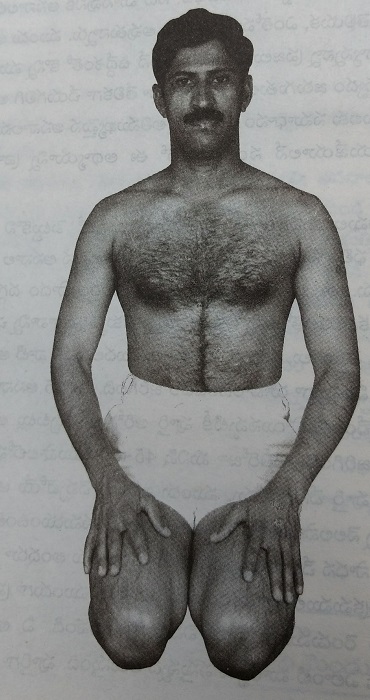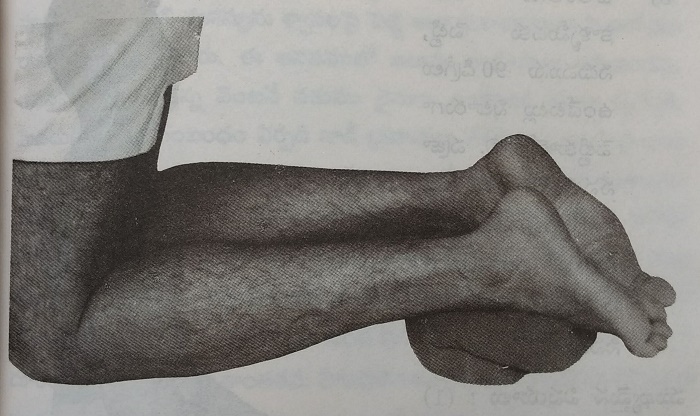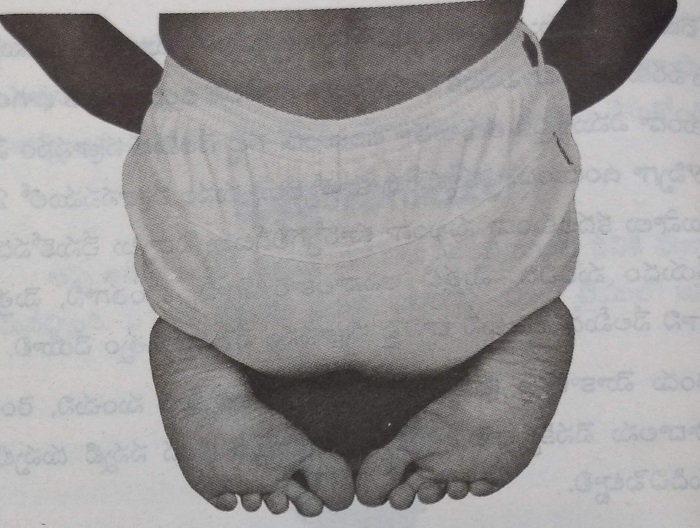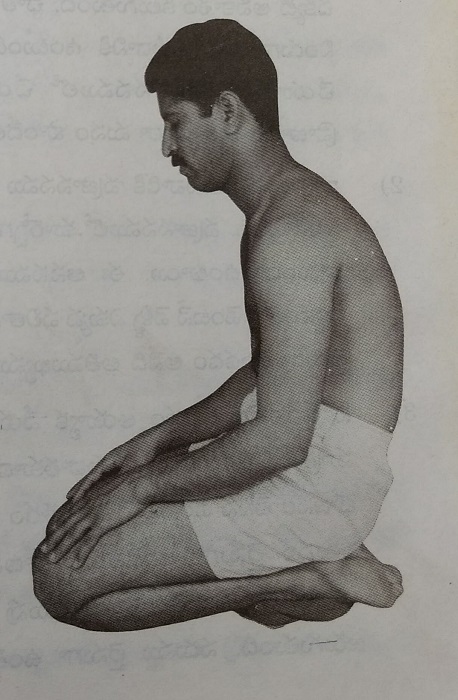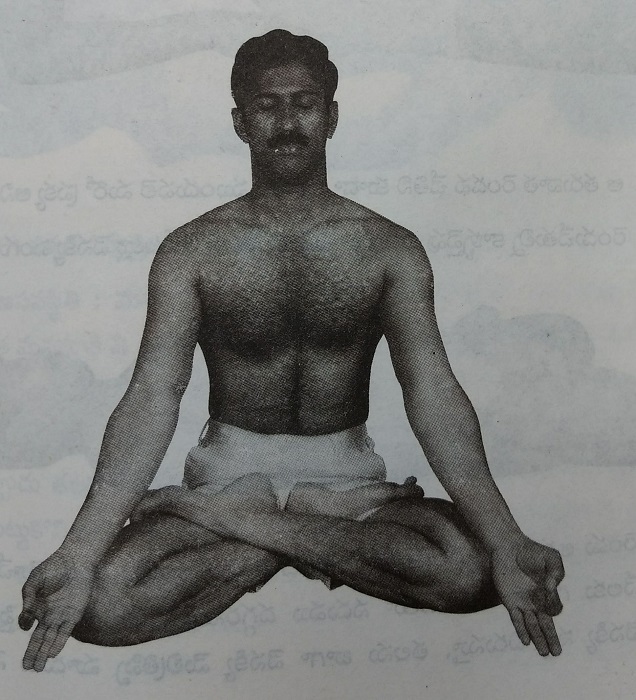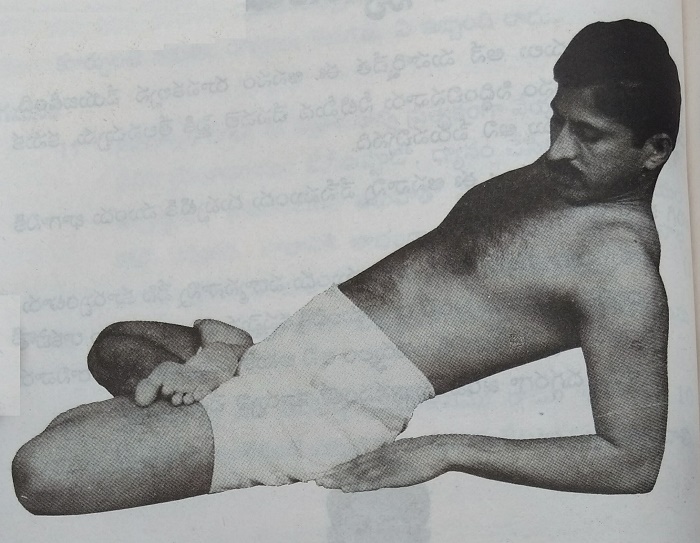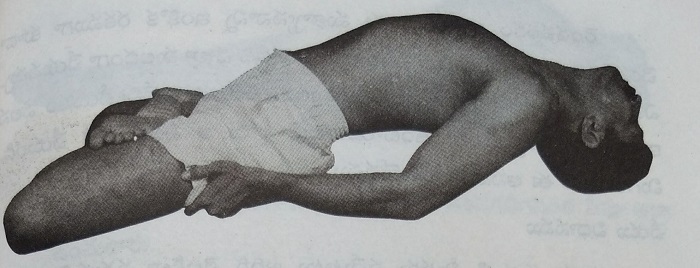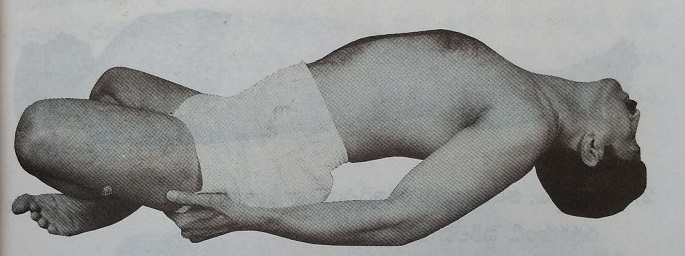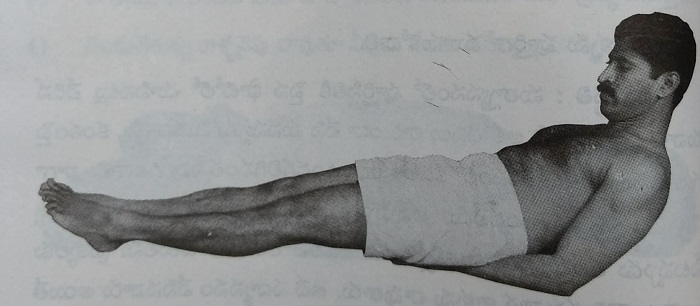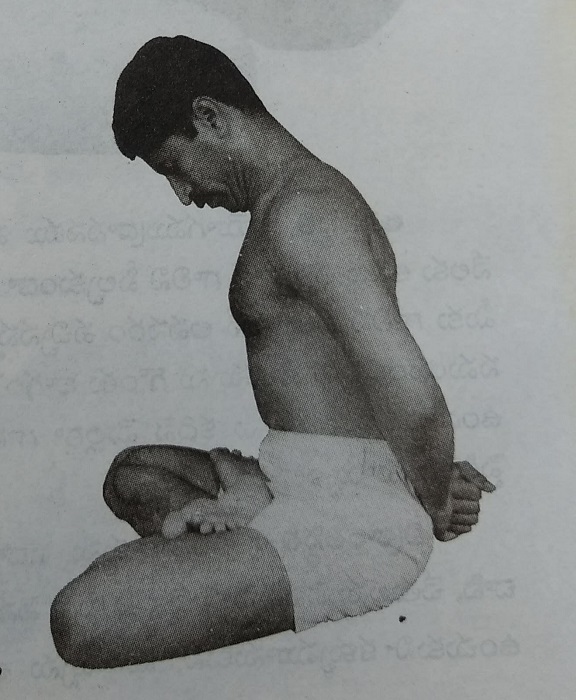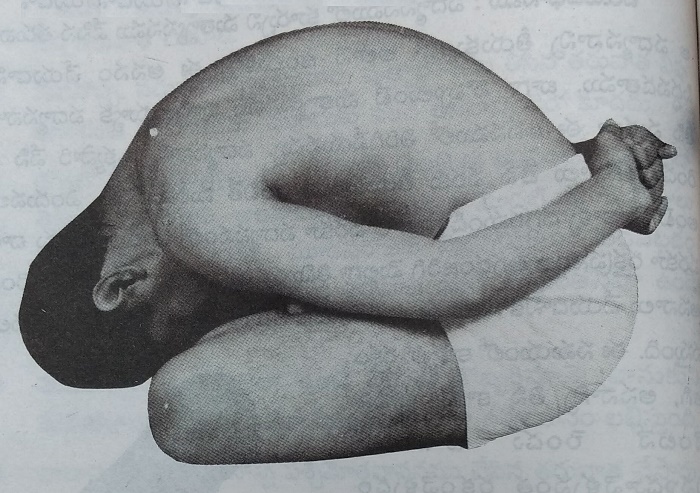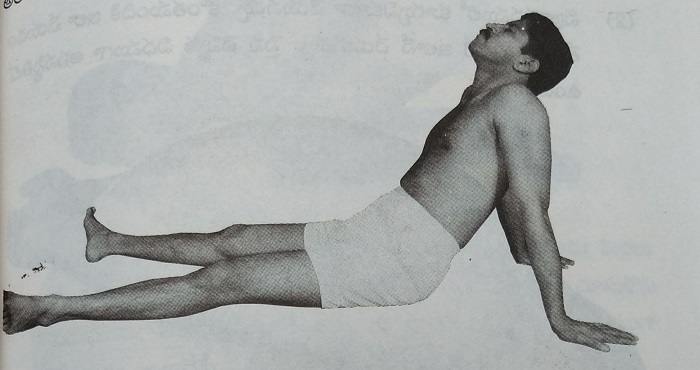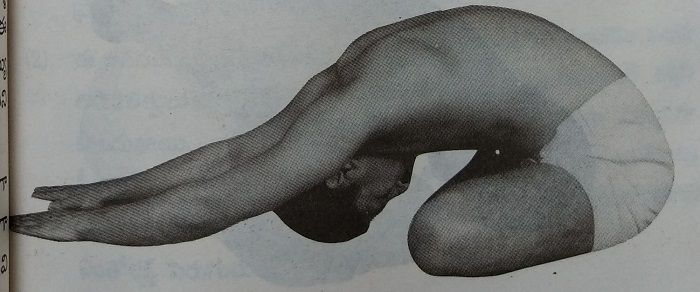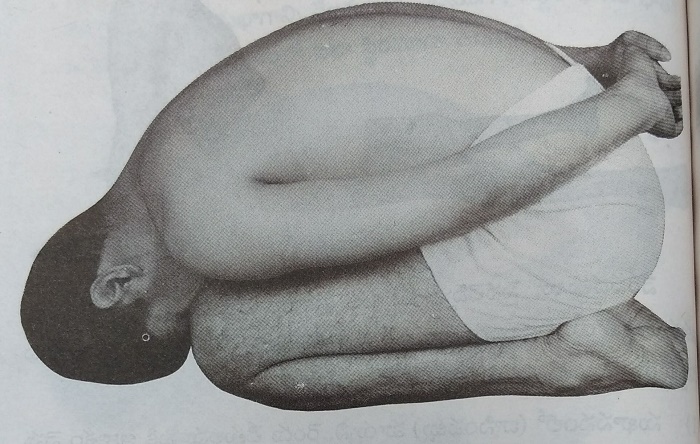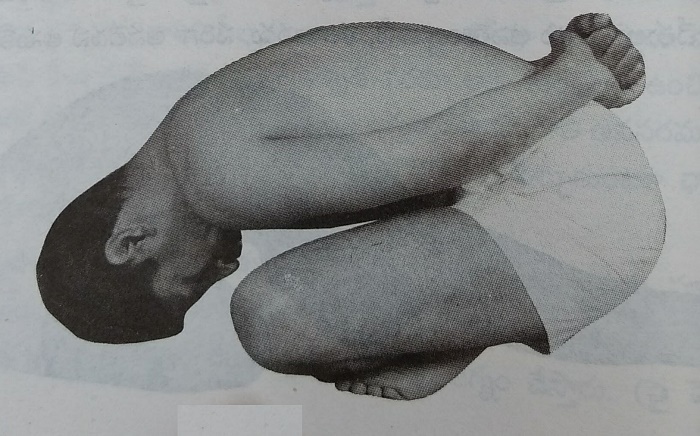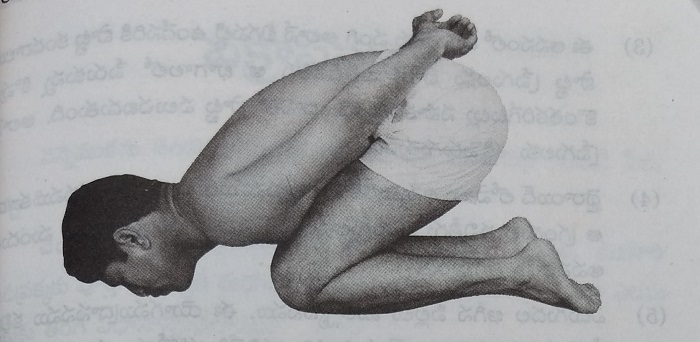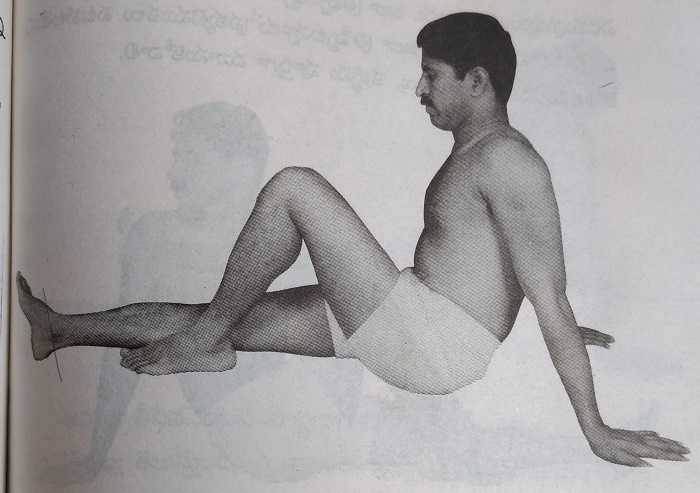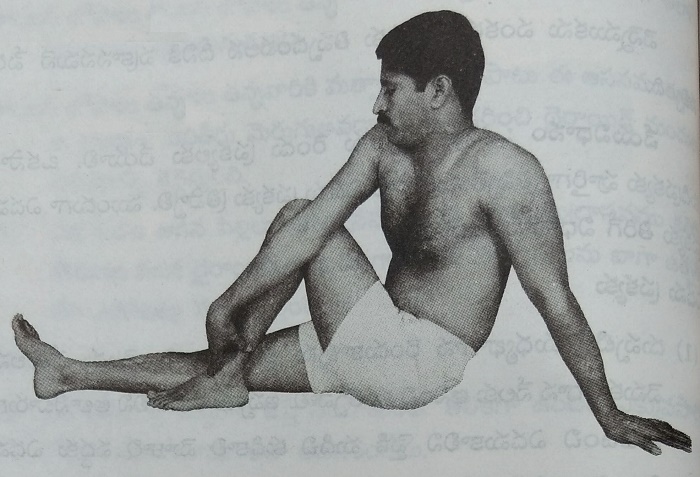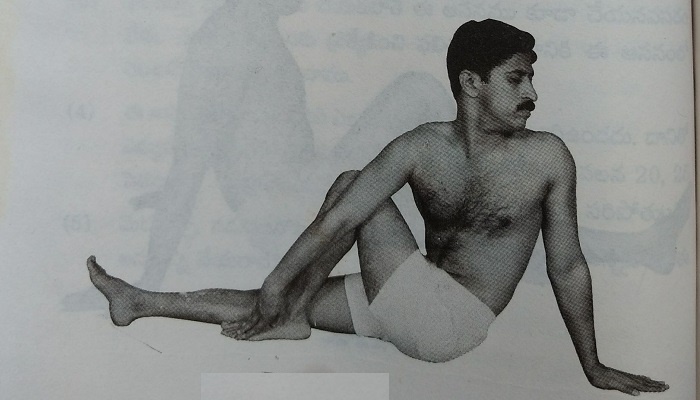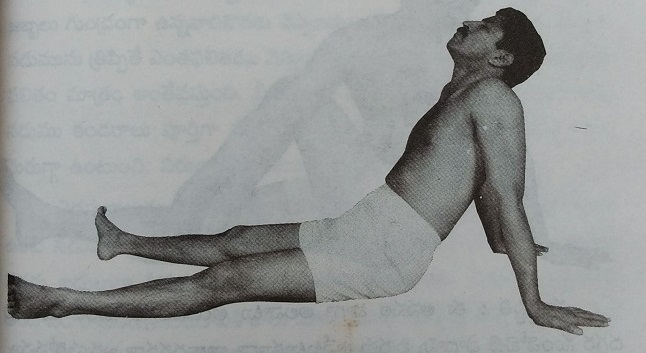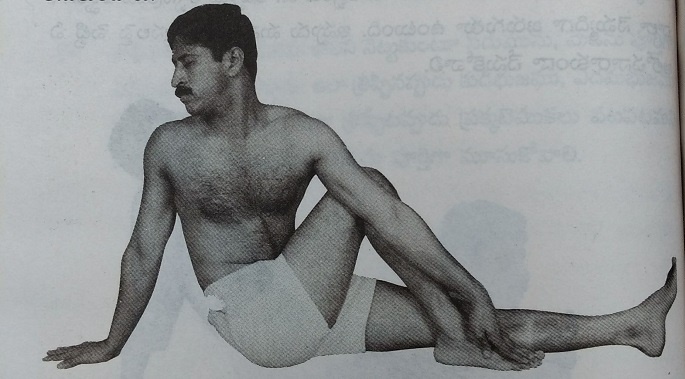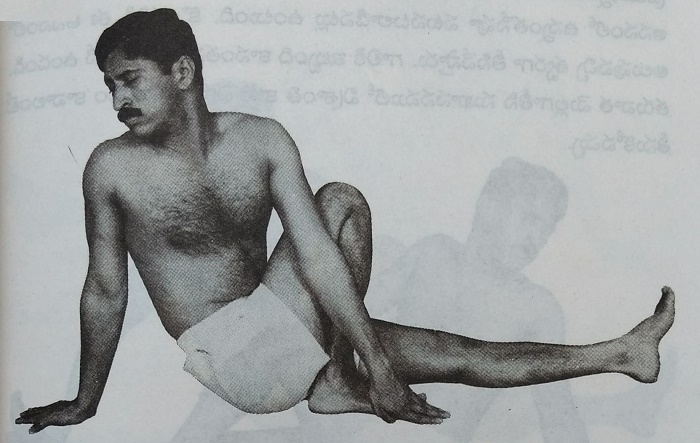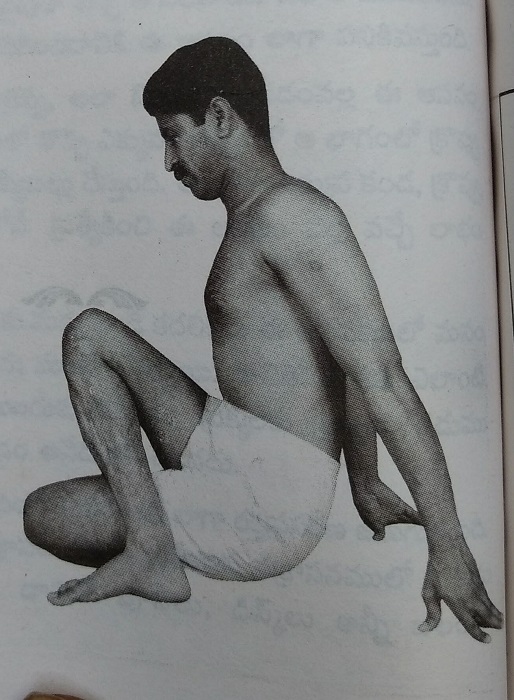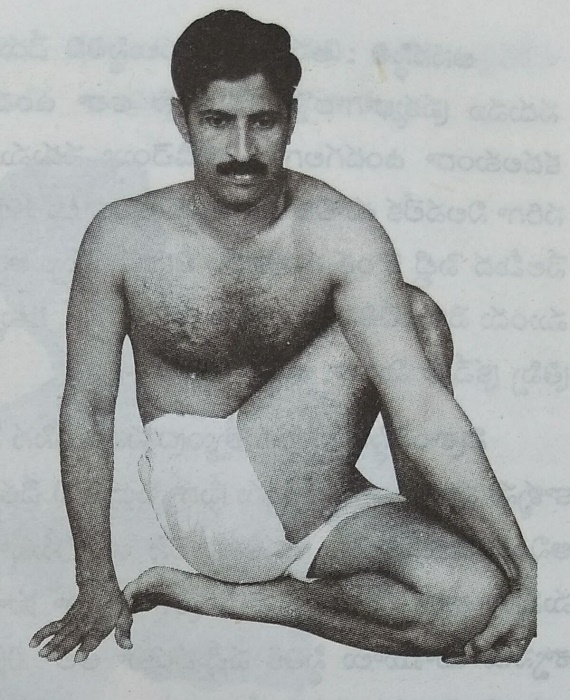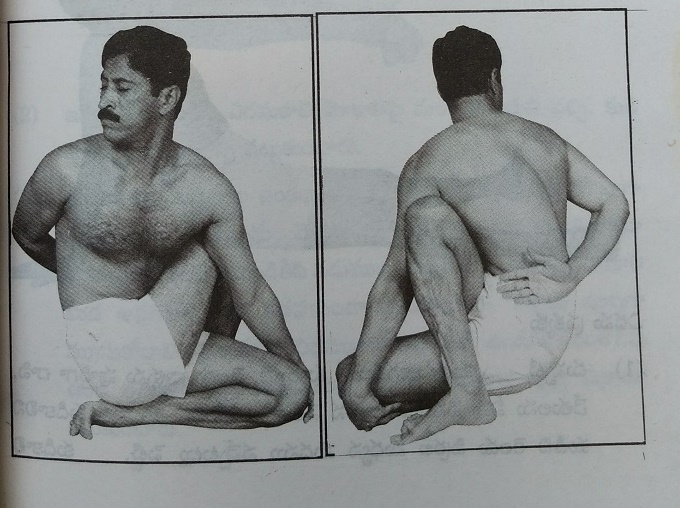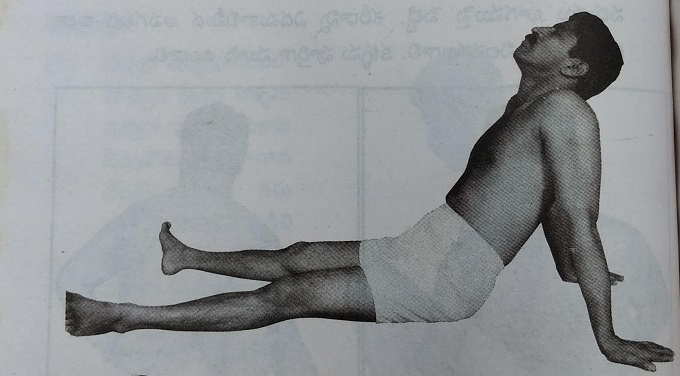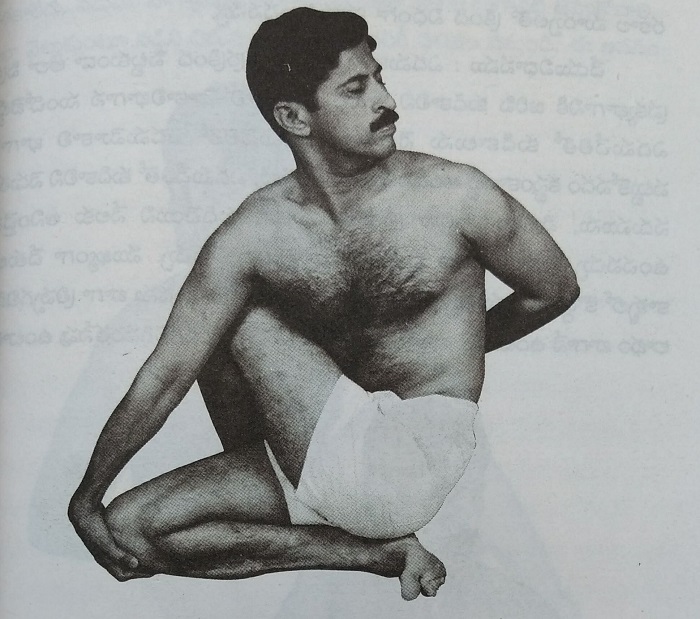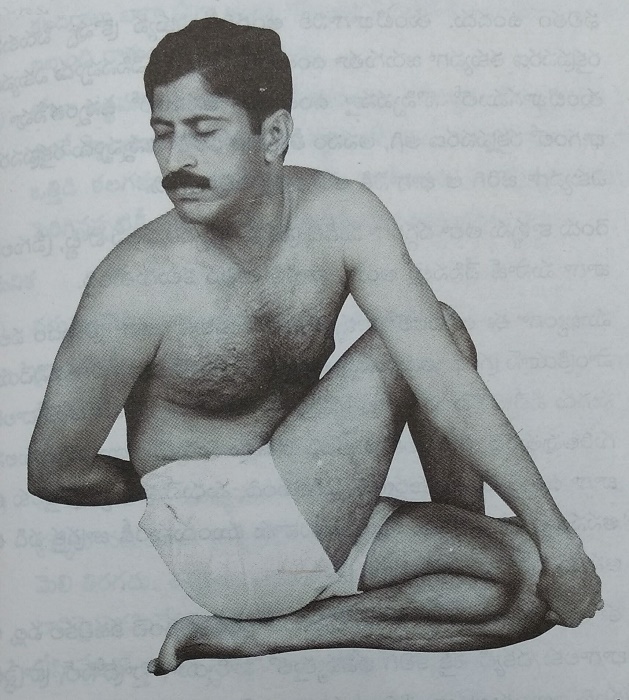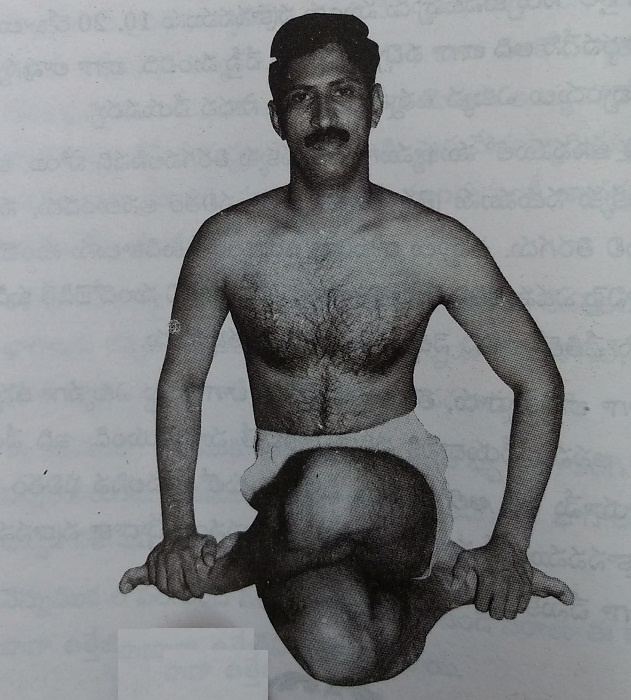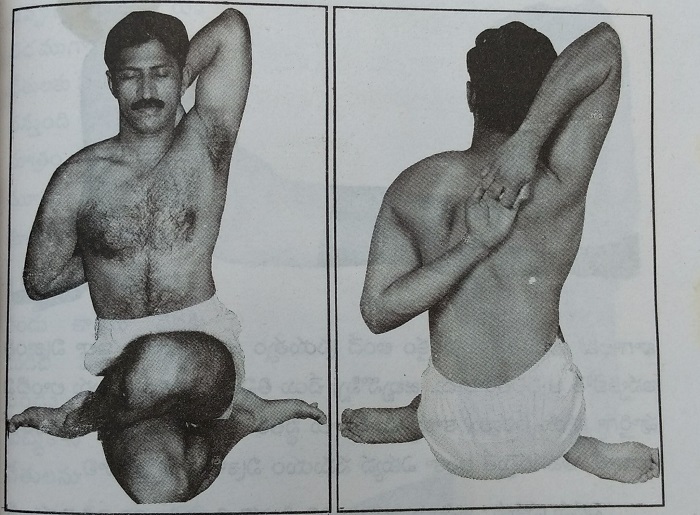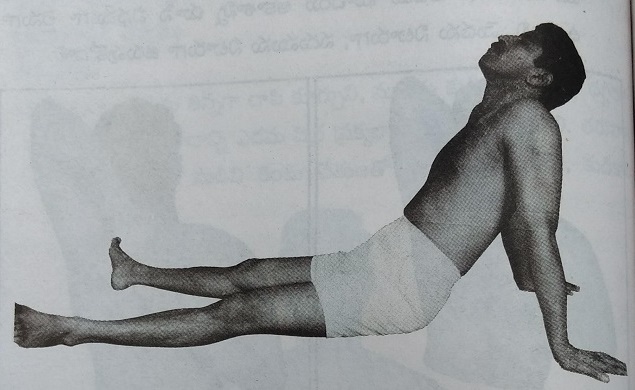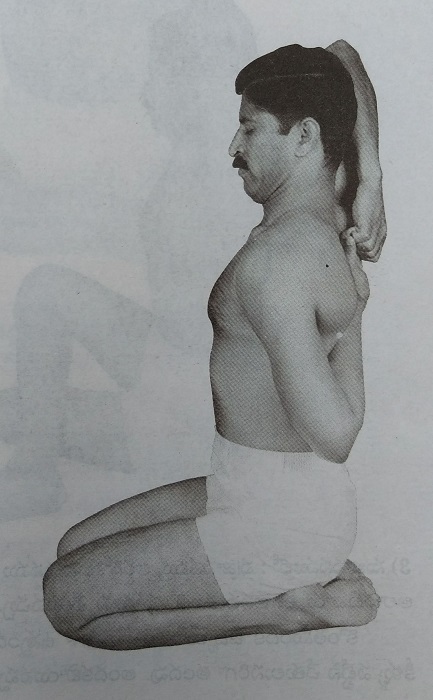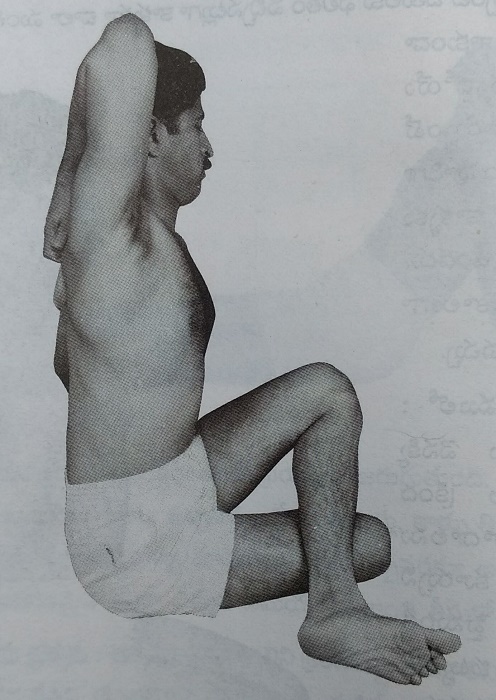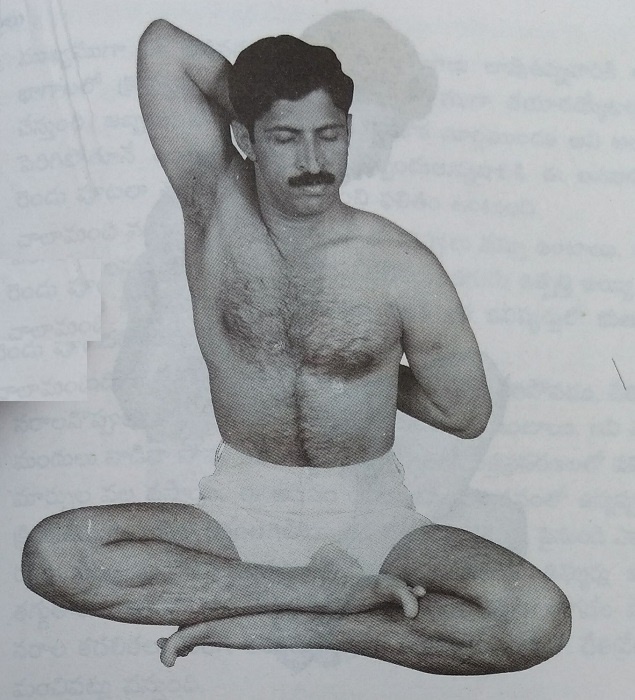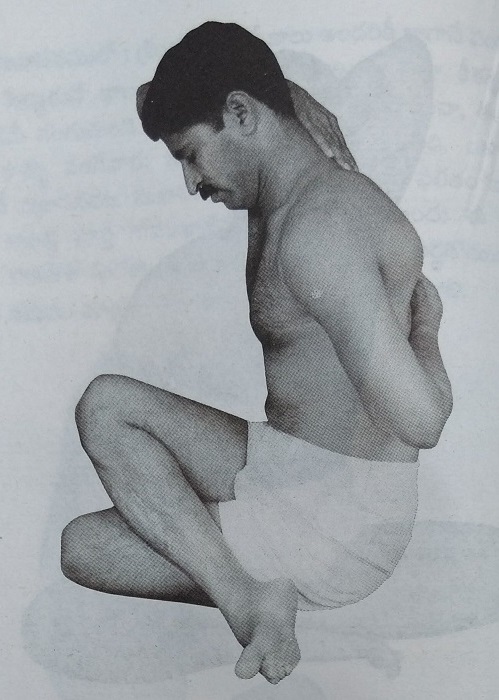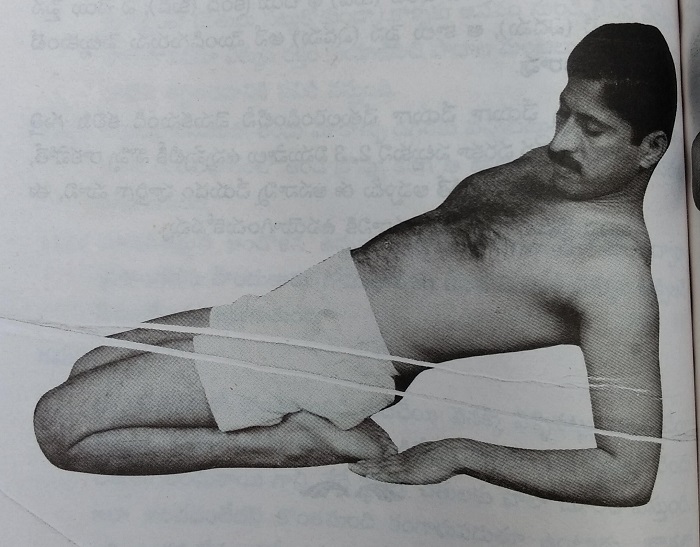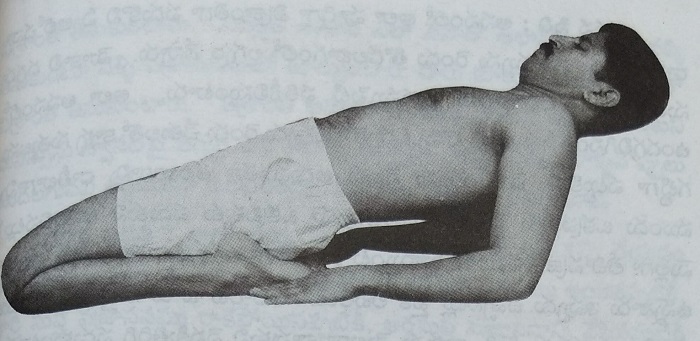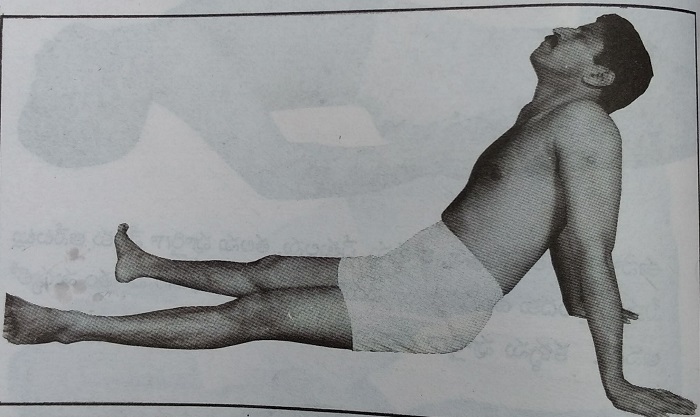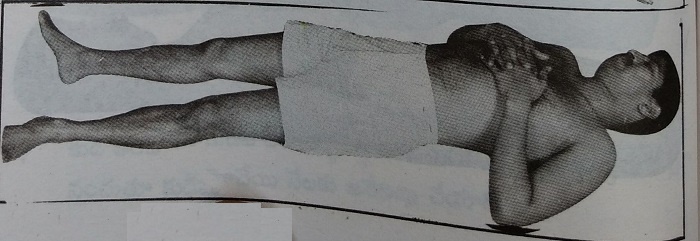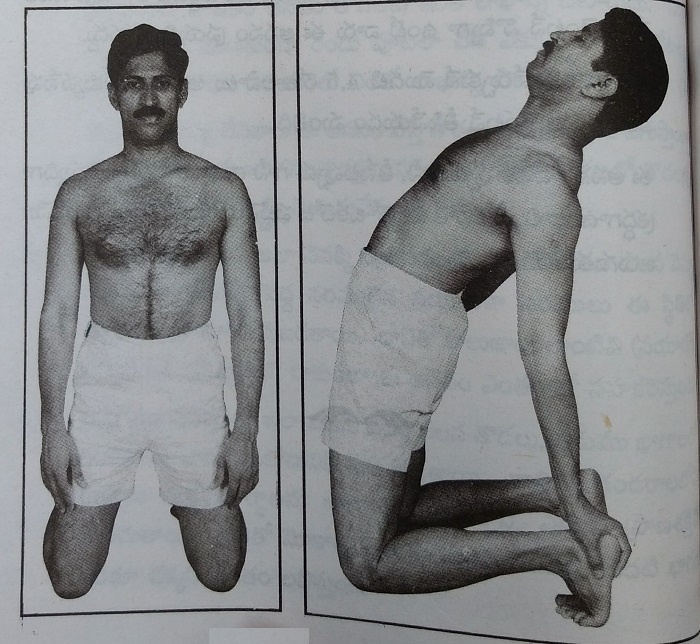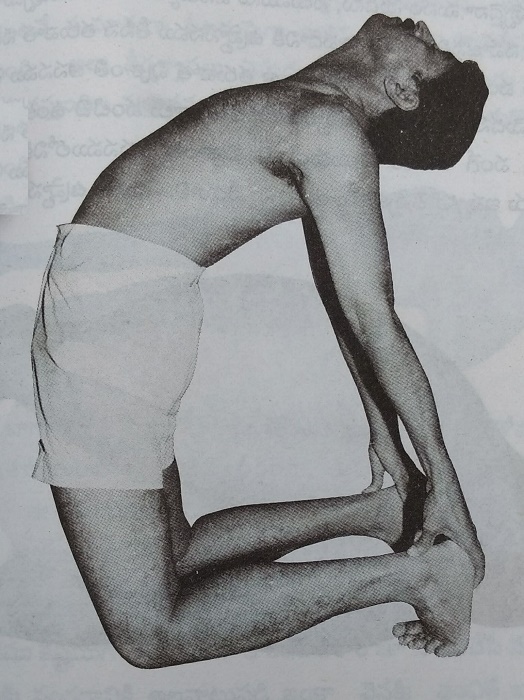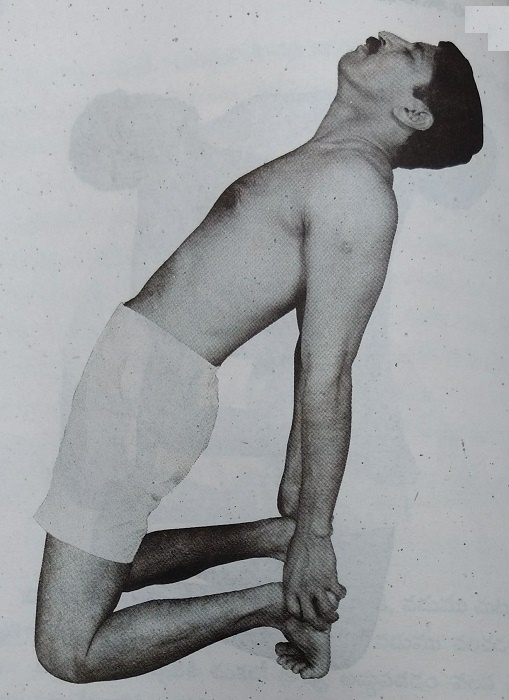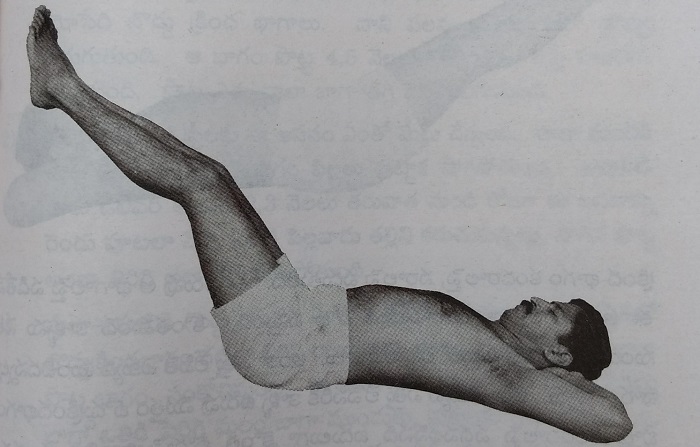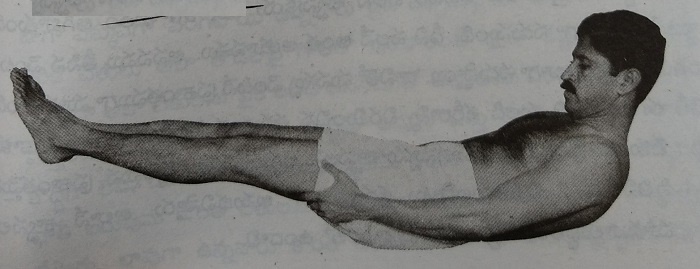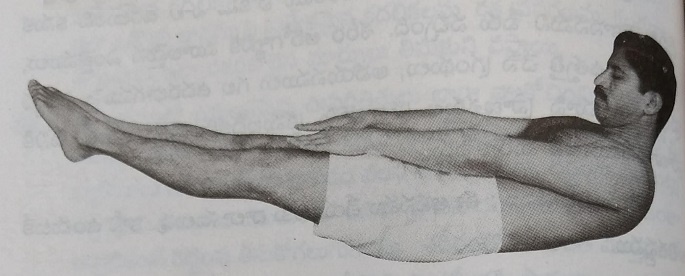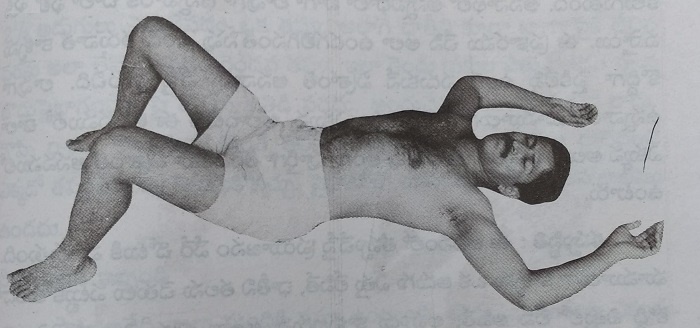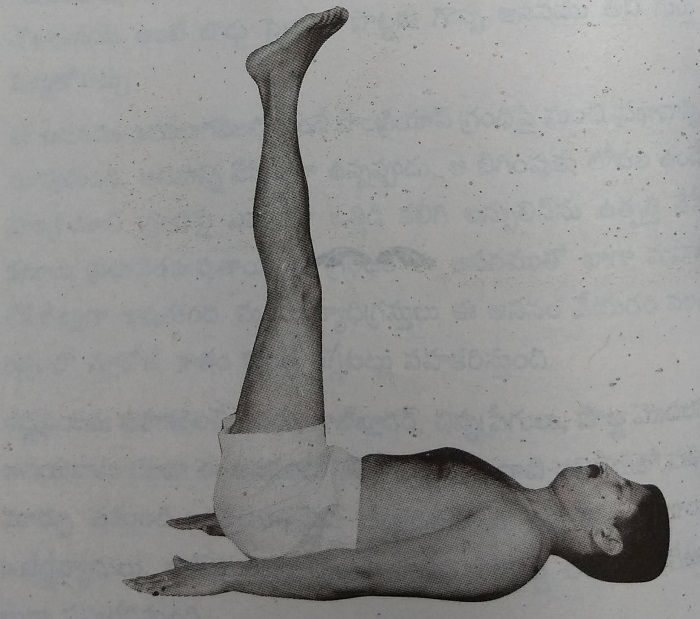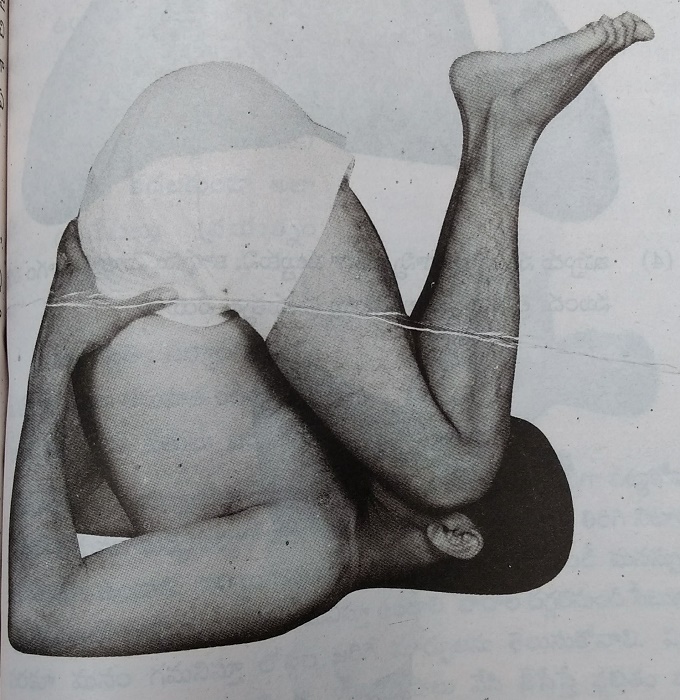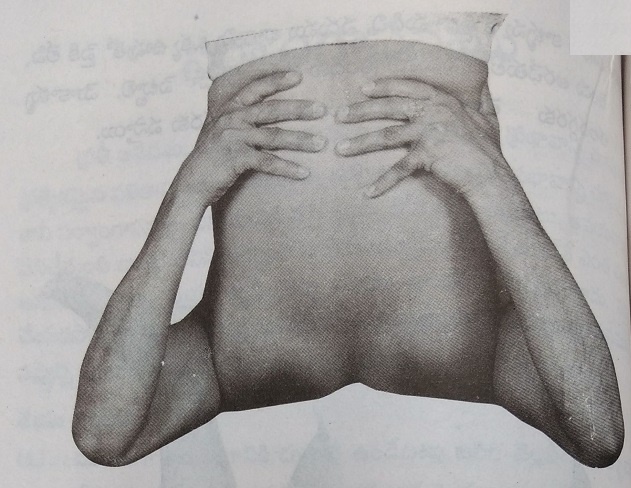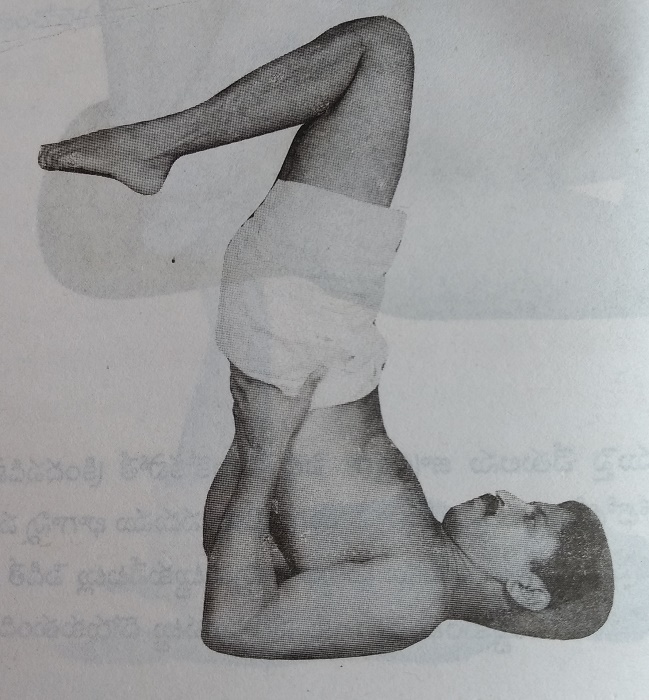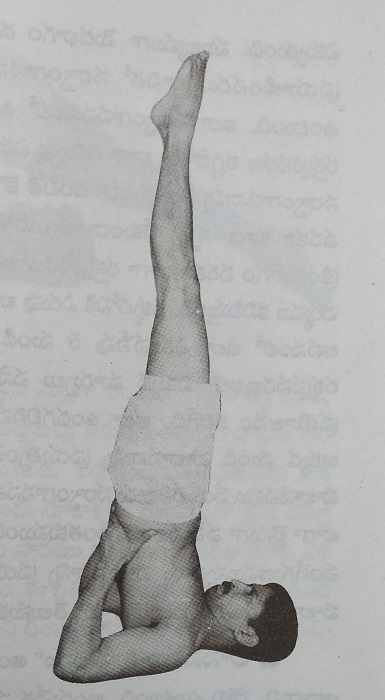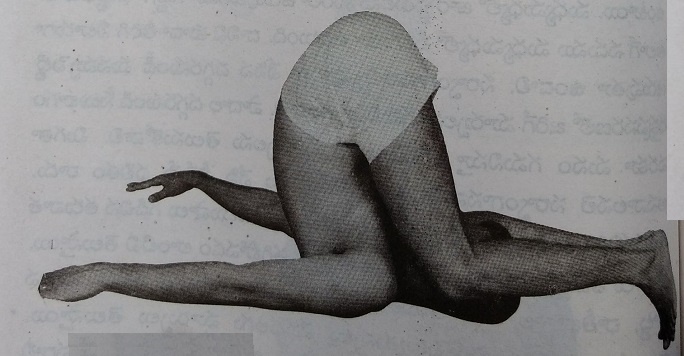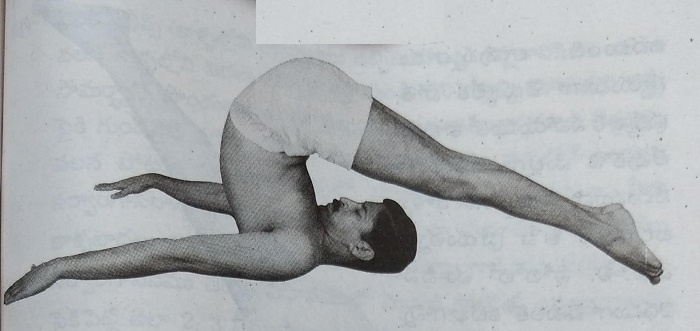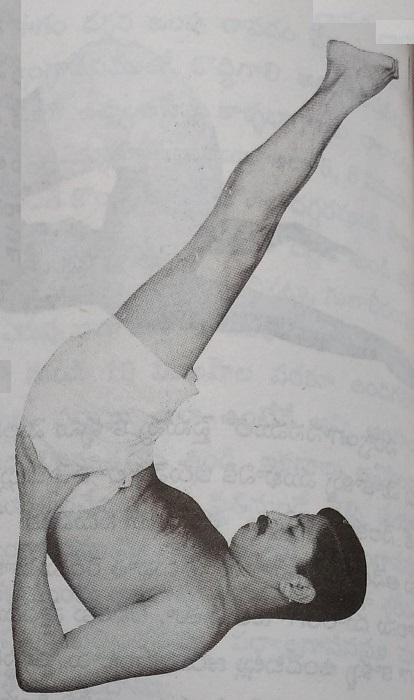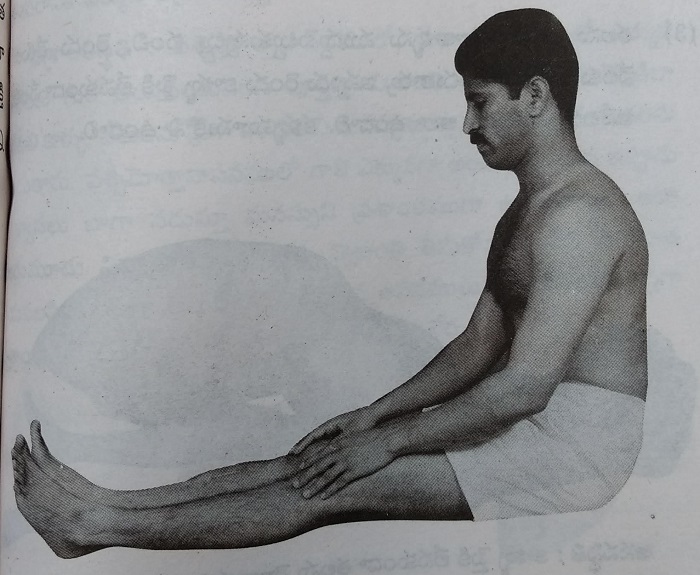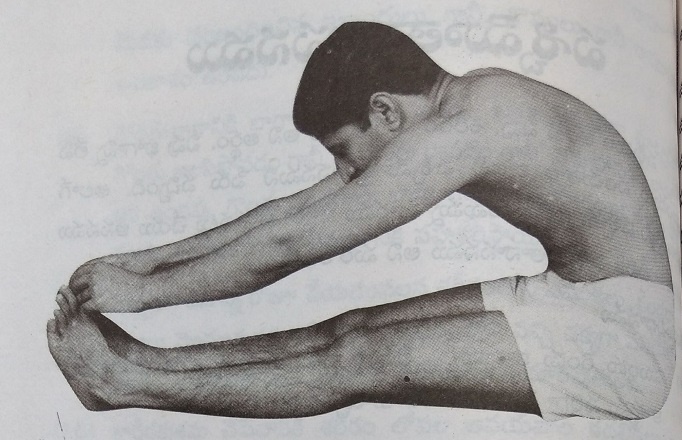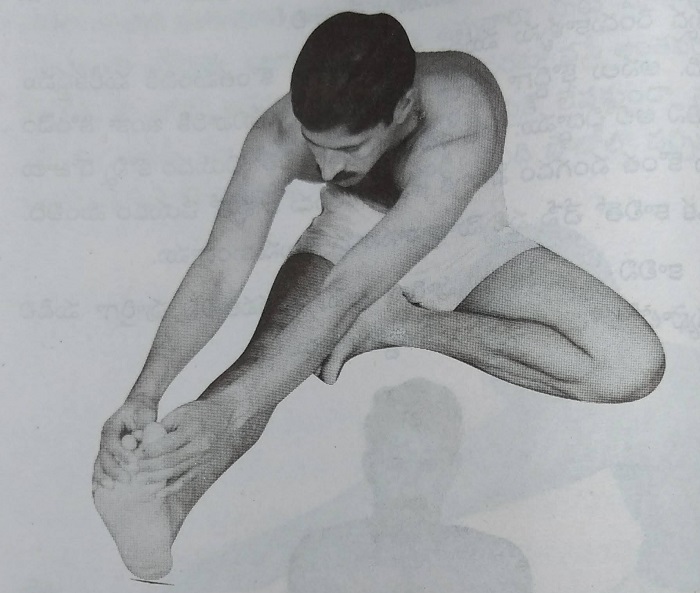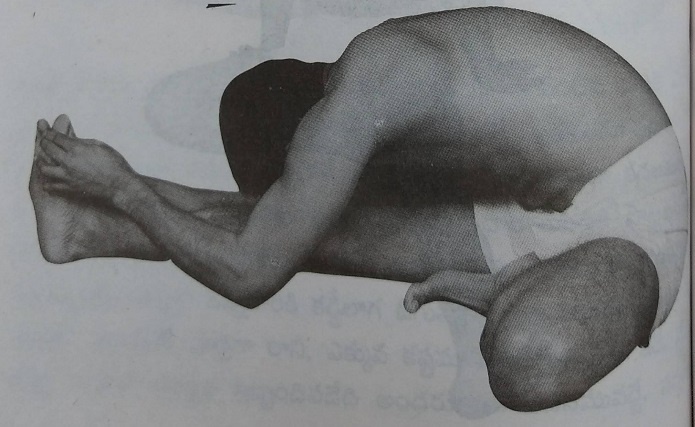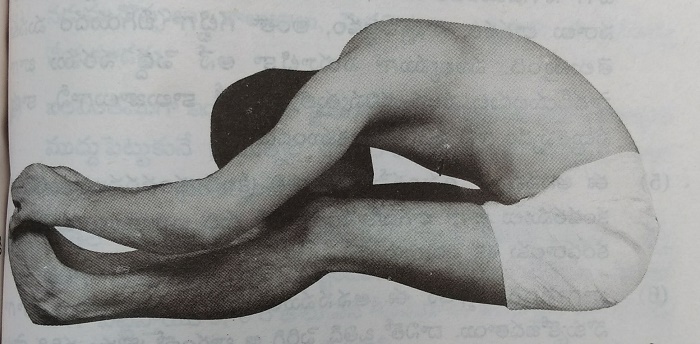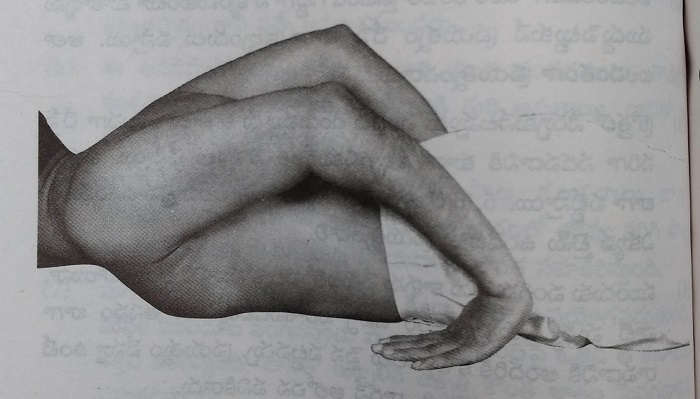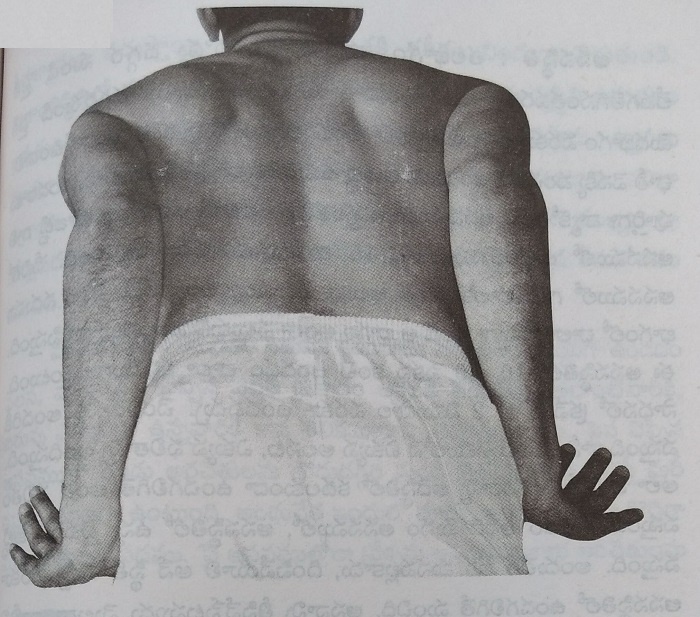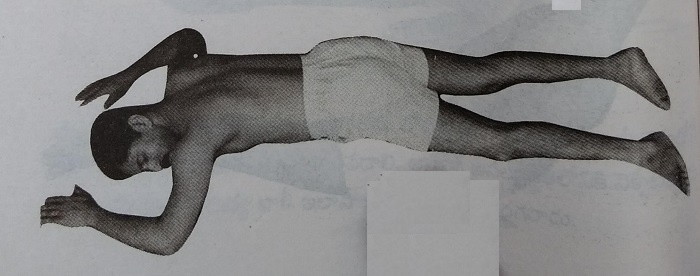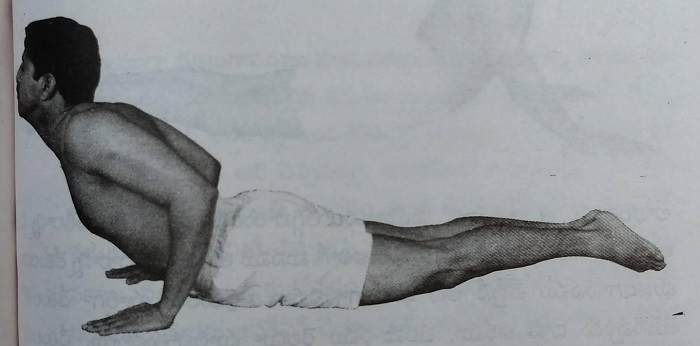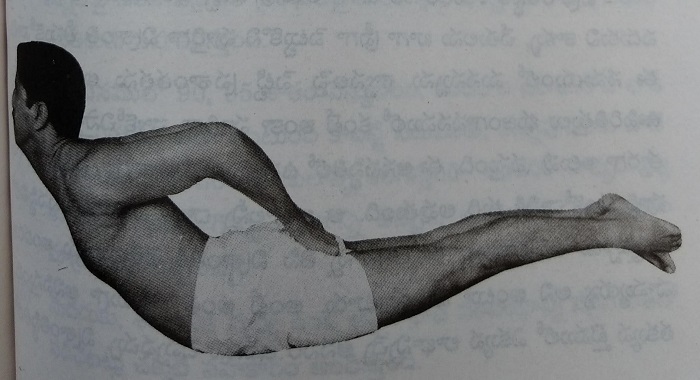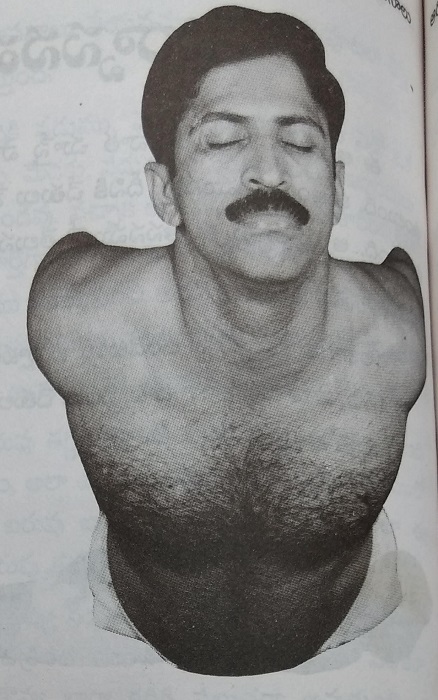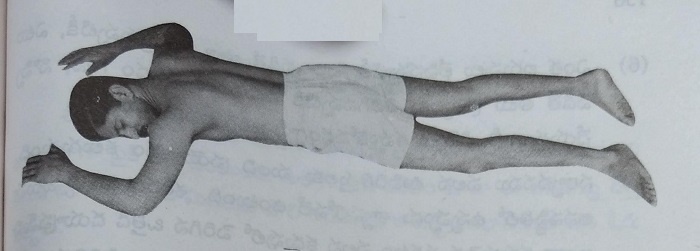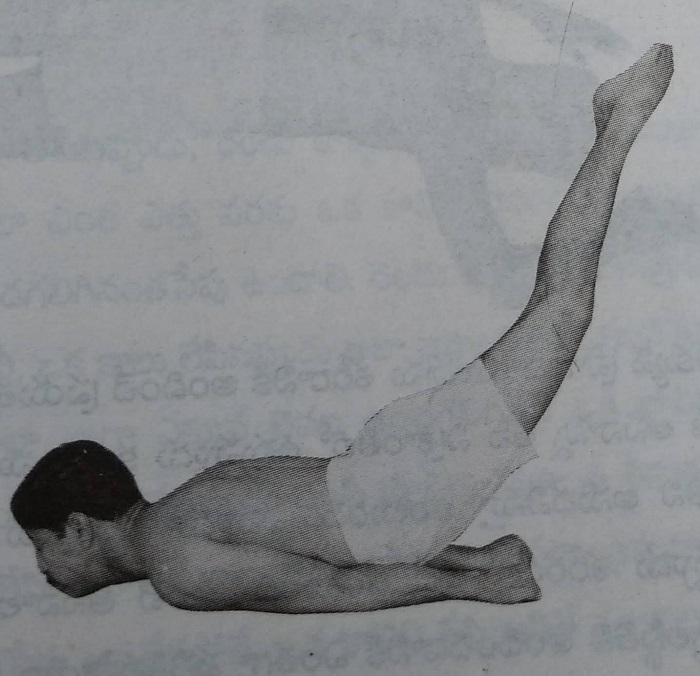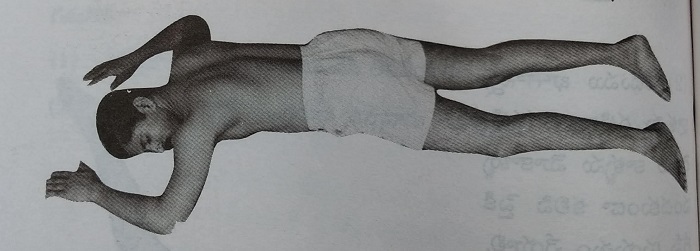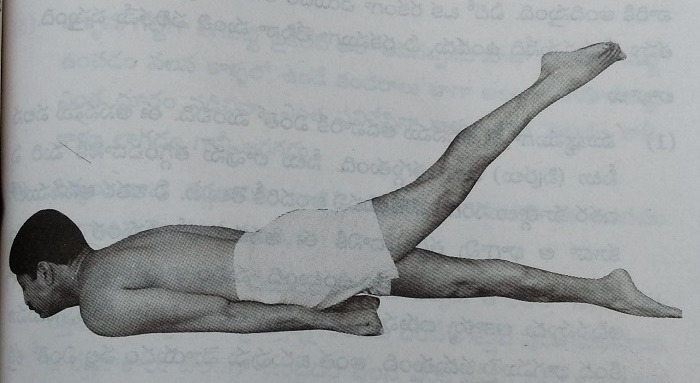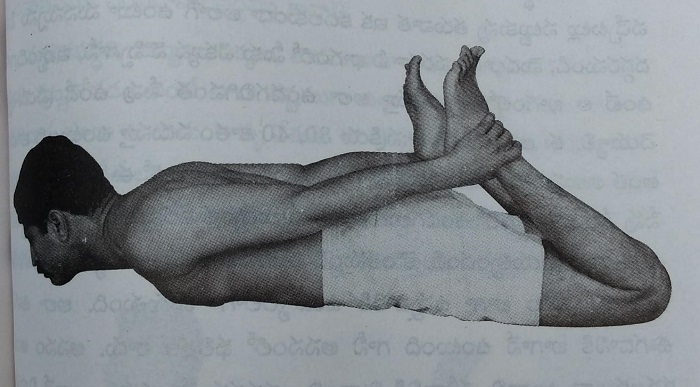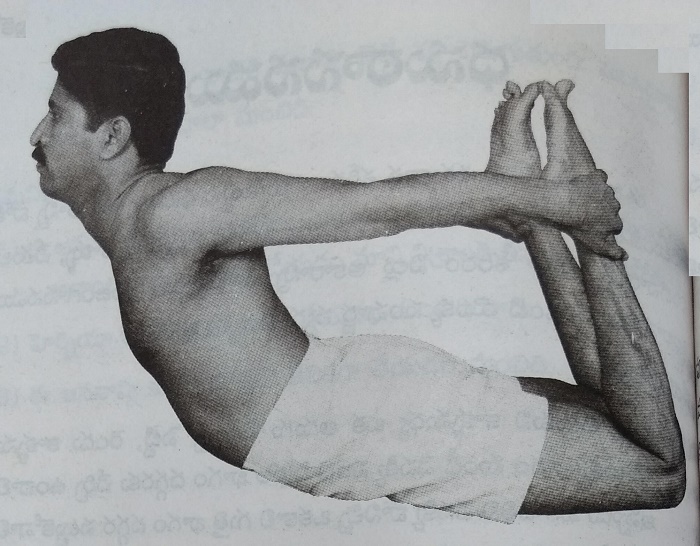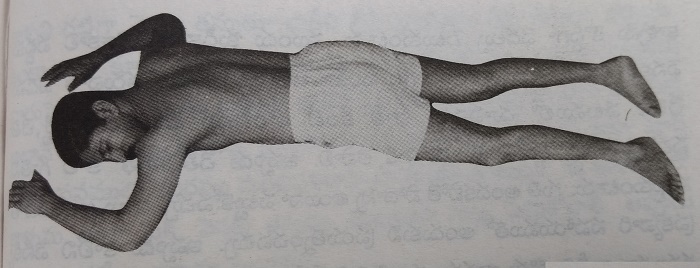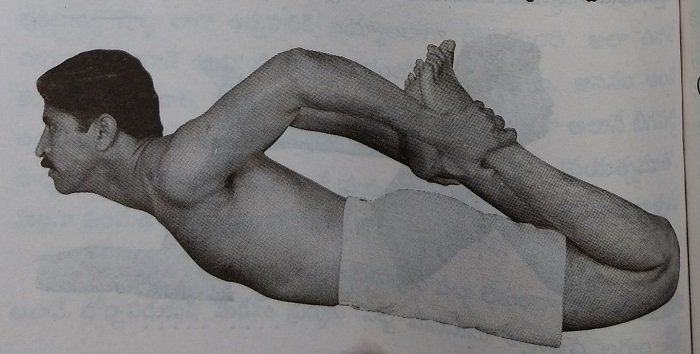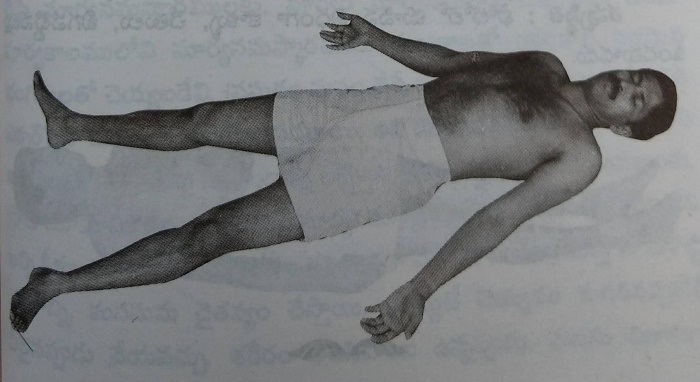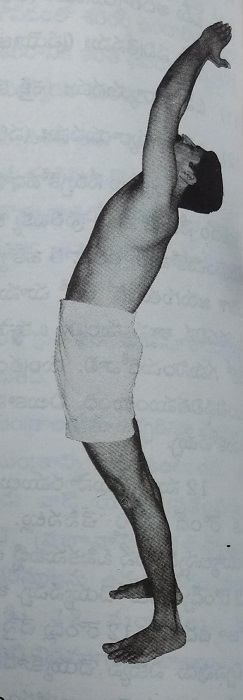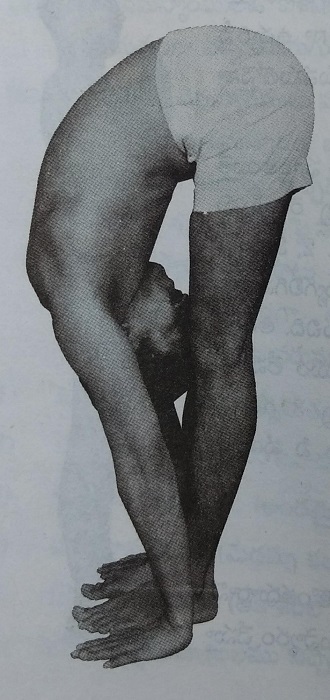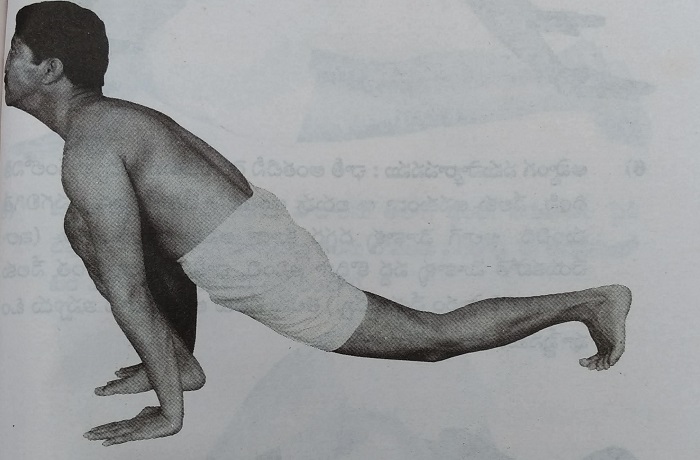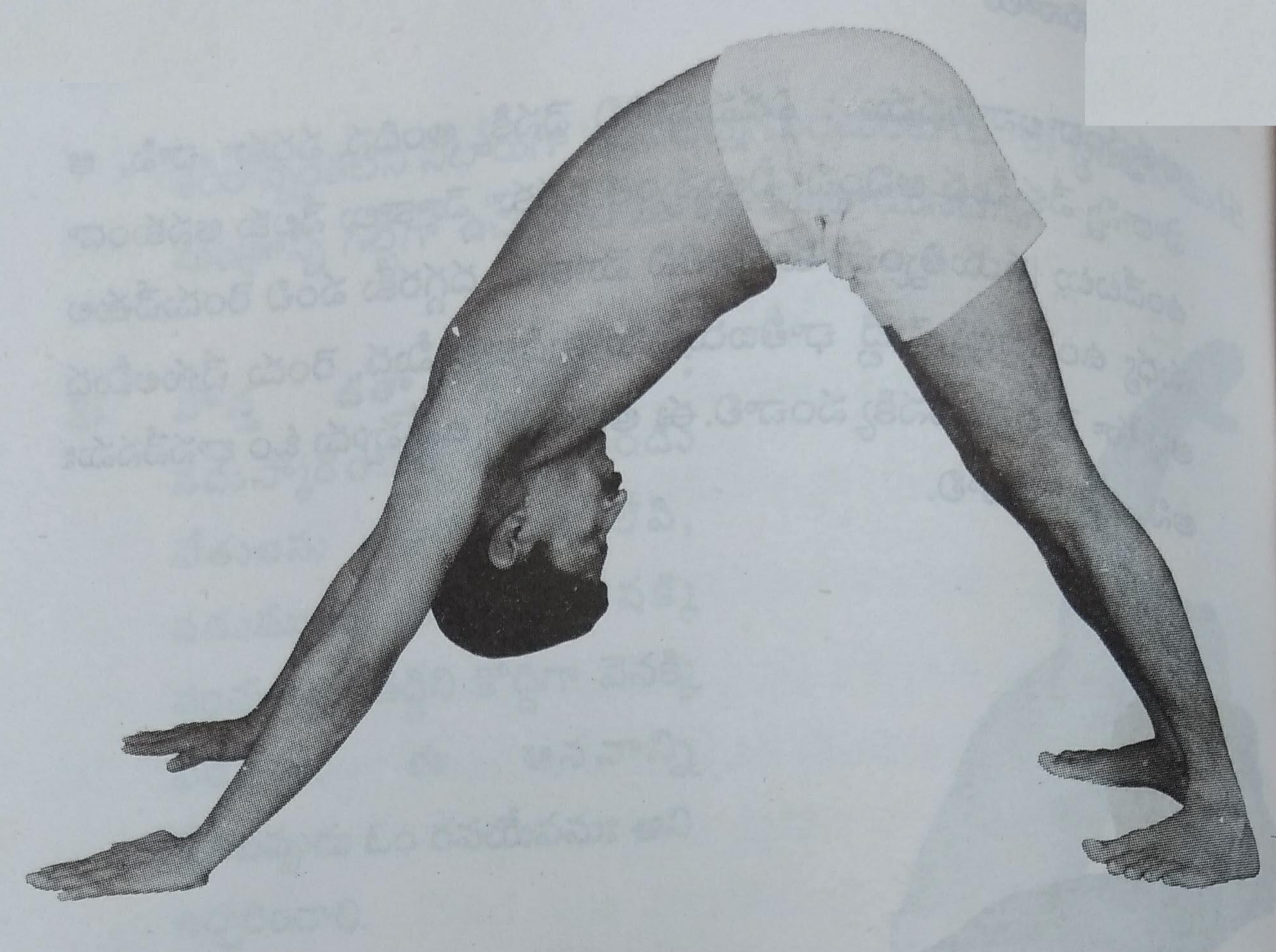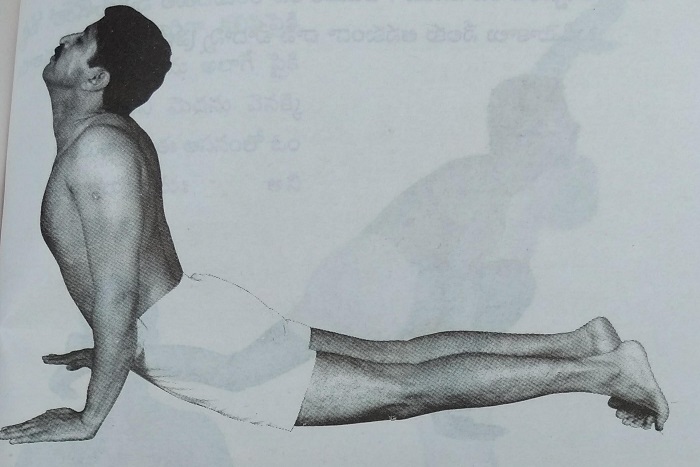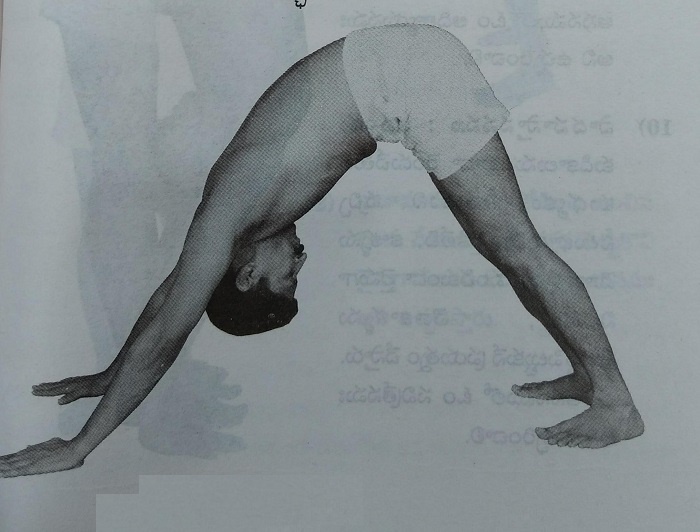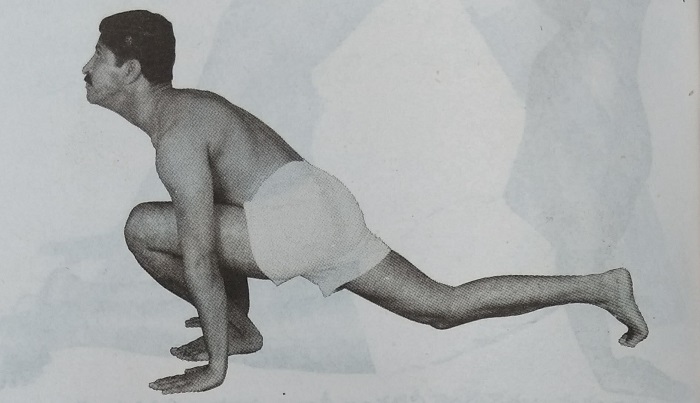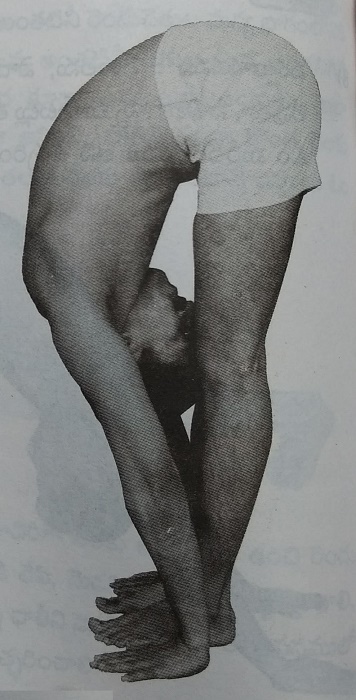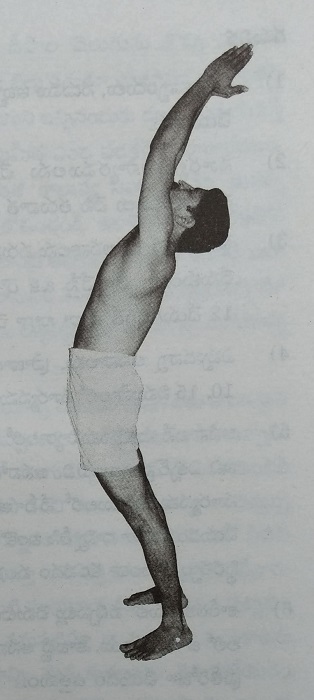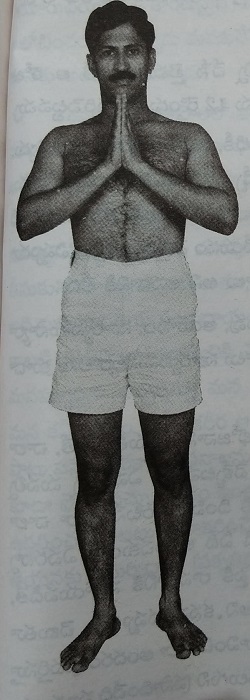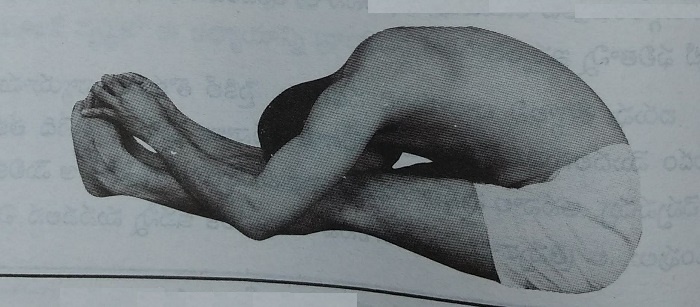Asanas - Inscription for Health
(Sukha Jeevana Sopanalu - 6)
Complete Health
Protect
Always treasure
Experience
Dr. Manthna Satyanarayana Raju
Table of Contents
Dedication
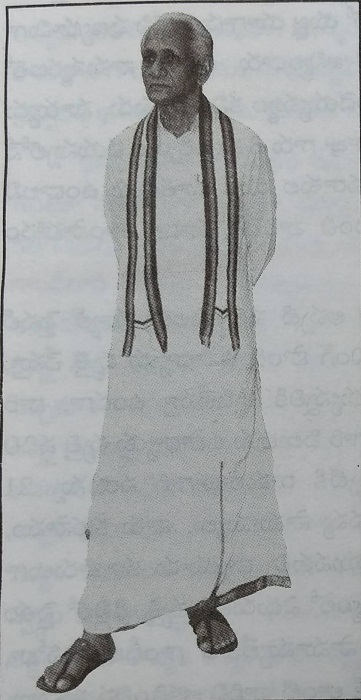
With due respect, I am dedicating this book “Asanalu – Arogyaniki Shasanalu” to my teacher, Dr. V.V. Ramaraju, who gave me the treasure of health, who made me realize the health secrets and who carved my life path with love and compassion for the service of the society.
- Dr. Manthena Satyanarayana Raju
Dhanvanthari sama vaidyulu
The life history of Dr. V.V. Ramaraju (Dr. V.V. Ramaraju Jeevitha Sangraham)
Dr. Vegiraju Venkata Ramaraju was born on July 2nd, 1913, at Marripudi village, in Bapatla talooq, in Guntur district. Marripudi village is a well-known place for all auspicious and sacred activities such as yagas. He is the younger son of Sri Vegiraju Kotamraju and Ademma. Sri Vegiraju Kotamraju was a staunch devotee who recite the God’s divine name all the time. Just as rising the sun kindles light, he realized – at the age of 8 years – that non-vegetarian food is not the food of humans and all humans should have compassion for all living things. He was such a humanitarian that he fought with the elderly people and made them stop eating non-vegetarian food.
He used to like learning and education a lot. At that situation, he completed his school final, got trained as a teacher in a British school and worked as a teacher, while working for the development and growth of many nearby schools. In response to his brother, Vaidyaraju Vegiraju Krishnamraju’s call, he left his teacher’s job, and took naturopathy method. At that time, he was 21 years old. Sri Krishnam Raju was an extraordinary person. He trained many youngsters in martial arts and physical exercise. He was an expert in naturopathy. When he gave speech in sanscrit in Delhi, apart from common people, he attracted Mahatma Gandhi, Vinoba Bhave, Purushottamdas Tandom, and Jamanlal Bajaj. Ramaraju was a natural doctor who got inspired from him and ran a movement in rural natural treatment, and fought against many difficult diseases. Once, the village head was in a fatal condition, and as per his brother’s instruction, he attended the case. The village head was laid down in a hut. Ramraju has checked the patient, rubbed the stomach, took him inside, did enema, cleaned his rectum and gave him a bath. In an hour, the village head became normal by talking to others and drinking milk. The villagers thought that the head would die in an hour, but were surprised to know that he got recovered. The villagers started treating Ramaraju as a Balayogi, and the news spread that ‘he doesn’t eat anything except fruit and he gave life to the village head’. People flooded to see him. He was so simple a man that he revealed to them that, ‘this is neither mantra or tantra. I eat uncooked food. I cleaned his rectum through the nature’s cure method’.
In those days, when cholera epidemic would spread in villages, people would leave the corpses as they are and would flee the villages. Ramaraju would encourage youngsters to dig big pits so that the corpses were buried. Even the Britishers would be surprised to see the incident.
Ramaraju garu would take uncooked food i.e., raw and natural food and visited so many famous people by riding bicycle for around 3800 miles (6000 kilometers). Among them, visiting mahtma Gandhi was an important incident. On that day, Gandhiji’s visiting hours are over. Gandhiji didn’t allow anyone to see him. Then, Ramaraju garu sent him a small note. Gandhiji read the note and invited him inside, and asked, ‘you are a youngster. Why are you eating raw vegetables?’ Then he said, ‘this is my brother’s instruction. We are making an experiment to tell people that natural food has so much strength’. Then Gandhiji complimented him by saying, ‘Beta, tum achha kaam kar rahe ho! Math Chodo!’ and recited a poem. In Ramaraju’s photographic memory, the poem was imprinted. The poem was: Nantaham kamayo rajyam, na swargan na punarbhaavam – kamayo dukhataptaanaam, paninam aarthi nashanam” It means, “I don’t want kingdom, I don’t want heaven. Neither do I need rebirth. What all I need is the strength to rectify the problems of people who suffer’. Ramaraju garu did not forget these sentences till now, and he made his life’s ambition to give people free treatment and food. In this way, he ate uncooked food for 7 years – from 1936 to 1942 and spread its importance to the world.
His brother established naturopathy ashrams in Bapatla and Nakirekal forest. There are strange experiences in maintaining these ashrams. At that time, he told two things: 1. Hunger is a lie 2. Fatigue is a terrible lie. He said that this is a testimony told 50 years ago. When one aboriginal man (girijan) was suffering from vomiting, his relatives brought him to the ashram. He was not able to talk. He was not moving – body dried up. Ramaraju garu started treatment. On one night, when there was a commotion from his hut, Ramaraju garu and a servant went there immediately. They feared that a bear might have took the girijan away. But, when looked in the light of the lamps, he was lying on the cot. They tried to speak to him. He could hardly move his eyes, but did not respond. When they looked in the morning, they could find a 7 feet cobra. He couldn’t tell anything despite asking. After 7-8 days, when he got recovered, he revealed that on that day, he himself killed the snake but then fell down again. Ramaraju garu has thought about the incident in different ways and determined that fatigue and hunger are mental and imaginary. With such experiences he campaigned about nature cure methods in villages between 1936 to 1946 in the Bapatla area.
In 1946, his brother Krishnamraju garu started naturopathy clinic in Bhimavaram in West Godavari district, and asked him to be a doctor there. He took the responsibility of maintaining it and gained many experienced and shared them we others. Many famous people got trained from him. From cine celebrities L.V. Prasad to Bajaz family members, there are many people. He gave his younger son, his brother’s name, and gave him 5 and half years of nature cure training and gave the responsibilities of the ashram and now, at the age of 89 years, he is still conducting yoga camps, and trained 1200 of revenue staff and 140 of P.E.Ts. He also treats patients from other states such as Tamil Nadu, Karnataka, and Orissa and conducts many yoga, naturopathic camps. Conducting such activities at the age of 89 years, is really a feat and only he can do it. There is no exaggeration in it.
Many people asked him to put his experiences into a book, he said, ‘a book can be a guide, but cannot take us to the goal. If people learn from the book, and do treatment and experience the consequences in a wrong way, then the subject will be affected’. But, when friends and family members insisted him, he wrote some books, sharing his experiences along with some basics like ‘what is the source for nature? How to use them’. He is completely against to propaganda. When papers, TV, radio people ask him for campaigning, he would say that he just wants the approval of people and not the propaganda. He is such a simple person! This great man, who has profound knowledge in naturopathy, said about himself, which sounds so astonishing, ‘In 5-6 years, when I started naturopathic treatment, I thought I had learnt everything, now there is nothing to learn and whatever I tell, that will be final. After 15 years of experiences, I thought there is some more to learn in it. After 20 more years of experiences, I realized that there is yet to learn more. After 60 years of medical experience, I have realized that I know nothing about it’. From this, we can learn how unique a person he is and how simple he is. In 1987, when he was felicitated by Sri Malayala swami in erpedu, in Chittor dstrict and named as ‘yogacharya’, he was aptly complimented by the swami, ‘we didn’t have enough understanding about religion and yoga, but when they learnt yoga from Ramaraju garu, and listened to his speeches, we learnt a lot. The way he imbibed medical knowledge in religion tells his understanding over the subject’.
In 1936, Louis Kuhne’s (of Germany) book on the topic of water therapy, translated by Sri Dronamraju Satyanarayana was in a spoiled state, Ramaraju garu wrote it as a 1000 pages book, and gave it to his brother. It is said that, then his brother got very much interested in nature treatment. Even till date, he not only takes care of the ashram responsibilities, but he washes his clothes, cleans his own dishes, carries his luggage during journeys. These things reveal his understanding over physical exercise in his daily life. There are innumerable spectacles he did in the field of naturopathy. When patients are brought to him after complete scientific treatment and confirmation of the disease and there almost no chances of survival of the patients, he could make them live 20-30 more years. The central government gave him grant to do research on diseases – provided one lakh rupees per year, from 1980-1983, 1985-1990, 1992-1995. He appointed an MBBS doctor as employee and established a laboratory and did research with complete scientific knowledge. He is such an ancient, modern doctor! Whatever he was asked, at any time, he would give answers without any irritation or gap. He always would sit under a tree near the poor diseased people, rather than a special ward. According to his opinion, despite the patient’s social status, a patient is a patient.
He cured thousands of patients, explained people the naturopathic concepts in a very simple way. He dedicated all his life in discovering naturopathic methods. What he thinks, he speaks; and what he speaks, he implements. When I joined their ashram, he had so much love and compassion for me and gave me clear understanding of the subject and made me completely healthy. He changed my life path and motivated me to be a useful doctor for the society, and ignited my desire to be service oriented. I revere him as my teacher, who is almost equal to Dhanvanthari and a yoga teacher. To him, I am dedicating this book with utmost reverence. On this occasion, I salute him from the deepest of my heart.
- Manthena Satyanarayana Raju
Foreword
When God wants to help the mankind, he creates some people as a guidance to all the people. When I see Satyanarayana Raju, I feel the same. His heart, word and action are same. He lives for the sake of others, and with this goal, he is working hard throughout his life. Dr. Raju is so dear to me. He is like my son.
I have an understanding for naturopathy for two decades. I have observed that Satyanarayana Raju has been making thousands of people healthier through this method. As I am aware that asanas are so beneficial to health, two years ago, I requested Satyanarayana Raju to write a book on asanas. Why I asked only him, because, I have observed that the way he is explaining the method of doing asanas is so perfect, scientific and effective. If this knowledge reaches all homes, then everyone can get physical and mental health at home. My desire is now fulfilled after I see this book, ‘Asanalu – Arogyaniki Shasanalu’.
After I have read this book, I felt amazing the way asanas were explained with his self-experience and in a scientific way, why rest needs to be taken between asanas, difference between exercise and asanas. This book is very much useful to all the health-loving people. If anyone reads it once, they will certainly prefer to start practicing them. There is no doubt in it.
The human beings in the present world are happy with the physical well-being, but they are facing many mental problems every day, and as a result, getting ill health and unrest. For all such problems, the only solution is ‘Asanalu – Arogyaniki Shasanalu’ . So, all health-loving people can utilize this opportunity well. That is my intention.
On this occasion, I heart fully congratulate Satyanarayana Raju garu, who is selflessly committed to people’s healthcare, who has carved his life for this sacred ambition and who is working towards this goal without expecting anything. I wish more such health-related books would be published by him.
C.H.V.P. Murthiraju,
Freedom Fighter,
Gandhina
Dedication
My heart-felt greetings to all my dear health-lovers!
From my childhood, my chest was like pressed, and my heart looked like pushed out (just as heart patients have). Till the age of 18 years, I could not grow beyong 5 feet. My observed these changes in me and sent me to Kakinada, for naturopathic medical treatment to Dr. V.V. Ramaraju in 1985. Dr. Ramaraju garu has taught me asanas, and made me implement food principles. After practicing them for 5-6 years, my height increased to another 5 inches more and my chest has become broader. Since then, I have developed special interest on on asanas and food principles, and started learning about them with more keen interest. I also helped others learn asanas, who asked me to teach them. From 1994, I started classes for asanas and giving training. For those who are following naturopathy, I was teaching food principles and asanas. In this way, my experiences have broadened in this aspect.
If we look at the way asanas are being taught these days, they are like doing exercises. The postures that they know – around 20-30 types, they are doing one after the other. They are not giving the understanding about the difference between asanas and exercises, how long should we remain in the asana posture, what to do after asana posture is withdrawn, how should be the mental state during asana etc. Whatever book we see, they comprise so many asana posture pictures, different slokas, and difficult language. For those who do not know what asanas are, these many postures are frightening them. They will be discouraged that such difficult postures are not possible for us. So, they get a sort of fear and there will be antipathy for doing asanas. They get a strong feeling that their body won’t be fit for these asanas. Because of this reason, many people are going away from asanas. To solve this problem, I have explained the 15 most important asanas, explaining in simple language. Despite being obese, whose back and legs have become rigid, can do these asanas in a simple way. To explains all the doubts that the person who does the asanas this book "Asanalu - Arogyaniki shasanalu" is written.
Obese people think that they are not fit for asanas. In fact, obese people themselves get more benefits from asanas. A special posture is given for the obese people, and it is explained the benefits that – bending at what level can give what kind of benefits. Special asanas are provided for neck pains, back pains and sciatica pain. The benefits that people cannot get in other exercises, walking, or other physical exercise, they can get only through asanas, without getting tired, and sitting at one place. This is clearly explained in the book.
After reading this book, I hope you would get complete understanding about asanas, practice them and make them as part of your daily routine. I wish you prove me right...
Peoples Lovingly,
Manthena Satyannarayana Raju
Thank You
Wring a book is a gigantic task, that too, when it is connected to health, it is more gigantic. It needs a lot of capacity and one should get all support and help. Moreover, I planned to complete four health-related books in one month (1-5-2001 to 31-5-2001). I cannot forget the continuous support, effort, help of some good-hearted people, which helped my intention be converted into reality. My heart-felt thanks to Sri Gokaraju Gangaraju (M.D. Laila group of Companies, VJW) who supported my intension to give the people a healthy way of life. He created a beautiful cottage for us on the banks of river Krishna in Vijayawada, in a beautiful garden, in pleasant atmosphere, protecting us from hot, scorching summer, just to ensure that the task of writing the book is to continue without any obstacles. He himself used to check all the facilities we needed so that for one month, the task is not disturbed.
To renowned freedom fighter, Gandhian, Sri C. H. V. P. MurthiRaju garu, who has been giving a piece of good advice in my life, every minute; who encouraged me to write a book on asanas; and who wrote the foreword for this book:
To Sri Turumella Koteshwar Rao, who did the proof reading himself efficiently, and to Chi. Vakada Durga Prasad, who co-worked with me in creating the fair copies of the book.
To the printing press management and the staff, especially to Sri Shivajiraju garu, who helped in publishing this book in such a short time, who took this task as their own.
To all the health lovers, who practiced these asanas, procured health and who provided their experiences through letters and over phone when asked, my heart-felt thanks.
Manthena Satyanarayana Raju
1. The secret of asanas
- Body should be firm and comfortable - Know that that is asana
- You can procure health with asanas - you will get co-ordination between mind and the body.
- All the stored waste will be cleaned - Eficiency of glands will be improved.
- If there is co-ordination between organs - Life energy will be properly utilized
- With asanas, the mind will be awakened - Body will become healthy
If the body is comfortable and unstirred, then it is called asana. People think that doing asanas is like physical exercise. Just as physical exercise affect the body, asanas also affect the body. But, asanas are not done only with the body. Every human is a combination of mind, body and consciousness. Human’s form is the mixture of these three things. The purpose of asanas is to make these three co-ordinate will so that we can achieve the equilibrium. If asanas are to be done only with the body, then we can practise asanas while thinking domestic issues or office issues or other things. But, to practice asanas, the mind should be completely focussed on the body. No other things should come into the mind. We have to concentrate only things such as on the mental state, how the breath is running, and how muscles are working. Only at that time, it indicates that we have practised a asana perfectly well. When we do physical exercise, there is no need to focus the mind. That’s why it’s purpose is a bit limited to the body.
If a man is mentally and physically unhealthy, he cannot do anything in life actively. He cannot achieve anything in life. When he is mentally and physically healthy, then only he can do things energetically and efficiently. Then only, we can be healthy and we can achieve spiritual progress. It is realized by our ancient people thousands of years ago. That’s why, they have invented asanas and achieved good results by following them. In the olden days, medicines were not discovered. So, to be healthy without any diseases, they used to think how they can utilize the energy that is lying inside the body. That’s why, they could invent different techniques to make the body healthy. They are giving good results even today. All modern methods are discovered only recently and are told with less experience. But, asanas have been under research for thousands of years, and are designed in a systematic way, to provide physical, mental health and for spiritual progress. Though in terms of thinking, there is a lot of difference in thinking between the ancient human and the modern man, but the need for asanas is same. These asanas provide health to the body and enable us to achieve higher consciousness. But, forget about reaching the higher consciousness state, we have to first overcome our physical and mental diseases, pains and miseries. and mental problems. Achieving spiritual heights is secondary. Practicing asanas is primarily to overcome these physical and mental problems. Asanas help all the screws of the body so flexible. They provide energy to the muscles and make sure that the blood circulation is done to all the organs properly. They discharge all the toxins and poisons from the body which have been stored for a long time. They provide good massage to all the limbs. They create good co-ordination between the body and mind and provides rest to the mind. The mind and the body cannot be separated. Whenever we can achieve complete physical health, then, we can get good changes in the mind.
To have stress in the mind and to be weak physically – both these things cause many diseases. The body is so wonderful that it can cure itself. It can cure diseases with its natural energy. This is called the immunity of the body. When impurities are piled up in the body, there is an opportunity for bacteria and poisons to increase in the body. Through asanas, the impurities in the body will be discharged out. When the important organs such as heart, lungs, kidneys are not working well, we will face some diseases. Asanas help the organs work efficiently and energetically. When the nerves also do not work well, we face many inconveniences. Asanas strengthen the nerves and makes the nerves free of any pressure and sends signals to the organs. Asanas save us from extreme mental pressures, which are the root cause of our diseases.
In our body, there are glands which release endocrine hormones. These hormones regulate the functioning of different organs of the body. Some hormones influence the mind as well. Similarly, according to the mental fluctuations, the functioning of these glands happen. For example, the hormone adrenaline is released more into blood when we feel anger, fear or anxiety. Because of this, heart beats fast, the breathing increases, the muscles contract and undergo tension. In the same way, when we are to be saved, the adrenaline is pumped more into the blood and creates reactions in the body so that we are saved. For example, when we are walking on the road absent-mindedly, and a lorry is coming fast from the opposite direction, we jump to the side unexpectedly. This action is caused by adrenaline. When children are growing, releasing of thyroid hormones causes growth. Hormones are required almost for every activity such as releasing of ovaries in women, and to become pregnant etc. These influence of hormones is in many ways in the body, not limited to a small number. The hormones control that which organ to work at what pace. For our health to be well and the body to function properly, all hormones that are released from the endocrine gland are to be released in the optimum quantity at the right time into the blood. If this doesn’t happen, many changes happen in the bod and many mind related changes occur. Asanas control the fluctuations in the functioning of these endocrine glands. This is one of the primary benefits that are caused due to asanasa. The primary reason for endocrine glands do not work well is that: we give more strain to the body, not using the body properly and mental pressures. Because of them, the signals of the nerves don’t reach the glands well, and the oxygen-rich blood is not supplied surplus. That’s why, there will be a change in their functionality. Asanas solve these problems and gradually ensure that they work well. When each organ in the body co-operates with one another, health is possible. If this co-ordination is lacking, then, the body efficiency will be reduced. That’s why, health will be affected. With asanas, co-ordination happens to all the organs.
Around our body, there is one energy circle which is not visible to the eye. This is called energy armour. In yoga, this is called ‘pranamaya kosha’. This energy armour has been discussed thousands of years ago, and it is also proved with the proof of photographs (in kirlian photography method) by the Russian scientists. This energy will be flowing inside and outside in some paths. In yoga, these routes are called ‘nadis’. When these routes are closed or when more energy is centralized in one place, some mental and physical problems are caused. When we do asanas, the life energy flows smoothly, without any obstacles and as a result, we will be healthy.
Asanas bring changes in taking breath. Irregular and fast breathing shows mental pressure. With asanas, the breathing process happen slowly and prolonged. Asanas decrease breathing and ensure that they are long and deep, so that mental peace is established.
While we are doing asanas, the mind is active and aware. The all-wandering mind when focuses on the body, if we do asanas without mind focusing on the body, then such asanas are not considered as asanas. Though we do asana physically so perfect, when the mind is not focussed on the organs, there is no use. While doing asanas, if we focus mind on breathing, at least for some time, we will forget our miseries and pains. Though it appears a temporary thing which happens only during asanas, but it gradually brings a psychological change in the human being. The body mostly reflects what we think in side. For example, when we are angry, we move the chest and shoulders. When we are sad, the chest and shoulders look sagging. When we are tensed, the heart-beat goes fast. Our words tremble. When we are happy, the body feels so light and we don’t feel rigid. In this way, the body tells how the mind feels. Asanas makes the body and mind energetic, healthy, and removes pains and miseries, reduces all the problems that we have discussed above and carves mind and body beautifully. There is no doubt about that.
2. What is an asana?
- Asana means stillness - while doing asanas, there should be a proper method
- If there is a mistake in the posture - there won't be any use
- Understand the three states - Then only do asanas
Keeping the body in a posture and then remaining in that posture in stillness, is called asana. Every asana has three states. If we complete these three states, then only the asana is said to be completed. They are: doing stage, asana stage and rest stage. We will learn about them in detail.
1. First stage – doing stage (Method of doing the asana): Every asana is to be done in a systematic way. This is called doing stage. In as systematic way, to do one asana and then preparing the body to the next stage, then only, the first stage is completed. If the body is not taken into the second stage, doing the asana in a systematic way and removing it immediately, then, there is no use. If you do asana and take it out the posture immediately, then it is not called asana. If we make different postures and then immediately if you remove them, then it is no use making any postures. For the first stage to get result, you must be still in the second stage.
2. Second stage: asana stage (to be unmoving and unstirred stage): In the asana, this is the most important stage. The body without moving should stay in the same posture as long as possible. This is called asana stage. The true result of an asana depends on the time we remain in the asana, and the state of mind during the asana. In this stage, if we are in the ideal posture, then the result will be 60-70 percent. In the first stage, if we keep the body in a posture, and not going into the second stage, if we remove the posture, then it is not called an asana. In the three stages, if we are able to complete only one stage, then it is not called asasa. It is called exercise. For example, if we think about surya namaskaras, the 12 postures are 12 asanas. Though we do 12 postures in a surya namaskara, it is not considered as an asana. Because, we do all the 12 postures – only the first stages. For the 12 types of postures, there won’t be any asana stage or rest stage. Surya namaskaras will be without the result-giving two stages. That’s why surya namaskaaras give different results from asanas. Hence, surya namaskaras are separated from the category of asanas. As there are not second and third stage, surya namaskaras are called exercises.
Majority of the people do the first stage well. They want to complete the asanas quickly and come of it quickly. Some more people sit in the asana stage and do it as an exercise, saying, 1, 2, 3, and move back and forth, by not sitting in a fixed way. If you don’t sit in the asana stage completely, or you move the posture from this side to that side, then it won’t be an asana. The asana won’t get the desired results. We will get 20-30 percent instead of 60-70 percent. In an asana, if the important stage, ‘asana stage’ is not done properly, then asanas will be equal to exercises. There won’t be any difference.
3. Third stage - Rest stage (This stage gives complete rest to the tired body): In the asana stage, if the body can stay in the same stage, without moving, for considerable time, then in the rest stage, the body gets the result that it needs. The rest stage is just rest to the body, but 30-40 percent result also comes to the body. In the rest stage, we have to sit or lie down like that and release the tiredness of the body, the change that we get in the breathing process, till it gets to the normal stage, we need to stay like that for 1-2 minutes. At this stage, the body, mind, muscles, nerves, etc. will be relaxed and get peace. After the asana stage is completed, if rest stage is not given to the body completely, if we change to another asana, then we won’t get the complete result from asanas.
Many people who do asanas don’t understand them completely. They do 40 types of asanas and are leaving but, not giving importance to asana stage and rest stage. Some people are doing this but they think they are not getting the results. Whoever does like this, won’t get any result. As people are not getting results well, they are not able to continue asanas with interest. They are dropping in the middle. People are unable to know the secret in asanas and moving towards walking, exercises, aerobics, zym etc. As a result, they are moving away from asanas.
To give complete understanding about asanas, to fill the gap, I am going to explain you 15 important asanas, while explaining the three stages well. If you do asanas in a proper way, these 15 types of asanas can give complete benefit to the body. That’s why, only a few asanas are explained in a detailed manner. If you want to get physical and mental profit from asanas, you have to complete the three states. From here, do like that for some time. You will understand what asanas are. In the later chapters, it is clearly explained about the three stages in detail. Hope you will read all, understand them properly and hope start doing asanas with good heart.
3. Changes in blood circulation due to asanas
- Every body part should get blood - The efficiency of the organs should not come down
- Heart is like the hand pump - It pumps 5 litres every 5 minutes
- If the blood circulation happens well in muscles - Discharging happens well in the cells
- The muscles get enough blood - Get the facility with asanas
- Turn the path of the blood flow with asanas - The contraction of organs will be reduced
In our body, if all the organs are to do their tasks efficiently, the surplus blood needs to be supplied to them. Only when the blood supply is good, the organs will be working efficiently. Let us now understand how blood is useful to the body, its functionality, the quantity of blood that the heart supplies to the body.
The responsibilities that blood does in the body:
1. Passes oxyzen from lungs to the cells. Sends carbon dioxide released from cells to the lungs for the purpose of discharging out.
2. The food items that are digested in the small intestine (mono saccharides, amino acids, fatty acids, glycerol, vitamins) are available in the minerals form. All these are absorbed into the blood. From there, the blood distributes the food to all parts of the body.
3. Moves the waste matter released from cells to the excretory organs. After moving some waster matter to the liver, then they will be cleaned and will be ready for discharge again. The urea, uric acid, creatinine etc. which are released in protein metabolism, in this way, are again moved to the kidneys through blood, and from there, will be discharged out through urine.
4. Blood, moves enzymes and hormones from the place they are released to the organs where they are required.
5. The while blood cells in the blood would kill the bacteria which enters the blood, It creates antibodies and anti-toxins and increases immunity of the body so that it can destroy the bacteria that enters the body.
6. In case of any injury, the thickening quality of the blood stops bleeding so that we won’t lose much blood.
7. Maintains the body temperature. When the body heat increases, it evaporates the heat and sends it out in the form of sweat. If the outside temperature is very low, to protects the body temperature the blood vessels that are to the skin-side get contracted and don’t let the heat go out and protects the heat.
In our body, the heart distributes blood to all parts. If we compare the heart with a hand pump, just as we press the pump rod, the water comes out, every time the heart beats, some blood comes to the blood vessels. In this way, the human’s heart beats 70-72 times. Every time the heart beats the blood will be pumped out from the heart 60-70 milli litres. In this way, for every minute, the heart pumps 4.5 to 5 litres of blood to the body. Even if we don’t do any work and sit at rest, the body pumps this much of blood every minute to the body. When we work harder or do some exercises, or think a lot, the 5 litre amount of blood the heart pumps to the bod is not sufficient. When we make more effort, more energy is getting spent on those areas, where work is being done. As energy is spent, those body parts need more oxygen. To supply more oxygen, the lungs and heart to work more. In such time, the heart responds fast and strong. Because of this, it can pump more blood to these parts. In this way, the blood pumped from the heart, is reached more to the organs which work hard and which need more blood. For the organs which arat rest, the blood is supplied according to their requirement. Moreover, more blood is pumped to the important body parts, such as heart muscles, lungs, brain, kidneys, liver. The least amount of blood is pumped to the muscles which are attached to the bones.
For those who do hard work, generally, all muscles work. For those who work in offices sitting for hours, and those who do not do any physical wor at all, they don’t need to use all their muscles. Only when the muscles are used, blood circulation happens in them. Because, when the muscles are at rest, some capillaries in them (minutes blood vessels) are complexly closed and only some capillaries are working. Some are opening and some are closing. Not all are open and circulate blood. One 3 milli litres of blood flows into every 100 gram muscle which is at rest. If the muscles works more, the blood flows upto 30 milli litres. When the muscle works, the requirement of blood is more that’s why many will be opened. Only when the blood circulation is more, the discharging happens more. The carbon dioxide released in the cells will reach the lungs. That’s why, when we give work to the muscles, will work well and they are healthy. Now, we will see how asanas help the blood circulation in the muscles. When we do asanas, the muscles in the body work for some time and then come to the normal stage. Like this, in each asana, the muscles of one part of the body will be functioning. Let us see how blood is pumped to those muscles.
For example, if we observe our fist, the front musles contract and the size of the hands looks small. The reason for this is, the veins in the muscles i.e., the blood vessels that carry blood from hand to the heart are pressure. Because of this, the blood in them flows fast towards the heart. Similarly, if you clench the hand for some time, it looks like the size is increases and bulged. Let us see the reason. When we clench, though the blood vessels in the muscles contract for some time, they expand gradually. Because, the blood coming to the hand from the heart, stops there, and hence pressure will be high in the blood vessels. When pressure is increased, the capillaries (hair-thin blood vessels) in the muscles open up. When we flinch our muscles, some energy gets spent. So, more blood is needed for those body parts. So, more blood tries to reach those parts. At this time, if we open the fist, all the blood coming from the top, flows fast into the blood vessels of the muscles. As a result, the hand size looks increased. More blood comes and stores in the blood vessels than regular. As capillaries are open breathing happens more in the cells and more carbon dioxide is released. If muscles are clinched open, more blood is pumped to muscles.
When we do asanas, apart from the muscles, in each asana, there is pressure on the organs in each body part. Wherever there is pressure and is pressed, the organs of the area are tightened in the asana, some blood circulation decreases. That’s why, we feel pain and inconvenience. When we come to the normal position after asana, more blood is flown to the area. In this way, we can pump more blood from heart to all the areas. Every day, if we can pump more blood to each area of the body at least once, then the efficiency of each body part will be increased. The waste matter produced in the cells will be discharged without getting stored up. Because of asanas, as the blood is supplied to all body parts, the bad blood will also reach the heart without any obstacles. Because of this, the efficiency of the heart increases. There is no need for the heart to work under pressure. In this way, if we do asanas every day, we can keep the heart healthy. Without affecting the heart, we can pump blood to all the body parts.
4. Difference between asanas and exercises
- Why attracted to exercises? – More benefits are with asanas.
- If lactic acid increases in the blood – More carbon dioxide is released.
- Deep breathing runs in the asanas – the needs of the cells are fulfilled by oxygen.
- During exercise, we sweat more – The water percentage in the blood decreases.
- A lot of benefits with asanas – No more work strain to the heart
- If you concentrate more on the breaths, the mind cools down – The body gets sufficient rest
In the current society, people are well aware of exercises, but are less aware of asanas. One of the many reasons of loss of popularity is that there are not many teachers of asanas. The second reason is, whoever has the knowledge of asanas do not have an intention to teach them to others. We can clearly see western influence in every aspect of our life. They give more importance to exercises, so we are also going in their path, and doctors are also suggesting exercises, there are more training centres (zyms) for teaching exercises, and for many other reasons, people are giving importance to exercises only. Whoever have learned about asanas have an opinion that, ‘There is nothing special in asanas. In asanas, there won’t be much physical exercise in doing asanas. But, in workouts, all the body moves, you will get tired, you will get sweat, and as a result, it gives more benefits’. In fact, there are more benefits to the body if we do asanas compared to work out or physical exercise. The body and the mind get more peace. To know the difference between aasanas and physical exercise, if we learn about the changes that happen during asanas and during exercises respectively. Then, we can know which is more useful.
Changes in breathing during exercises: According to the quantity the oxygen is needed to the body, both the respiration system and the blood circulation system respond. When the body is at rest, respiration happens deep and minimum. When we work, respiration increases. When we do physical exercise, according to the amount of work, our respiration rate increases. Generally, lungs take 6-8 litres of air inside. If the body has worked more, we can take 50-100 litres of water. When we take rest, we use 250 ml to 350 ml of oxygen per minute. At the same time, if we work, we will need 4500-5000 milli litres. When we do physical exercise, more energy is spent, and as a result, the body needs more oxygen. When we are taking rest, from every litre of blood, we take 60-80 ml of oxygen. When we do exercise, we need 120 ml of oxygen. When we do exercise, due to decrease of oxygen and increase of carbon dioxide, the more oxygen available in the blood enters the cells. Another reason for lungs to take more air is: releasing of more lactic acid in the cells. When we do exercise, the muscles work with more energy. In such a case, they use the stored glucose. When energy is released from the glucose cells, more lactic acid is released into the blood. For every 10-20 ml of the lactic acid, which is 10-20 ml increases to 100-200 ml. In this way, due to this more lactic acid entered into the blood, more carbon dioxide is released. When there is more carbon dioxide, to send it out, we need more oxygen. So, the lungs respond and will give more oxygen to the cells, and as a process, respiration increases more. When this oxygen, which the lungs provide after working hard, is enough to send the carbon dioxide, but it is not sufficient to check the needs of the cells. In this way, as the energy is spent due to physical exercise, the body gets fatigue and tiredness.
Chnage in respiration due to asanas: When we do asanas, the speed of the respiration doesn’t happen or the lungs don’t need to give more oxygen. Because, when we do exercise, the muscles work beyond their energy; but, when we do asanas, there is no need to get strained more. In asanas, when the muscles work, the energy in the muscles is spent. But, lactic acid doesn’t release more or carbon dioxide doesn’t release more. While in asanas, respiration happens very slowly. When we come out of the asana, deep breaths happen in a small number. If we take deep breaths, more oxygen is supplied to the oxygen cells. Till we go from one asana to the other, the deep breaths are running. Normally, for every breath, if we take 300-500 ml of air, after removing asana, in the next deep breaths, for every breath, 1000-1100 ml of air is taken inside. That’s why, we can take more oxygen through deep breathing without giving strain to lungs. In exercises, the more oxygen accumulated for the cell needs is not used, whereas the oxygen taken through asanas is completely used for cell needs.
Change in blood ciculation due to exercise: We have seen that when we do exercise, more oxygen is needed to the cells. Normally, every 1 litre blood pumps 200 ml of oxygen. When we do exercise, per minute, 4-5 litres of oxygen is needed. In such a case, to carry this amount of oxygen, we need more blood. To pump more blood, the heart needs to work more. That’s why, when we do exercise, the heart rate increases from 70 to 150 and more. Moreover, the blood releases every time the heart beats, increases from 70 ml to 200 ml. It means, normally if the heart pumps 4.5 – 5 litres of blood per minutes, during exercises, the blood needs to be pumped 10 times more. If we use 100 ml more oxygen than normal per every minute, the blood quantity will increase to 800-1000 ml of oxygen than normal per minute. During such situations when we need to pump more blood, the red blood cells are released into blood from the areas where blood is stored more. As sweat goes outside, the water percent in the blood decreases. Because of this, the blood thickens. Only after all these changes happen, the blood gains the energy to carry more oxygen and pumps oxygen to the cells. According to this, we can understand the difference between working of the heart during rest and while doing exercise. When we do exercise, for the heart, lungs to come to normal stage, it takes around 20 to 30 minutes. It will be same in those who run or who play. Once we run fast and then stop, the heart beats fast, and we breathe fast, and pant, which we all have experienced.
Change in blood ciculation due to asanas: When we do exercise, by working more, the heart pumps more blood to the muscles. In asanas, more blood is pumped to the muscles and organs without the heart being strained more. We have learnt how breathing work during exercises. As more oxygen is needed, and breaths increase and as a result, the effort of the heart also increases. During asanas, it is not needed, so, the heart doesn’t need to work more. As long as you are in the asana, the blood circulation happen slowly to some muscles and organs. Once you come out of the asana, more blood will be pumped than the normal blood pumping. Normally, the blood that is flowing in the body is pumped to all the organs through different asanas and reaches the original state. Just as in the asanas, in exercises, more blood is not supplied to the organs and muscles. In asanas, an opportunity happens where, all the body parts use the oxygen pumped by the blood. As a result, these parts get more energy and become healthy.
Changes in the mental state: When we do exercise, the body may be active and while doing exercise, we may get happiness. But, we won’t feel peaceful. While we do exercise, initially, we pay attention on the body movements. After we get habituated, we do them automatically. We do exercise, without having any relation between the mind and the body. Moreover, during exercise, the breathing happens fast. When the breathing runs fast, the mind wavers and we lose mental peace.
Asanas give as much benefit to the mind as to the body. As long as we do asanas, if we concentrate the mind on the body parts, in rest period, on breathing, the mind will be peaceful and without any thoughts. In asanas, deep breathing happens. With deep breathing, as more oxygen is supplied to the mind, the life energy will be in order and the mind becomes peaceful. When all asanas are completed, we do shavasana and be in a rest mode. With this, all the muscles in the body become relaxed and the mind doesn’t have any task, it takes complete rest. When the mind gets complete rest, the mind also gets peace. That’s why, after doing yogasanas, we feel great amount of energy to the mind and the body. We cannot get this kind of benefit from any kind of physical exercise.
5. The state of air during asanas
- Don't have any doubts about air - Leave it to the body!
- You will get enough air in asanas - Don't make an effort to inhale
- Focus the mind on the asana - Leave about breathing to the body
While doing asanas, people have so many doubts about how to inhale and exhale in an asana, are we taking the breath properly etc. Those who are practicing asanas, are not getting this explanation. They are doing asanas with many doubts. When entering the asana, either they are instructed to inhale the air or exhale it. In the asana, they are asked to hold the breath. While taking out the asana, they are again asked to inhale air or exhale it. Most of the teachers are teaching asanas like this. By doing like this, the asana state will be till we can hold the breath. It means, around 20-30 seconds, everyone can sit in the asana state without moving. Then we come out of the asana, as we need air. The best results in an asana depends on how long we sit in the asana without moving. After 10-20 seconds of doing an asana, the results start from the asana. The effect increases and increases till we the state when we decide to stop the asana and come out of it. As we hold breath during aanas, at the time of the result in the asana, we are stopping it and coming out of it as we need air. That’s why, we are not able to get the complete result. In one or two asanas, there are certain instructions for us to inhale or hold the breath in certain asanas, but, if we do every asana like this, no one can get complete benefits from asanas.
The trainers say that, ‘when the chest is moved up, we need to inhale; when the chest and back are bent forward, the air is to be exhaled; when legs or body are to be lifted up, to breath air well. When we do asana with fully focussed on it, the body itself determines how much air it needs, when to exhale, when to inhale, when to hold. Though we don’t want to inhale air, when we are lifting back and chest up, only inhaling happens. Similarly, when you bend back or push forward, the body naturally exhales air. Similarly, if we stay in the asana like that, the stomach muscles, lungs, chest muscles etc. are closed from 50-90 percent in different asanas. While we are in the asana, we cannot inhale or exhale air. According to the asana we do, the body gets the air it needs. While doing asanas, if we leave the air issue to the body, it will take care. What all we need to do is: to try to sit in the same state for more time. Now, we will understand what happens when we hold breath or when we exhale air in the asana, using some examples.
Paschimottasan means: kissing the stretched knees without bending them up. In this asana, when we bend forward to kiss the knees, while bending the back forward in the sitting position, trainers ask us to exhale complete while kissing the knees. After kissing, 10-20 seconds, keep the head to the knees. After 5-10 seconds of the head touches the knees, the nerve pain in the legs, the muscles contract in the stomach and the backbone bends completely. While we are getting this effect, we come out of the asana as don’t get enough air. We do this asana, once again, and twice again. But, in this way, the result comes to some extent, gives a break, and again the result comes like this. In this way, we don’t get good results.
Now, if we leave the issue of air and touch the head to the knees and stay there. As the chest is bent forward, the lungs are closed 80-90 percent. The 10-20% of the air fulfils the body needs, and without causing us any inconvenience, it helps us not to stop the asana. We will continue in the asana as long as the body sustains by bending the head to the knees, till the leg nerves get tired and the stomach muscles contract enough. Only if we stay like this, the muscles and nerves stretch as far as possible and take a free movement. We can stay in this position form 20-30 seconds to 1-2 minutes. When we come out of the asana, the lungs themselves will take deep breath without our efforts. If we are able to stay in the asana like this as far as we can do, we don’t need to do it another time. Since we start doing asanas, we time goes by, we have to increase the time in the asana. Otherwise, we won’t get enough results. But, we are concerned about air and remove the position immediately, then there is no use doing the asana.
That’s why, if we do any asana, we need to focus on the way the asans is done and the method, not on the air. While doing asana, we should not think that, ‘we are short of breath, I am feeling suffocated, I have to come out of this asana’. In the asana, the more you sit without moving, the better are the results. That’s why, while doing the asana, while being concerned about air, you should not lose the real benefit. Everyone has to note this as an important point to get good results in the asana.
6. How long to do each asana?
- Be in the asana as long as you can - You will bet more benefits
- To get the good asana state - Your body should support
- First, learn the asana - then inrease the time
- How long we are in the aasan is not important - the best way is to stay stable
- The more time you are in the asana, the more joy - How many asanas is not important
Some 20-30 people will be learning under the supervision of a teacher. When they are learning it for the first time, all of them start and end the asana at the same time. This is fine when you are learning the asanas. Even after 10-20 days, we start the asana and when the person next to us takes it off, we also follow it. We do it along with others and after 1-2 months, we learn asanas and we will follow the same method at home. We remember the seconds and minutes that the teacher has taught us, we keep that in the mind and we will continue like that. Some teachers give the list of asana duration for each asana. In many asana books, they mention the duration of each asana. They also mention how many times each asana to be done in how many minutes. If we keep the time like this and do the asana in the stipulated time, we cannot get good result from the asana. The duration of the asana is not to be determined by the teacher, not people like me. It should be decided by the person who does the asana. It should depend on the body state, the asana, and our body habit. We have to decide how long we can be in an asana. The body’s decision should be our decision. Till the body permits, we should continue in the asana. This is the best way to get the good results out of an asana. Let us learn about the reasons which determine the duration for an asana.
1. According to the body status: Each man has a different body status. If the learners have enough physical activity daily, they can be in the asana in a certain way. Those who are sensitive and doesn’t do much physical activity, they remain in the asana in a different way. Those who are very thin, their asana state is in another way. So, people with different body states when sit in the asana, their bodies don’t respond in the same way. For some people, they cannot bear the pain in the asana and come out of the asana fast. For some people, the body doesn’t bend for some people, even if they are in the asana for 1-2 minutes, they won’t find any problem and the body allows them to stay in the asana. As there are many people with different body status, if we determine the same time to all, in the same time, one person will have complete problem, the other person has partial problem, and for others, the problem doesn’t start at all. But, if the body doesn’t have any problem and it doesn’t ask to come out of the asana, then coming out of the asana is a fruitless job. That’s why, one should stay in an asana till the body allows them to stay in it. That’s a good habit.
2. According to the asana: Even the same asana, people are able to perform in a different way – some can do very well, some can do it mediocre and some cannot do it well at all. If we give all the people, the same time, then, their bodies won’t respond in the same way. When the responses are different, the results will be different. If we want to get the same response and result from all of them, the only way is to be in the asana as the body permits. In the asana, one should check how one’s body supports to do a certain asana and try to be in it during that time.
3. According to the habit: When we first start doing asanas, in the first 1-2 months, the asana duration will be different. From there, if we do asanas daily, the time we can stay in the asanas, increases. For example, when you learn, for the first time, the knee-kissing asana, it would be very difficult to stay in the asana for 10-15 seconds. But, after 4 months, you can stay in 1-2 minutes in the asana. It won’t be difficult. If you practice the asana for 7-8 months, then you can stay in it for 2-3 minutes. You won’t feel any inconvenience and you are able to stay in the asana. In this way, your body will be habituated to the asana, by increasing the time. According to the habit, we can remain in the asana, as far as the body supports. In the knee-kissing asana, initially, you can be in the asana for 30 seconds, and if we continue the same time, there won’t be any good result. In asanas, according to the habit, the body increases the time. The same duration in all times and for everyone is not the correct way.
If we come to the question, ‘how long to stay in the asana’, new people who are learning, shouldn’t stay in the asana for more than 5-10 seconds. If you strain the body at a time initially, then, one may face lot of body pains and cannot move or walk for some days. If one faces such inconvenience, then, one will lose interest in asanas. That’s why, in the first one week, we just prepare the body to be in the asana without causing any strain to the muscles and nerves. From the second week, you won’t feel any pains. Since then, you can decide how long to stay in the asana, according to the support of the body and the inner changes.
After we take the position in asana, we remain in that position without moving. In this state, all the changes happen inside, such as where the pain to happen, how the muscles stretch, how the breathing stops. In this state, in the body, you will feel inconvenience – in the form of pain, heavy breathing, heavy, pinching, twisting etc. Wherever these changes are coming, it means the asana is working there. You should stay in the asana till your body is able to bear the pain. As the time increases, the pain increases and the body cannot bear it. We will feel just as to come out of the asana. Till we feel we want rest, we should be in the same asana. For some people, in the first 5-10 seconds, the body wants to stop the asana. Then, they should come out of it. You need not get disappointed, ‘the next person could stay in the asana for 30 seconds, I could only stay for 10 seconds’. Don’t compared with other people’s asanas. If the next person comes out of the asana, there is no need for you to come out of it. You have to close your eyes and to observe the inner changes with mind and to decide the asana time. It is not important how long you stay in the asana. Whatever time you stay in the asana, you should stay in it unmoved – that is important. You have to listen to your body. You should not follow someone or listen to some regarding this.
Not all curries boil in the same way. The time for each vegetable to get boiled is different. Similarly, not all bodies will be same in the same time. According to your your body state, your health, your habit, whatever time your body allows you to stay in the asana, you should stay in the state so that you can get the results. This is the great secret of asanas. Taking the asana position and coming out of it is not important. Staying in the asana is the important thing. It is also not important how many asanas you are doing. In each asana, how correct we are, is the important thing. If we want to get good result from a few asanas, it is better to stay in the same asana as long as possible. Hope you understand all these changes and do the asanas well and get good results.
7. What if we get pain during asana?
- Where there is pain, there is the result - More pain seeks rest
- After you complete the asana stage - You have to stay in the rest state
- Do easy asanas first - Difficult asanas later
- Don't try to do more asanas - It is of no use.
- Observe the pain in the asana - No pain - no gain.
If the mind is not concerned about any organ, it means all organs are fine. When we eat full stomach meals with oil, ghee and spices, we feel inconvenient in the stomach. So, the attention of the mind goes on to the stomach. If the mind is focusing on the organ, it shows that something is happening there. When motions is not smooth, we feel stomach pain. Then, the mind’s focus is on the faeces intestine and stays there. Before we do the asana, mind is not focussed on no organ. After we do the asana, the mind’s attention will be on the body. When the body is in asana state, in the asana, some parts of the body are pressed, some parts are stretched, in some parts, the blood circulation decreases, in some parts, the blood circulation increases – such changes happen. When such things are happening inside, in different ways, the mind gets the attention in the form of pain, numbness, as weight, more pressure, or some inconvenience. After the asana is done, we can know that wherever these changes are felt in the body, those areas or organs are affected by the asana. We start feeling the pain increasing slightly, at the end of the asana state. When we are in an asana, if we feel pain in a certain area, then, we can know that the asana is more suitable for that particular body part. Increase of pain in the asana state is an indication of benefit. We can be in the asana till we are able to bear the pain. As long as we are in the asana state, the mind is focussed on the area where we feel pain, and observe that part. When we are observing this, the pain starts, we have to observe the stages – the pain increases a bit; it increases more; unbearable pain and we need rest. We come out of the asana and give the body rest state when we feel, ‘we cannot bear the pain and we need rest’. When we go to the rest state, the previous body pains and the organs that are no longer affected now. In some seconds, the body comes to the natural state. This is the process which happens from starting the asana till we come out of it.
When we start learning about asanas, the pains that we feel initially in the first week are different. As we are not habituated, if we walk or run for longer distances, do new exercises, initially, we face pains. Similarly, we should be concerned about the pains when we start asanas initially. When we are doing asana, we may feel the pain, having inconvenience, feeling to take out the asana, such things happen before we start the asana. So with such pains, there is no benefit in that area. After we get habituated to do asanas, till the time we do an asana completely, it takes time for us to feel unbearable pain. That’s why, we can stay in the asana for more time. The more this time increases, the more benefits we get. Some asanas, after doing for some time, if they take more time, to give the pain, we ensure that we are doing the asana completely or bending perfectly. For example, let us talk about the pashchimottaan, where we kiss the knees. Assume that in the first month, we feel a lot of pain to touch the feet without bending the knees. In such a case, we should bend there and try to stay in that asana state. In the second month, when you touch the feet with fingers – though you may not feel the pain in the asana state or the pain increases – in such a case, you push the back forward and bend to kiss the knees and stay in the asana. Now, you will feel the pain. After some days, when this bending becomes easier for the body, and there is no pain, touch the head to the knees and to stay there. When the body is habituated to this state as well and we don’t feel any pain, along with the head, we have to try to touch the chest to the thighs. For some months, this state will be useful. If we do like this for some years, we will be habituated to this state and if we don’t feel any pain in 3-4 minutes, then you will try further to reach the more perfect state of the asana or you can change to another asana. Though some easy asanas, though will be tough in the first few months, as we do them regularly, and if we don’t feel any pain at all or we don’t feel any inconvenience, if there is no further state in the asana, you can leave the asana and can try other asanas. Asanas like this will be two or three. But, most of the remaining asanas, though you are doing them life long, they will cause you complete pain in just 2-3 minutes. People in the circus, can stay for 10 minutes while touching their head and chest to the thighs. For them, when they do asanas bending forward and backward, they never feel pain. Once you gain the bending quality, only some asanas will be useful. If there are no pains, it indicates that there are no changes happening inside. If no changes are happening, it means, that asana is not of any use to the body. In this way, keeping the pain in the mind, we have to achieve the complete state of the asana step by step. When we say pain is good, one should not bend the body forcefully. It may cause other problems. No one should try like that.
Many people do asanas, but without feeling the pain. When there is no pain, there is no benefit. If you are not feeling pain in an asana, either they have made mistakes in the asana or you should not have tightened in the area, or you might have sat free. They do 30-40 asanasa a day, but in no asana, they will stay till they get complete pain. As a result, there won’t be complete pain as well. Some other people, do the asana and keep moving in the asana just as they do 1, 2, 3 in exercise. If we do like that, in the particular body part, the blood and energy won’t be focussed in one area. They will get the same result as they get in exercise, but they won’t get the results of the asanas. Some people do the same aasana 3-4 times quickly. They do the asana, before they get pain, they come out of it, they do it again, and not staying in the asana position till they feel complete pain. Doing asanas in this rounds way, like vakrasan three times, gomukhasan 4 times, paschimottasan 7-8 times, if they do multiple asanas, some people say, it is good. You don’t need to do asana for so much time. If you do it in the correct way, you can do it once and you will get the good result. If they want to do any asana again, then, they have to give complete rest, do the asana, and in the asana state, if you can stay for some time in the asana state, and then stay in the rest period for some time. But, don’t do asanas just like exercises – one round after the other, you won’t get the asana result.
These days, people are habituated not to do any physical work and pain and leading mechanical life. If we want to stay pain-free and sit happily, there is no point. The heavy pain that we get when we do exercises is not good for the body. The pain that we get when we do asanas gives benefits to the body. Observe the pain when you do each asana. When you don’t feel pain anywhere in the body, there note that you have done a mistake somewhere and check the asana again. In some asanas, instead of pain, there will be numbness, another type of pain or feeling the weight etc. You need to observe it and you have to practice that asana which gives such feeling. It doesn’t matter how many asanas we are doing a day. In each asana, how much pain you are experiencing is important.
Note: Vajrasan, Padmasan, Sukhasan, Gomukhasan etc. are used for meditation and for puja, and for sitting for a long time and to focus the mind. So, pain is not concerned with these asanas. You can stay in the asana as long as possible. These asanas give more results to the mind than to the body. That’s why we should not think that they won’t give any result as they there is no pain.
8. How to be in the asana state?
- In the asana state, we should not move - Not to think
- Focus the mind on the asana - Observe while clsogin the eyes
- Do asanas with focussed mind - Focus on the pain point
- Observe the changes while closing the eyes - If you open eyes, thoughts will submerge you
From beginning of asana to the end, staying in the asana is called asana state. The result that comes to the body because of the asana is based on the time we can stay in this asana state. After each asana is done, while we are in the asana state, the result of the asana depends on our thoughts and our mental state. In this state, if there are no thoughts and the mind is peaceful, we will get complete benefit from the asana. If the thoughts are running wild, then the results will be half. Now, let us learn how we should stay in this asana state so that we can bet the complete benefits.
While doing asanas, many people are overly focussing on others, how they are doing the asana and what duration they are able to stay in it. They spend the asana time comparing to others or thinking about others. Some other people – during the asana state – open the eyes and look at something and do various thoughts. Some more people do asanas at home, either listening to some talk or songs. Many people when doing the asanas, when they are in asanas, do gossiping, or do the asanas playfully. They say that, while doing asanas, either we should see something or listen to something, otherwise, we get bored. If we do asanas with different thoughts running on the mind, looking at something, without focus of the mind, then, it won’t get us any results. The secret of asanas is: to maintain the mind without running here and there. If we do asanas properly, then our mind will be stable for the next 2 hours and is imprisoned in the body, just as the bird in a cage. If people don’t feel this state, it means, the asana state is not good. To experience such as state, we need to learn about our role in the asana state.
1. To close eyes: As soon as we start the asana, we need to close the eyes. Despite doing any number of asanas, every time we do the asana, we have to close the eyes during the asana state. When we are coming out of the asana state, to open the eyes, and we need to close the eyes again when we enter the rest state. After we are habituated well to the asanas, once we close the eyes when we enter the asana, we continue closing the eyes, enter the rest state and will open the eyes when we come out of the rest state. We have to close the eyes if we need to focus on the mind. Doing asanas is a sacred thing. Sacred things are to be done with focussed mind, and purity of the mind. We can focus only when we close the eyes. It can stop the new thoughts. Only when we close our eyes, we know our faults. If we open our eyes, we may see others’ misstates. If we close the eyes, the mouth automatically closes itself. We can understand what is going inside. If we want to know what is happening inside, during the asana state, the eyes and mouth should be closed. These two principles, everyone should follow while doing asanas.
2. Keeping the mind still: If we do something with mind focussed on it, it is called meditation. If our mind is on something and we do something here, then, it is called absent-mindedness. Doing asanas is body meditation. If we are able to do the body meditation, the mind meditation happens. We can get more energy when we meditate in asanas. We can get the complete results. There will be mental change in us. The mind will be in meditation for 24 hours. This is yoga. To get such great state through asanas, the mind’s importance is more in the asana state. Let us see how the mind should be.
Once you enter the asana state, close the eyes and focus the mind on the pain you get in a particular area. Because of the asana we do, there are certain changes in that area. In that state, if we put our mind and think, we will know what is happening there. If we focus the mind on that area, we won’t get any other thoughts. As a result, the mind gets peace and energy. If we focus the mind on one part, body gives more energy to that part. As we focus our mind on that area, we will know when to come out of the asana. Staying in the asana depends on mind’s focus. The different results that we get at different body parts are known when we are in the asana state. By focusing on the mind and observing the asana state, and by increasing the asana time gradually, we can improve the asana results. In asanas, the body gets completeness quickly. With mind’s focus on the asanas, if we do asanas for 1-1.5 hours, we don’t feel any inconvenience or irritation. The time just passes. If you are habituated to do asanas like this, you will be waiting for the next day’s asanas. If you do asanas with mind’s focus, then you won’t feel like leaving asanas in life. If you cannot do asanas for a day, you may feel lost on that day. If you do asanas with your mind’s focus, you will lose the feeling that you are doing then for the body health. You will understand that asanas are not just about the body. If we don’t understand this, both asanas and exercises appear same, assuming both are exercises. If you think like this, it means you do not have an understanding about the asanas. If you want to know the secret of asanas, the only way is to focus the mind on the asanas.
Some may have a doubt – even if we stay in the asana state, can the mind stay without wandering? When we enter the asana state, there are changes in the body. So, the nerves carry the change to the mind. As a result, the mind observes the changes. At this time, if we open the eyes, new thoughts come and the mind wanders here and there. As we close the eyes, the mind obviously takes care of the body changes. When in the middle, if there is any absent-mindedness, we have to push the mind into the asana state. Each asana that we do like this, we have to do with eyes closed, and to get the mental and physical benefits completely. This is my request.
9. Why to give time gap between two asanas?
- If we do asanas, immediately, one after the other we will feel tired – We need to give rest in between
- Give rest after you come out of the asana – Have complete blood circulation
- After the asana is completed, deep breathing continues – Because of taking rest, we will get mental changes
- If we give rest after the asana – the mind will undergo meditative state
Many people have a doubt that – should we give rest between two asanas? If we give rest between asanas, we don’t get tired, and we don’t get sweat. Some people do one asana after the other, just to avoid rest. If they do asanas one after the other quickly, we will feel tired, get sweating. They do 30-40 asanas in an hour. This type of doing asanas is useful only to boast that I have done so many of asanas. They do like this, because they believe that the more asanas we do, the better it is for health. In fact, many people do not give rest between asanas. Let us now see how harmful if we don’t give enough rest between asanas. We will discuss the reasons to give rest in between.
First reason: When we are doing an asana, where we feel the pressure, where we feel pain or inconvenience, where the muscles pressed, there in that body part, the blood circulation either happen less or happen more. The blood that is not coming to this body part, gets store in the other adjacent organs or in the muscles. As long as we are in the asana, this process continues. When the asana is taken out, the blood stored in the neighbouring body parts enters the body parts quickly. In each asana, when we get the result for the related body part, then the result is correct. This is the mail result of the asanas. To get good result, after the asana is taken out, if we give rest, during that time, the blood flows to the blood stopped area. If we don’t give rest and do another asana, the muscles and nerves get contracted, and as a result, the blood circulation doesn’t happen well. Because of this, we don’t get the desired result from the asana. Without good result, there is no point how many asanas we do. When we are in asana, we get the results in one body part and after we come out of the asana, we get result in another body part. After the asana is taken out, if we want the result to come in another body part, it comes only during the rest period. To get complete result through the asana, we have to give complete result after the asana. If we don’t give rest, the asana effect won’t be 50-60%. This is the first reason to give rest after taking out the asana.
Second reason : In every asana, the respiration stops to some extent. During asanas, the number of breaths increases a lot. In some asanas, the breaths run on top. Because of that, we feel some shortness of breath. In some asanas, we need to contract muscles. By doing that, we feel tiredness in asanas. In some asanas, we hold the breath. In some asanas, more energy is spent. We feel inconvenient during that time. Like this, there are different reasons that come up during asanas. After such state, we will come out of the asana. After we come out of the asana, the tiredness and shortness of breath to be cleared. The number of breaths to reduce completely. Breathing should be deep and the body to come to normal stage. Once it comes to the normal stage, if you do another asana, we can stay in that asana for a longer time. If not, if we do another asana without taking enough rest, we cannot do it completely. Like this, in all asanas, we can stay only for less time. Because of this, we don’t get less result. Once we take out the asana, we have to give rest to the body till it comes to the normal state. This is the second reason.
Third reason : Once each asana is completed, deep breaths will be running. In deep breathing, the body gets more oxygen. When more oxygen enters the body, the mind gets relaxed. Just as the paper weight makes the paper not move, the mind with more oxygen stays without running here and there. We don’t get any other thoughts during this state. The mind will be peaceful like never before. Once we complete the asana, the mind’s thoughts will be like this. Generally, we spend the day with one or the other thoughts. So, these asanas help us, at leave for an hour, to stay happily and pleasantly. During the rest period, we get these results which are given by the asanas. But, if we do asanas during this rest time, the we don’t get these mind-related results. Those people don’t get the mental pleasure. Even after we spend time for 1 hour, we will be disappointed. As long as we are in the asana, we will feel the pains. Whatever asana we do, the pleasure that we get in it is available in the rest state. The very purpose of the asanas is to give pleasure to the body, joy and rest to the mind. Like this, if we give rest for some seconds, we can do as many asanas as possible. The mind don’t get tiredness. The more asanas we do, the more energy we get.
As discussed above, we can keep these three reasons and can determine rest during asanas. For every asana, the same time may not be sufficient. Once we come out of the asana, till we come out of all pain, tiredness and till the breathing comes to normal, we should be in rest period. During this time, we experience the peace. For each asana, the rest time should not be less than 1 minute. From there, according to the requirement, we can give rest 2-3 minutes. For some asanas, there must be 2-3 minutes of rest. If you don’t have problem with time, then we can increase the rest time. If we do asanas with rest, it will be like doing meditation. Such great mental experience, we can get in the rest period. It doesn’t matter how many asanas we are doing. What matters is how peacefully we are doing. How much we are sweating is not important. We have to think how much the body is relaxing.
10. What to do in the time between asanas?
- Close the eyes during the rest time - Know how important it is
- Focus on the breathing - Observe breathing
- Take rest between asanas - Get the profit completely
The leisure time between asanas is the rest period. Many people do such mistakes in this regard. After taking out the asana, some people look at others, or discuss with others, discuss with the teacher, or chatting with others, and things like that. Some people do asanas while listening to songs. If we do like this just after coming out of the asana, the mind doesn’t relax. When the mind and the body don’t get complete rest, the we don’t get the complete result. To get the complete result, let us see what needs to be done after coming out of the asana.
1. To close eyes: Once the asana is completed, you should stay in the asana with eyes closed, but not to open them. If we open eyes, we see someone or some new thoughts come. To take complete rest, note that we need to close the eyes. As long as we are in the rest time, we should be closing our eyes.
2. To do the rest asana: During in the asana, all the body parts will be tight. That’s why, once you come out the asana, from toes to the head, ensure that no part in the body is tight and to take rest in the sitting position or lying down. For the sitting asanas, you have to take rest while sitting and for the lying down asanas, you have to take rest while lying down. When you are in the resting asana, all the body parts should be free, and relaxed. If you relax the body like that, the blood circulation happens well. The nerves will get relaxed and gain more energy. It is very important to give rest between asanas. With this, we gain more result from the asanas.
3. To focus the mind on breathing: While you are in the resting asana, and when the body is in a free state, you have to keep your focus on breathing. We need to focus on the area, just down to the part, between the two holes of the nose. We can feel that inhaling and exhaling happen here. We need to focus our mind in this area. If we focus our mind on the breathing, no new thoughts come or at least we don’t get old thoughts. When the thoughts are running, the mind and the body cannot take rest. The cannot regain energy. To get more results from the asanas, we need to take control on the body and mind during this rest period. For that, we need to focus on breathing. The mind will be focussing on the incoming and outgoing breathing and engaged in it. Then, the mind gets peace. Like this, if we focus on the breathing in the rest time between one asana and the other.
4. To have complete peace: If we do aasana in a proper way, and in the ideal time, with mind’s focus, after we come out of the asana, deep breathing continues. Because of that, our oxygen enters deeply and addresses the body needs. After we come out of the asana, we will be extremely peaceful. If you take such deep breaths, the mind doesn’t wander and will be fixed. We will feel the thoughts less mind during the break time between two asanas. Without our desire, this asana state can be achieved. To achieve this state, if we do the above said three changes, this state remains in the whole leisure time. As people do not know about this peace, they cannot do the asanas. They do for some days and then stop them. If we get such peace without any inconvenience, then we should keep some leisure time to enjoy it. Otherwise, it is very unfortunate. The mind thinks something or the other even during sleep. Once you come out of the asana, the mind doesn’t think much. The more time the mind doesn’t have any thoughts, the body gets more energy and strength. Then, you can live with more energy. The body gets energy through asanas like this. This is the main different between exercises and asanas. We cannot get such mental joy in any other physical and workouts. So, we will use the mental peace that we will get through the rest between two asanas.
When we come out of the asana, the mind becoming peaceful and plain is like doing meditation. If we do meditation, we will get energy and capability, thinking process, happiness and health. We can get these changes without any other meditation – we can get these result only through asana meditation. I hope you will realize that asanas are the valuable activity and follow the four method way, and practice the leisure time between the asanas.
11. Where and when to do asanas?
- Do asanas early in the morning - After the early morning, there won't be any vibrations
- Do asanas without eating - It is good to do asanas in the open air
Just as it is important to do a good activity, even to do asanas, you need good environment, convenient place. You should not do asanas wherever you like. You may not get good results, but you may get bad effects. To get more benefits from the asanas, we should know where to do and when to do asanas.
When to do?: Asanas are not just for good for body health but they create many mental changes. With asanas, wherever the body is, the mind will be there. To get such mental changes through asanas, the early morning is the right time. If the surrounding environment is not co-operating, the asanas are useful only for the body. There is less chance for the mental changes. Before the sun rise, the atmosphere is very peaceful. During this time, the environment will be pollution-free at this time, throughout the day. Similarly, our mind also will be peaceful at this time, compared to the rest of the day. During this time, there is more oxygen in the air. We will also have good vibrations. People will have different thoughts since they get up. The effect of their thoughts influence the atmosphere and it affects the good thoughts of the atmosphere. Especially, during the brahmi muhurtam, i.e., from 4 am to 6 am, the time is good for asanas. Getting up during this time, helps us pave a good way for our life. During this time, there won’t be any disturbances during this time. To maintain the mind not to go outward, it is only possible during good time of the day. To make the mind go inward, the environment outside is very important.
Those who cannot get up during this time, can do the asanas between 7 to 8 am. But, there will be some disturbances such as the phone ringing, people are talking and someone comes for us. Because of them, the effect of aasanas comes down. Before doing asanas, we should not drink bed coffee or something similar. There should not be any food in the stomach when you do asanas. People who do some important asanas in the evening, should also not to have any food in the stomach. In the evening, it is better to do asanas between 5 pm to 6.30 pm. As far as possible, everyone should do the asanas early in the morning, so that we can spend the whole day peacefully.
Where to do?: Early in the morning, it is good to do asanas in the open place. Though in the winter, and even in slight mist, we can do asanas in the environment. As the body gets heated up with pranayama, we don’t feel cold while doing aasanas. Heat increases in the body in asanas. People who stay in cities, can go to the top floor and do asanas there. If there is no such opportunity, you can do in veranda as well. If not, you can do in the bed room, with doors and windows closed. Do not switch on fans. You should not do near kitchen or store rooms. The air we breathe out should be able to go out. Similarly, the oxygen should come into the room.
In the morning, in peaceful environment, ensuring no disturbances to the mind, and making arrangements for good air flow, if you do asanas daily, it will be helpful for the whole day. Similarly, you can do asanas in the evening as well by sparing some time.
12. How to get ready for asanas?
- As soon as you get up drink water for the first time- Be prepared for the first tiime motions
- Do pranayama first - Then only do asanas
- Do pranayama first - YOu will get good results in asanas
1. First time water: As soon as you get up, if you need to urinate, complete that task. For some people, as soon as they get up, along with urine, they go for motions. It is also good. Otherwise, after urination, rinse the mouth with water, and drink water. People who have cold, cough, shortness of breath, phlegm, acidity problems, should drink warm water. All the remaining people should drink normal water. Do not drink fridge water. Drink water step by step, in 5-6 minutes, from 1 litre to 1.5 litres. The more you can drink the better. If you drink water heavily, there will be pressure on the stomach. With that pressure, motions will be smooth. If you drink water slowly, then there won’t be enough pressure on the stomach and the faeces doesn’t move.
2. First time motions: As described above, if we drink water like that, the nerves in the stomach move for the pressure. Due to gastro colic reflex, there will be a movement in the intestines. The water pressure will be on the rectum. As a result, the faeces in the intestines starts moving down. After drinking water, without doing any work, we have to focus our mind on the intestines, and to roam in the house while observing the faeces movement mentally. If you focus like this, the nerves which hold the faeces gets freed up. Because of this, most of the faeces in the intestine gets moved and is ready to be discharged. There should be good movement in the intestine, more faeces to be moved, and we should go to the toilet only after we feel it urgent. Until then, you have to stop it thinking. If you do like this, the motions happens all at a time, in half minutes. Whatever activity you do in the morning, it should happen only after this smooth bowel movement. This should happen as our daily routine. Then, brushing teeth should be the next task. For asanas and for other physical activity, we need to wear comfortable clothes. After 20-25 minutes of drinking water, you can do any kind of physical exercises or asanas.
3. What to do before you start asanas? After 20-25 minutes of drinking water, you can start any activity. Before doing asanas, you have to complete pranayama and surya namaskaras. It is highly recommended to do paranayama before doing asanas. It will take 25-30 minutes’ time. Doing pranayama before asanas is very good so that we can stay in the asanas for a longer time. Everyone should practice prayanama every day. I have written a book about pranayama in detail. You better read it and start pyanayama. Similarly, those who have the habit of doing surya namaskaras, can do some surya namaskaras. In such case, after attending the nature calls, you can do surya namaskaras first. Then, you can do pranayama. Then only the asanas program. Meanwhile, the body and the respiratory system are ready with surya namaskaras and pranayama and the result will be good. Those who just want to do asanas can do them once the nature calls are done. Pranayama and asanas are interlinked. They are like wife and husband. So, if one of them is missing, there won’t be good result. So, you better do pranayama for 25-30 minutes and then do asanas. You will get complete benefit to the body. The union of these two, gives the body all benefits. You must notice this secret and practise them.
4. Requirements 1. Keep kerchief of hand towel with you. You can use it for cold or for sweating while doing asanas.
2. If you have soft carpet for asanas. You can also fold one or two soft blankets according to our height. If these are soft, we can do asanas in a better way and can do longer. Do not use sponge type things. You cannot sit on them fixed. Something like ‘bontha’ is good’. If we do on a thin blanket, we cannot do for a long time. We will fell pain quickly. As far as possible, ensure that it is soft.
5. What to do after asanas are done? After 5-10 minutes of completing asanas, drink 1-1.5 litres of water again, focus on the intestines and try for motions. This time, motions will be free. By doing asanas, the faeces moves in the intestine and the second time, the motions will be smooth. After that, you can take head bath with cool water. With pranayama and asanas, the body and head become heated up. If we take bath with cool water, the head cools down and it helps for blood circulation. After bathing is done, from there, you can take natural food.
It is good to get up early in the morning, drink a lot of water, get the bowel movement done, then do pranayama and make the body ready for asanas. It is very good for everything.
13. Details about asanas
Many people are afraid of asanas. They see body twists, bending of body, and different postures in the asanas and they feel that, they cannot do them and they get disappointed. There hundred types of asanas. Every asana is created to give benefits and siddhas to the body. So many people do not know the benefits of asanas and are moving away from asanas. We wish that people should know at least the health benefits and that’s why, we are giving some important asanas here. This chapter is written to give a detailed understanding about these asanas so that they can answer all the major health problems of today.
According to people’s psychology and considering their time, I have chosen 15 asanas which can give best results. With these 15 asanas, from the toe to the head, with all good body movements, all limbs will be affected and the muscles, nerves, bones, cells, blood vessels can improve their health. If you can do only these 15 asanas, they can offer complete health – they are designed like that. You can complete these 15 asanas in 40-60 minutes. If you first do these 15 asanas for some months and still if you have interest and time, then you can follow the other asanas. These asanas are given in the order of doing them. First of all, all of you, read the chapter 2-3 times in detail. We will know where the changes are made in the body due to these asanas. Once you understand everything, then try to implement it. Do them every day and get the benefits physically and mentally. Make life happier and human birth fruitful.
Vajrasan
Of all the asanas, this is life diamond. Hence, it is called vajrasan. Without much strain, it gives more benefits in less time.
Way of doing: When you sit in vajrasan, from knee to the feet, the front bone part is to touch the surface. In that area, the bone part – there is no flesh part there – will be touching the surface. If you do it on hard surface, it gives a lot of pain. You cannot sit for more time. We should be able to sit for 20-30 minutes in this asana and make the arrangement accordingly. It is good to use soft carpet, or bontha or soft blanket to be used.
1. Keep the two knees side by side, and sit on the knees, stretch the two feet back side, and under the feet, fold the blanket.
2. The toes of the two feet to be aligned side by side touching, and to ensure that there is space between two heels and to sit on the legs. The two buttocks will be placed on the heels.
3. Keep the hands on the feet, and keep the back 90 degrees straight. The more time you sit in vajrasana, all the time, you need to sit without bending like a pole.
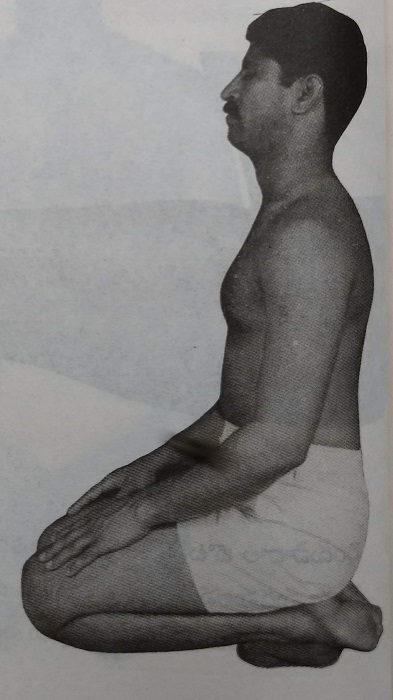
Important things: 1. Let us see why we need to keep the blanket under the two feet. When we sit in vajrasana, our weight – 60-70% will be on these legs. The leg might not have stretched earlier like that and it will pain if you stretch it now. As we are not habituated to the weight and the stretching, within 2-3 minutes of the vajrasana, we feel like coming out of it. Some people feel it after 5-6 minutes. To stay in the vajrasana for more time, and to avoid pain, fold the thin blanket and keep it under the legs so that the pain alleviates.
2. Those who do not have the experience of doing it, cannot sit in it for a long time. In 5-10 minutes, there will be pains, numbness. Then, they will take out vajrasan. Till you get habituated, you need to increase the time gradually.
The asana state: Stretching the hands, keeping the back straight, closing the eyes completely, keeping the mind on breathing, we can sit without any thoughts running. In this asana, there are no tiredness and shortness of breath. As you sit in the asana, and the back is straight, a good connection happens between nervous system and mind and the nerve flow happens smoothly, from up and down. The mind becomes peaceful, without any thoughts. If we keep the back straight, the lungs will be wide. Then, the lungs will be filled up with air. So, throughout the vajrasan, the breathing happens deep and long. As a result, more oxygen is supplied to the body and mind and the mind is detached from thoughts and becomes more peaceful. Such mental changes can be achieved without any practice in this vajrasan. As long as you are in vajrasan, you will get good amount of oxygen to the body. So, the body gets more energy in the asana, and we will lose all tiredness. As long as you don’t feel pain in the legs, you will continue in vajrasan. As our weight is on the folded knees, the blood vessels in the legs will be closed. So, the blood doesn’t go to the legs and stops above the knee part. The legs will feel numbness. We should ignore the pain and can stay in the asana for more time. By practicing the asana, you can stay in it for atleast 20-30 minutes. What is important in this asana state is to keep the mind focussed on the breaths. When we know, we cannot continue the asana, we can stretch the legs and sit in the rest asana.
The rest state: In vajrasana, the legs can be widely stretched, and keep them hanged sideways. Keep the hands on the back side, and hand the neck backside. This way, the body will be free.
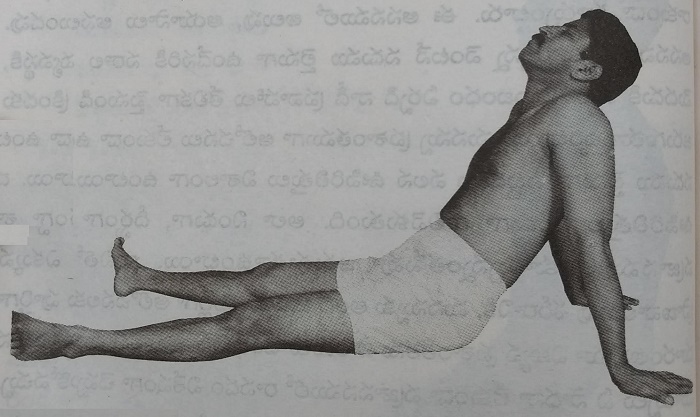
In this rest period, we focus on the breathing and try to be peaceful. Since the time we stretch the legs, the numbness pain disturbs the mind. The legs will be paining more. It is torturing. We cannot cry or we cannot laugh. In the middle stage, there are pains in legs. During this time, the mind doesn’t focus on the breathing. The mind’s focus will be on the legs and feet. After taking out vajrasana, for 1-2 minutes, the numbness increases more and then, from there, it reduces gradually. The blood circulation starts flowing fast and the feet become red. As long as you are in vajrasan, the feet will become white. In the rest state, when the legs are stretched, all the blood which remained in the top part of the knees, will flow down to the feet as soon as the vajrasan is taken out. The huge amount of blood reaches the feet. That’s why, the feet look red rose color. Till this blood circulation becomes normal, you should be in vajrasan. During vajrasana, the benefit is from knees to the upper part, in the rest state, the benefit is from knees to the feet. To get this profit in the rest time, you need to sit sit 4-5 minutes, with stretched legs. Like this, you need to take complete rest.
Wrong state: If you keep the back straight 90 degrees and sit, it is called vajrasan. Some people cannot keep the back straight and bend it forward. Some people bend their neck as well. we should not bend the back. It is wrong.
You should not sit as shown in the image. If you bend the back forward, the diaphragm expands and stays like that. As a result, the lungs close half part. Oxygen cannot be inhaled properly. Number of breaths increases. If you bend back, the relation between mind and the nerves won’t be smooth. The number of breaths increases. As a result, the mind won’t be peaceful. So, there won’t be any benefits in vajrasana. So, whenever you sit in vajrasan, you should not bend your back forward and to sit for a longer time. If there is back pain, you have to take out the aasana, but you should not bend.
Benefits
1. To do pranayama, vajrasan supports a lot. As the back is straight, we can inhale and exhale air well. As the chest is wide, the air enters lungs full. To do any kind of pranayama, we can do in vajrasan. It gives good results.
2. For meditators, vajrasan gives a lot of peace of mind. When we sit in vajrasana, the mind becomes fixed and thoughts don’t wander. With this asana, if the state of mind is changed, you can do meditation with more result. In meditation, the back to be straight. It is very important.
3. It is said that no asana is to be done after meals. But, you can do vajrasana even after meals. As soon as meals is done, if this asana is done, the food gets digested fast. Especially, as the back is straight, the oxygen is filled up in the lungs. Because of this, the oxygen is pumped well and digestion will happen actively. If the back is straight, the weight of the stomach doesn’t affect the diaphragm. Because of this, breathing doesn’t have problem. If vajrasana is done after meals, there won’t be stomach heaviness. For this, the back is straight. If you sit in vajrasana, all the gases in intestines and stomach come out and the stomach doesn’t feel heavy.
4. Vajrasan can be done in temples, pujas, at meals. The mind will co-operate with these tasks.
5. Whenever the mind is not well, or when it is irritable, or when the thoughts are wandering more, or the sleep is insufficient, you can sit, with focus on the breathing, for 5-10 minutes, you can come out of the inconveniences. This will help a lot.
6. With vajrasana, for both the legs, the blood circulation happens and the health of the legs is protected. There won’t be any numbness of feet, pain in legs, pain in souls. All these inconveniences will be gone.
7. Those who do not have any knee pain, if they do this asana, the joints will be in control. The knee joint pains will be reduced.
8. Hunger will increase. To decrease indigestion, every day, do vajrasana two times. You will have good result.
9. If you have problems such as bloated stomach, gas formation, weight of stomach, you can sit in vajrasana in 10 minutes, and gas goes out through belching and the stomach feels relieved.
10. Those who have back pains, if there are needed to sit on the floor, if they sit with legs folded, the pains will increase. If you are to sit on the floor, if you sit in vajrasan, if yu sit in vajrasa, there won’t be any back pain problems.
Note
1. Vajrasana need not be done along with other asanas. You can do it when you do pranayama, or meditation or when you are free or after you meal so that you can save your time. You will get profit as well. Bfore doing asanas, you can do this when you do pranayama.
2. Those who have severe knee pains, should not do vajrasan.
3. You won’t get result if you do it and take it off immediately. You will get good results of it only when you stay in the asanas for more time.
1. To do pranayama, vajrasan supports a lot. As the back is straight, we can inhale and exhale air well. As the chest is wide, the air enters lungs full. To do any kind of pranayama, we can do in vajrasan. It gives good results.
Matsyasan
This asanas is created by matsyendra maharshi. Whoever masters this asana, can float on the water like a fish. That's why the name is given to this asana.
Method of doing: When doing this asana, we need to move to the front part of the blanket.
1. Those who can bend thier legs well, have to sit in padmasana first. For many people, padmasana is a difficult thing. Don't think that if you cannot do padmasan, you are not eligible to do this asana. Those who cannot do padmaan, can do it by moving legs closer, in sukhaasan.
2. Then, keep one hand on the floor till the elbow bend the chest backwards.
3. Then, you keep ther other hand also similarly on to the other side..
4. You stretch both the hands towards legs and bend backwards by touching the back to the floor.
5. Keep both the palms on the thighs, press both the elbows on the floor, bend the body from the waist or chest part, bending the back backwards, pushing the head backwards, and try to touch the middle part of the head to the ground. Those who cannot do padmasan, can do it in sukhasan as shown in the image.
6. To close the eyes completely.
Asana state: Do the complete asana state as shown in the image, ensure that no thoughts are running on the mind and keep the mind focussed on the neck and throat part. You can stay in the asana as long as possible. When there is more pain and when you no longer can do it, you can come out of the asana. When you are coming out of the asana, place the head and chest part to the ground, then keep the hands to the sides free and then stretch the legs. Those who are in padmasan, can keep the legs like that. Then, to get up slowly, bend forward and be ready for the asna.
Second type of asana: This matsyasan can also be done in another way. Those who cannot fold legs can do this easily. What you find it easy, you can do it. If you do padmasan, your legs will be in control. So, you can do it that way. The remaining people can do like this.
Method of doing
1. Move so that you can keep the head on the blanket, lie down with face upward, keep both the hands, with palms touching the ground, and move the palms behind the buttocks and keep the legs stretched.
2. Keep both the legs and palms like that, and push the chest and head upward from the elbow part.
3. Then, bend the chest part backwards, and place the head middle part touching the ground. In this state, neighter the waist nor the back doesn't touch the floor. All the weight will be on the head.
4. You need to stay in the asana as long as possible with eyes closed.
Wrong state: Especially, in this asana, the neck and throat parts get more benefits. So, in this asana, you can bend the neck part completely backwards, and put the centre part of the head (maadu) touching the floor. Otherwise, there will be no use. You may do all the asana well, and it looks fine. But, if you do not do the main thing correctly, you will miss the benefits of the asana. Look at the wrong postures in these two types of asanas. All the remaining asana is generally done well.
The chest part is uplifted. But, in terms of the head, the centre part of the head is not touching the floor. Instead the back part of the head is touching the floor. That's why, the neck part is not pushed backward.
In this asana, the hands are not coming under the chest and are placed sideways. As a result, the waist is not pushed upward. That’s why, the centre part of the head is not touching the floor – the neck part is touching the floor. If the back and neck do not bend like that, then there won’t be any benefits. We need to observe such mistakes and rectify the asanas.
Benefits
1. For those who have thyroid problems, this asana is very good. As long as you stay in this asana, the thyroid gland gets contracted and stretched. As a result, more blood circulation and oxygen flow happens to the thyroid gland, which generally doesn’t happen. As a result, the functioning of the gland changes. The blood flow happens well to the thyroid gland. With this asana, it happens like massaging in the inner parts of the gland.
2. Just behind the thyroid gland, there are parathyroid glands. When you are in this asana, the energy glow will be on these glands. Generally, para thyroid glands streamline the calcium in the body. For muscles, and for the heart contraction and expansion, this is the most important activity. That’s why, in this asana, the blood circulation happens well to these glands and the bones gets strong and get established.
3. For thyroid gland, it swells due to the deficiency of iodine. If you give iodine either through food or through medicine and do matsyasana daily, these swelling will be controlled.
4. These days, many people, including kids, are facing the thyroid problem. If you do this asana as a precautionary step, the functioning of the gland doesn’t get affected and it protects health.
5. These days, employees and business people are facing neck pains and are feeling inconvenient. In some people, the nerves in the neck are pressed and they are going or surgery as well. For people who have spondylitis, this asana is very much useful. This pain is more for people who sit while bending their head. In this asana, as we band the neck backward, we get good relief. Apart from neck pain, if you have back pain, it is better to do matsyasan lying down, instead of sitting down. Those who have neck pains, have to do this asana twice a day. If required, you need to do it once, take it out and do it again once more.
6. For those who haven’t faced neck pain so far, will not face in the future – especially for employees and business people as a precautionary step. Otherwise, in future, you cannot use a pillow (after the neck pain starts, you have to completely stop using pillow). For some people, when driving a bike and for some women when cutting vegetables, they may feel pain. To remove such pains completely, this asana is most useful.
7. The muscles and blood vessels at the neck part become healthy. Because of this, the blood is pumped well to the head. It prevents piling up of fat in the blood vessels that carry blood to the head.
8. Those who have back pain, by bending the back backwards in this asana, as nerves are pressed, some comfort is given.
9. This asana helps the tonsils of the throat – at both the sides. The tonsils get strengthened and immunity is improved and infections are prevented.
10. The chest part will be stretched during this asana. As a result, for the side bones, and the muscles, lungs in the middle, contraction and expansion happen more. After the asana is taken out, deep breathing happens. This asana helps to happen deep breathing after that.
Note
1. As we bend neck and back backwards, and when you bend them forward again, it comes to the natural state. After this, we need to do the asana in which the body bends forward.
2. Those who have neck pain and back pain, after doing this asana, should not bend forward. Should not do asanas where you bend forward.
3. When learning for the first time, you should not stay in the asana for more than 10-15 seconds. As you are not habituated to it, in the first 5-6 days, if you do it more, in the 2nd and 3rd day, the neck pains attack. After 5-6 days, you can stay as long as you can.
4. If you feel neck pain, you can apply coconut oil to the neck and you can apply hot water two time, then you get relief.
5. Many people do matsyasan after paschimottasan. If you do like that, there are more results. If you start with easy asanas and then do difficult asanas, then, there will be greater results. In the asanas we are going to do, the lighter asanas such as matsyasan, yogamudrasan to be done first.
6. After taking out matsyasan, instead of taking rest, if you do yoga mudrasan, it is good.
Yogamudrasan
This is one of the mudras as part of hatha yoga. You can raise kundalini with yoga energy, gather mental faculties. That’s why, it is called yoga mudra. Though for not that benefit, you can do it for other benefits.
Method of doing: If you sit in padmasan and do matyasan, then without removing padmasan, you can do this matsyasan. If there are more pains, after matsyasan is completed, you can take out padmasan and then can do this asana again. After doing padmasan once, it is good not to take out these two asanas. Because, from knees to the feet, as we sat in padmasana, the blood circulation is stopped and slowly the numbness is formed. For these two asanas to be done, for 4-5 minutes, you need to be in padmasan. During this time, the blood circulation in the legs is stopped and when you come out of this asana and stretch the legs, the blood flow increases more.
1. Move to the middle of the blanket, sit in padmasan, place both the hands behind the back, close the fist, to hold the fist with another hand, to hold both the hands to the chest, to bend the head so that chin touches the chest. Those who are not able to do padmasan, they can sit in sukhasan and do as described above.
2. To close eyes completely, to bend the back forward, to exhale air from lungs through two nostrils, and bend the head to touch the ground. By the time we touch the head to the ground, the exhalation should be completed. The centre part of the head to be touched to the ground, the chin part to touch the chest and to remain in the asana for some time.
Asana state: After yogamudrasana is done, that is, after the centre part of the head touches the ground, without breathing air, you hold it. Till you feel like inhaling, hold the breath like that and focus on the throat part. Once you want to inhale, move the head, take air gradually and push the chest up and sit.
Rest state: To take out the legs from padmasan, stretch the legs completely, place the hands backside, push the neck backwards, keep the mind peaceful, close the eyes, and focus the mind on the breathing. You can know the movement of breathing, just above the upper lip and at the bottom of the nose. In the rest time, it is better to stay in a minute there.
Other methods: If it is difficult to do as described above, you can do it as it is given here. For obese people, this method will be easier.
1. Sit in sukhasan, lift both the hands straight, towards the sky, exhale the air and touch the hands, head to the ground. Ensure that the chin touches the chest. All this time, without inhaling, hold the air and when moving up, you inhale. For some people, the hands touch the ground but the head doesn’t touch it. Don’t think that the aasana is not done well. Where you feel the pain, there you get the result. Take the result what you get.
2. You can do it sitting in vajrasana. For some people, if it is conveneient, you can do it that way. Be in the asana state as descrived above.
The wrong state: In every asana, somebody will be there to make some mistake. In yogamudrasan, when you bend forward, to get benefits to the stomach muscles, and intestines, when bending the back forward, ensure that the buttocks are not moved up and they are keep touching the ground, and to bend the back and head. You should not do as it is shown in the image. If you do like that, the effect will be reduced.
Benefits
1. Just after you take out matsyasan, if you do this asana, the expanded thyroid, parathyroid glands will be contracted. When two types of movements happen to the same organ, the blood circulation happens better. The cells in the glands will be squeezed. As a result, the glands and their cells receive so much energy and oxygen.
2. As long as you stay in the asana, as you hold the breath, the lungs get contracted and get the energy to fold. When you take the asana out, you can take deep breaths. As a result, deep breathing happens. If we take deep breathing, our energy gets improved.
3. In this asana, as bend forward and hold the breath, the stomach muscles, intestines feel pressed and the stored fat gets melted. As a result, the stomach gets diluted. Also, the intestines get more energy.
4. Those who have thyroid problems, along with the matsyasan, this asana also helps in making the glands better, and reduces the necessity of thyroid medicine.
5. Children whose development is stopped, if they do matsyasan and yogamudrasan together, their thyroid gland works well and increases hormones and helps to grow well.
Note
1. If you do this asana for once, that is enough. As it is easy, people want to do it multiple times. You need not to do like that.
2. In this asana, by holding the breath, there is a chance that thyroid gland and throat area can be folded. Especially, for this purpose, we are holding the breath here. We hold the breath in this breath, but we never do it in any asana.
3. Those who are not doing matsyasan, need not do this asana as well. To get good result, in this asana, we bend forward.
4. For many people, they can stay for a long time in this asana. That’s why, if we hold the breath, everyone can take it out in 20-25 seconds. This time enough for this result.
5. People who have problems such as neck pain, back pain, sciatica pain etc. should not do this asana.
Vakrasan
As we twist the backbone in this asana, it is called vakrasan..
Method of doing: Vakrasan needs to be done two sides. One time, you have to turn to your right completely and the next time, you have to turn it to the left side. Let us first see turning to the left side.
To the left side
1. In the middle of the blanket, stretch the legs straight, place both the hands on the back side, touching the floor and to sit. Now, stretch the right leg straight, and fold the left leg up and move the feet to the knee.
2. Now, stretch the right hand on the top of left knee. Do not stir the left leg hither and thither and hold it still. This leg should not bend to any side.
3. With the stretched right hand, push the left leg and turn the waist and neck completely to the left side. When you turn like this, the right shoulder and the left shoulder should come into one line. While turning it like this. Close the eyes completely.
Asana State: In this asana, turn the waist completely to the left side, with peaceful mind, focus on the pain that comes in the waist part. As long as you stay in the asana, you will not move hands and legs and stay in the meditative state. The more time you can stay in this state, the better it will be. Once the pain in the waist part, in the sides of the stomach, is unbearable, you have to take out the aasana. As long as you stay in the asana, if you twist the stomach, the respiration does not move till the end of the lungs. Breathing happens in the top part of the chest. That’s why, in this asasa, one may feel shortness of breath. For those who are obese, this will be more. It is better not to try beyond their capacity.
Rest state: While taking out the asana, close your eyes, turn the neck to the front to align, to keep the right hand on the back side of the waist, bend the neck back, sit in sukhasana freely. Now, the respiration, happens deep and slow. Now, focus the mind on the breathing and ensure that you have no thoughts.
Once you take out the asana, you can see feel the blood flowing to the sides of the waist. Wherever you feel pain in the asana, to those parts, more blood is pumped. In that way, the blood circulation happens and to get more results in the asana, for 1-2 minutes, you need to be peaceful in that aasana. Once the breathing comes to the normal stage, do the vakrasan where you turn to the right side. Now, let us do it.
To the right side: Now, stretch the left leg straight without falling down, fold the right leg, and move the right feet to the left knee. Now, stretch the left hand on top of the right knee. Ensure that the right let is not moving here and there and is unstirred. With the stretched left had, push the right leg and turn the waist and neck toe the right side. Close the eyes completely and as you did for the left side, you need to sit in the asana constantly with focussed mind. After taking out this asana, sit in the sukhasana again, and take rest.
Complete state: Once you are habituated to this asana, you bend the knee, make the foot touch the buttock and move it closed to the foot. By moving the leg closed to the buttock, the stomach muscles, waist muscles are more pressed. As a result, the breathing comes down to a great extent. It will be difficult to stay like this for more time. You can gradually, move the leg slowly up like that. Those who are learning new, should do like earlier.
Another method: This method is given to those who are obese, who have big thighs, who have big belly and round shoulders. The result given by turning the waist will be same for thin people as well as for obese people. As these obese people turn slightly, their stomach muscles, waist muscles get contracted. For these people, the result will be better. They should not get disappointment and they have to do it confidently.
Stretch the left leg straight. If the stretched leg is not comes down, the waist will be strong. Fold the right leg up, move the fee to the left leg calf (instead of knee). For obese people not to get shortness of breath, it is okay to keep the leg a bit aside. Then, keep the left hand on the right knee, and push the foot and turn the neck and waist as far as possible. For these people, the two shoulders do not come in line. But, still, it is not a problem. You can keep the hand and leg as shown in the image or they can keep as per their convenience and try to do this asana. The waist part and the stomach part of these obese people, get twisted, and as long as they stay in the asana, it is painful for them. Some people will come out of this asana, quickly. As long as you don’t feel problem for breathing, you can stay in the asana. After that, you can come out of the asana and take rest in sukhasan for more time.
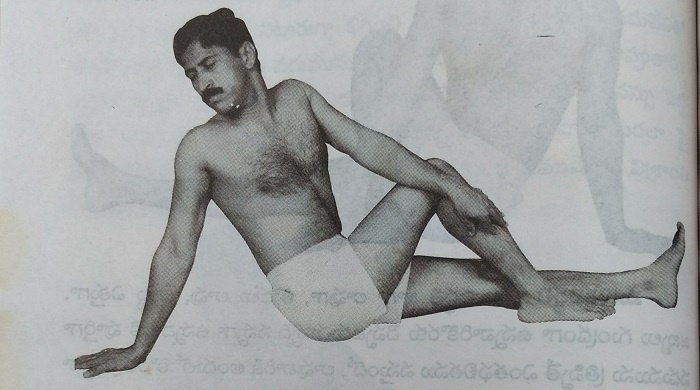
Wrong state: In vakrasana, many people do more mistakes. By doing mistakes in the asana, the backbone doesn’t turn sideways completely. In the stomach muscles, waist muscles, there won’t be any tightness. In the asana, if you don’t feel tight, or if you don’t feel pain in the side parts, and if you don’t feel for the need of the air, then it is a mistake in the asana.
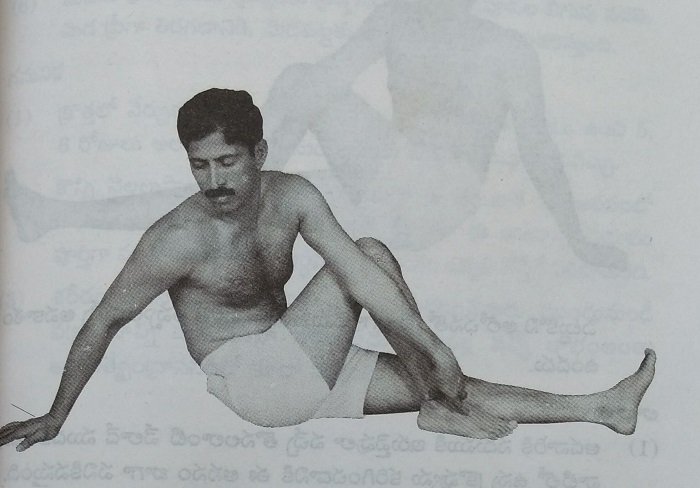
1. If you observe the asana in image, the left leg is slanted sideways. Here, as the right leg is not pushed with left hand properly. The waist is turned to the right side only half part. The shoulders should be aligned, but they are not. As the waist is not properly turned, the right hand should be aligned to the left line, is now in the right side. If you do like this, it will be pleasant in the asana. It will look okay. We don’t see any fault. It doesn’t matter how long they are in the asana. They don’t feel inconvenience. In the asana, waist and backbone, stomach muscles are twisted well, the breathing happens well. If everyone observes and do the asana properly, such mistakes don’t happen.
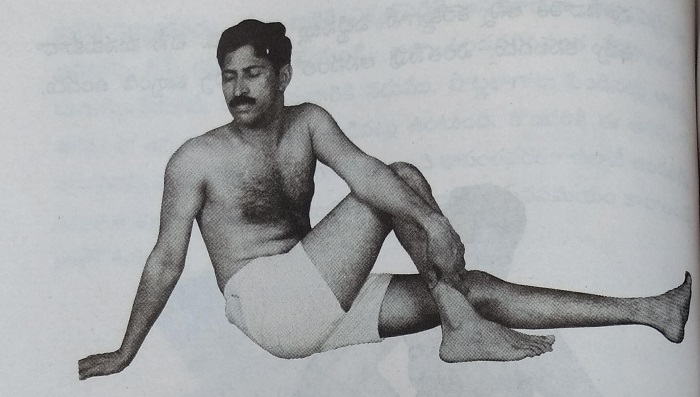
2. In this asana, the left leg is slanted completely. The rest of the body looks twisted well. Do you think there is no mistake in this posture? The main mistake in this asana is: all the body is placed on the left buttock and the right buttock is moved up in the air. If it sis slanted like this, the waist and the stomach areas are not tightened. The blood circulation doesn’t stop in the areas where it needs to stop. With that, we won’t get good results. So, while twisting the waist sideways, if you sit straight and twist it, it won’t happen like this. Everyone should focus well while doing asanas, such kind of mistakes can be avoided.
Benefits
1. The side folds of woman’s waist and the fat in them can be melted with this asana.
2. As the waist part is twisted well and tightened. When you do this asana, wherever you feel more pain, in that area, the fat is melted and the waist becomes thin. For many people, more fat accumulates in this area. With this asana, this is the best results people get.
3. The movements between muscles and back bone, will be good when we are in this asana, when we twist the waist. As a result, because of this asana, we don’t feel spasms of nerves and muscles when we bed the waist while doing tasks.
4. For the muscles which are two sides in the back bone, the blood circulation happens well. From the neck to the end of the back bone, every part of the back bone will be twisted well. As a result, the backbone becomes very strong.
5. For people who do not have any fat to the sides, because of this asana, the waist part will be tightened.
6. By bending the neck two sides, the neck becomes loose and can move freely, and there won’t be any problem of contractions in the neck.
Note
1. When you learn this asana for the first time, do it for 10-15 seconds and afte 5-6 days, you can stay in the asana as long as you like.
2. After you do this asana for some months, after that, if you do not feel any inconvenience or pain, stop this asanan and then in its place, do ardhamatsendrasan. That will be enough.
3. For whom the body is co-operative, they can stop doing vakrasan, because all the benefits that we gt from vakrasan, we can get from ardhamatsyasan.
Ardhamatsyasan
This asana is designed by matsyendra yogi. That’s why, it is called Ardhamatsyendrasan. In the nature, animals, after getting up from sleep, to get rid of laziness, move the backbone, to front, back and sides in different ways, and makes the body easy moving. It is a natural activity, as the animals shake the back bone to create energy movement in the body. Similarly, with this asana, many kinds of movements happen in our body and it is useful to the body.
Method of doing: In ardhamatsyendriyasan also, we need to do on two sides seperately, as in vakrasan. Let us first see the right side part.
To the right side
1. Sits in the middle part of the blanket, stretch two legs completely, place the hands behind the back and touch the floor. Then, bend the left leg, keep the heel between the two buttocks, and sit on the left leg foot. Then, fold the right leg, lift it up, over the thigh, place the feet on the floor.
2. Now, bring the left hand over the right leg knee (as in vakrasan), and to touch the left knee cap.
3. Make that the right leg to go into the left hand armpit position, pushing it like that, twist the waist and neck to the right side, to remove the right hand from the floor, keep it on the waist, to hold the body on the left leg, like that. Keep the eyes closed.
Asana state: Once you reach the main state in the asana, focus the mind below the stomach, on the sides of the waist, and try to stay in that position without falling off. As you place right hand on the waist, if you are falling off from the asana, till you get habituated, intermittently, you can keep the palm on the floor. When you want to come out of the asana, first, bring the back side hand to front first, and while closing the eyes, turn the neck into the front, and to come out of the asana slowly.
Rest state: Once you take out the ardhamatsyendriyasana, close the eyes, stretch two legs freely, place the hand behind the chest on the floor, bend the neck backward, and stay in the sukahsana for 1 to 2 minutes, with focus on the breathing. Till the breathing comes to normal, after the tiredness comes down, you nee to be at rest. Then, to do the asana in the next side.
To the left side
1. Sits in the middle part of the blanket, stretch two legs completely, place the hands behind the back and touch the floor. Then, bend the right leg, keep the heel between the two buttocks, and sit on the right leg foot. Then, fold the left leg, lift it up, over the thigh, place the feet on the floor.
2. Now, bring the right hand over the left leg knee, and hold right knee cap.
3. Make that the left leg to go into the right hand armpit position, pushing it like that, twist the waist and neck to the left side, to remove the left hand from the floor, keep it on the waist, to hold the body on the right leg, like that. Keep the eyes closed. Do just as we did above and stay in the asana as long as possible and then to stay in the rest asana for 1-2 minutes.
Another method: For those whose thighs are heavy and the stomach is big, the body doesn't co-operate to do this asana. If there is not much difficulty, with some changes, one can do like this.
Method of doing: Instead of folding the left leg and placing it under the buttock, move it to the side of the buttock, fold the right leg and make stand to the left knee, pushing the right leg, and as it is difficult to hold the left knee with the left hand, stretch the has as far as it is reachable, and pushing the right leg with left hand, and to twist the waist and neck to the side ways, and place the right hand to the ground or to hold on the top of the waist. Especially, if you do some changes in the hands and legs, if you are able to twist the waist and neck well, it is beneficial. Like this, you can do two sides and to stay as long as possible.
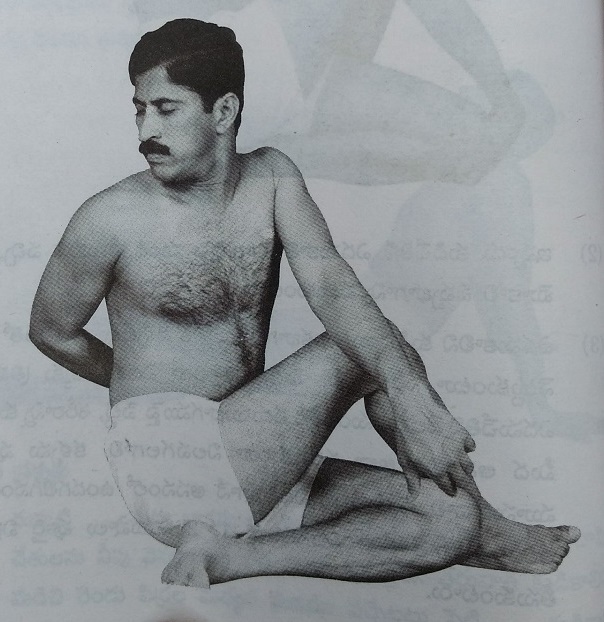
Wrong state: It is fine to keep hands and legs. But, here, it is like sitting free. It means, we are not able to move the waist. To move the waist well to the side ways, to push the leg with the hand and to twist. To push like that and bend the waist and twist it, you will get good results. If you don’t do this asana well, the respiration will be normal. In the same asana, if you twist the waist well, the breathing happens heavily, compared to vakrasan. In that way, you can get good results in the asana. In this asana, if you don’t feel any pain and is easy to do and lighter, then there is something wrong in this asana. If you feel like this, you need to do the asana again, by twisting well. But, don’t skip the asana hastily.
Benefits
1. Compared to vakrasan, this aasan is more difficult to do. As we fold the two legs in this asana by folding tightly, especially, fat melts away in the hip area. This result is not found in vakrasan. In most of the people, fat is more accumulated in the hip area and the blood circulation happens less. When we do this asana, more pain is experienced in the hip area. As long as you are in the asana, the blood circulation gets stopped in this area and once you enter the rest period, the blood circulation happens more and it is good for that body part.
2. As we fold the two legs and twist them to the sideways, the stomach and intestines get massage.
3. Especially, in this aasan, as we fold the legs and twist to the side ways, the pancreases gland (which produces insulin – when this doesn’t function well, we face sugar problem) will feel more pressure and the gland experiences more expansion and contraction. As a result, the performance of the gland improves and the capability to produce hormones increases. For diabetic patients, this asana is good. Those who do not have sugar, can do this asana as a precautionary step.
4. Because of the movements that this asana creates in the body parts under the navel, more energy is supplied to these parts and there won’t be other problems in the future such as hernia, hydrocele, prostate gland problems
5. With this asana, the fat that is in the two sides of the waist, can be melted and the waist becomes thinner. It is a good asana to make those parts thinner.
6. The nerves which come from inside the backbone, and from outside the backbone, will be well activated and get more energy.
7. Generally, we don’t move the waist sideways to back side. As a result, the back bone is very tight. Similarly, all the muscles around the back bone are also very tight. As we twist the waist two sideways, all the backbone parts and the muscles get freed up, and gives us comfort when we bend or move the body freely.
8. By doing ardhamatsyendrasan everyday, the backbone disks (the sponge like flesh) will be placed in the exact position and protects the nerves and the whole backbone. As a result, there won’t be any problems related to back bone in the future.
Note
1. Those who have back pain and sciatica pain should not do this asana.
2. When you are doing it for the first time, initially, better to practice vakrasan for 10-20 days and then, to do this asana. Obese people and people who have other problems can do the practice gradually.
3. In this asana, especially, people twist the waist to one side, when they are supposed to twist it to the other. It doesn't give any result. To ensure there are no mistakes, if you keep the right leg standing, left hand should be on it. If you keep the left leg standing, the rigth hand should be on it.
4. Obese people, people who have heavy thighs, those who have heavy belly - who cannot do this asana, should not be worried. All the benefits of this asana can be acquired from vakrasana. Till you get this asana, you can do vakrasan.
Gomukhasan
As the knees are placed one on top of another in this asana, it looks like the face of a cow. That's why, it is called gomukhasan.
Method of doing: This asan is also to be done twice - to the right side once and to the left side once. Let us first do to the right side.
To the right side
1. Stretch the two leg straight and sit. First, to fold the right leg closely, to place the right foot to the side of the left buttock. Then, fold the left leg, hold the foot with two hands, pull it over the right thigh and to move it to the side of the right buttock. Pull both the legs so that both the knees are closely together.
2. To place the right hand to the back, just as cleaning the back, and push it to the top, as far as possible. Then, keep the left hand adjacent to the ear, to look at the sky, and to lift it up. Now, bend the left hand till the elbow and place it on the back. Now, try to hole the two hands’ fingers together. To close the eyes while holding the fingers like that. Ensure that the left hand is looking at the sky in line. The neck and the waist should be straight.
Asana state: To pull both the hands closely together, and to see that the gomukhasan is 90 degress, and to focus the mind on the right hand shoulder, and to stay in the asana like that. You will feel pain in the right shoulder as squeezed. Try to bear the pain as long as possible. When you cannot do it anymore, leave the hands, and initially bring the top hand down slowly and then to lift the bottom hand slowly upside. Then, stretch the left leg forward, and then bring out the right hand and stretch both the hands.
Rest state: To stretch both the legs freely, to place both the palms onto the ground, pull the neck back freely, and take rest in the sukhasana. To focus on the breaths and to stay peacefully for a minute. During this rest time, in the asana, the blood circulation that was stopped earlier, starts again and the parts which experience pain during the asana time, are now supplied with more blood. If we don’t give rest like this, we don’t get the result. You need to wait till we get to the normal stage after shoulder pain, numbness of the hands and legs are alleviated. If you need, take more rest time.
To the left side: Now, put the left leg down and put the right leg on top. Similarly, bring the left hand to the back, to bring the right hand to the back side from top. To hold together both the hand, and to follow all rules as discussed before. Once done, to come out of this asana and to take rest for 1-2 minutes.
Other methods: For those who have heavy thighs, or for people who are obese, whose sides are heavy, it is difficult to sit by placing the legs lie that. But, you should not stop the asana. To get the benefits of hands in the gomukha asana, we can keep the legs at our comfort and do the asana. Those who cannot sit on the floor, who have problem in the back, can sit on the stool straight, and keep the hands as shown here and do the asana. However, we sit, the concept is to keep the waist straight. If we sit in the gomukhasan, as we are supposed to sit, we will get good results to the egs just as we get good results to the hands. If not, if we sit as we are going to tell, the hands will get the results but the legs don’t get any results. You can do three types, in the sitting posture.
1. In vajrasana: To fold the two legs back side, and to place both the feet under the buttocks in the sitting posture, can hold the hand from top and bottom like this.
2. In ardhagomukhasan: The leg that we keep in the bottom, can be bent well, but the top leg cannot be bent because of the heavy thighs or joints. Though you cannot be complete gomukhasan, you can do this as shown in this image. If you are able to get like that, you can get more benefits than in vajrasan and sukhasan. So, if you cannot do gomukhasan, can try this asan first, and if you cannnot do it, can try it another way. If you do ardhagomukhasan, the waist should be straight.
3. IN sukhasan: There are people who cannot do vajrasan or ardha gomukhasan. Those people can do this asana sitting.
For some people, because of diseases, for others because of joint pains, the hands won’t reach. Though, hands won’t touch, it is good to stretch as far as possible. If you want to try to touch, in the top hand, hold the hand kerchief, and hang it backwards, and hold it with the bottom hand, and move the hands with the help of the kerchief. When one is doing it, if hands are not reachable, another person who knows the aanas, can help in getting the hands touch. Though the hands cannot reach perfectly, when you do the asana, if the pains are more, you will get more results. Don’t be worried.
Wrong state:
Even is such a simple gomukhasan, people make some or the other mistakes, and get less results. Especially, the major mistake is: not keeping the top hand towards the sky. For all the people, the top hand goes well. They push the hand to some distance and then stop it there. You have to still try more distance and ensure they are in line. Similarly, you have to push the bottom hand towards the top. But, if you do it casually, then, you won’t get the results. If you bend the back forward, the hands won’t be tight, and you won’t get the results. However long you stay, hands will be at comfort. In the image, the neck and the hand both are bent forward. By not holding the bottom hand, the back is bent forward. Compare this with other asanas which are done well. You will know how free it is. If you do as shown in this image, there won’t be any benefit.
Benefits
1. Especially, because of this asana, for those who have heavy shoulders, the fat gets melted and makes them beautiful. As there are no other ways for shoulders to reduce weight, they will be piling up fat. People having such problems can do this asana twice a day.
2. As people grow old, they will have pains in the joints. With this asana, in the shoulder joints movement happens and stickiness gets produced and the pains will be reduced. Doing this asana gives relief from the shoulder pain.
3. For many people, the hands get numbness, nerves pain etc. will be troubling. These problems won’t be alleviated even if you use many medicine. These problems occur because of the changes that happen in the nerves of the shoulders. As doing this asana, during the asana, for the bottom hand, the blood circulation stops completely, and when the asana is taken out, the blood flows from the top to the fingers of the hand. As a result, the numbness will be reduced. Similarly, when we pull the hands forcefully, the nerve movements happen and they will become free. As a result, the hand fingers get good grip.
4. With this asana, from top and bottom, as we press the hands and hold tightly, for the bottom shoulder, the muscles get squeezed, and they lose stiffness and move freely. As a result, both the hands can move to top and back.
5. As you do this asana daily, movements in the hand increases. You can clean your back while taking bath satisfactorily and can wear shirts easily.
6. People with any diseases can do this asana. During menstruation time, women can sit in sukhasan or vajrasan.
7. This asana looks like the cow sitting. By practicing this asana daily, the joints in the knees will be in our control. In the future, you will not face arthritis, pain in the joints etc.
8. Once you are habituated to this asana, if you go for any spiritual discourses or temples, you can sit there in the gomukha state and keep the mind peaceful. For this asana to be done, you don’t need any soft blankets. You can sit anywhere. So many of our elders sit in this asana even now.
9. If you sit in gomukha asana for 10-15 minutes, without moving the legs (without holding hands), once you come out of the asana, the blood flows from legs to the feet, which helps in reducing inflammation and numbness of the feet.
10. In gomukhasana, by sitting with two knees keeping together, in the hip area, the fat gets melted and blood circulation happens well to that area.
11. People who have mental tentions, can become peaceful by doing gomukhasana. After coming out of gomukhasana, you will inhale more oxygen.
Note
1. For some people, in this asana, the left hand doesn’t move just as the right hand moves. Similarly, the right hand doesn’t move just as the left hand moves. At one stage, both the hands meet. But, some feel that the hands are not touched. In the beginning, it is the common problems faced by everyone. We generally use one hand to wash the back, to wear clothes, to scratch. Such hand will go up and meet the top hand. Unused hand won’t go back enough. As a result, it won’t tough the top hand. If you practice it well, both the hnads meet.
2. Initially, people do this asana for 4-5 days and then come out of it. Then, they try to stay for more time.
3. You should not do forceful efforts to touch the hands or push the hands, which may cause pain in nerves. So, you should not do like that.
4. May people get confused about placing hands and legs, top or bottom. If you remember this, you won’t feel any pain. You can blindly remember that, if the right leg is down, the right hand should be on top; and if the left leg is down, the left hand should be on top.
5. As you do this asaan continuously, when you touch both the hands at the back side, and hold for 2-3 minutes and if you don’t feel pain, you can stop this asana and use the time to do other asana.
Supta vajrasan
Supta means sleeping. Supta vajrasan means doing vajrasan in the sleeping posture.
Method of doing
1. Move to the front part of the blanket, do vajrasan, place the left palm, at the left feet fingers, as shown in the image, and to bend left side, and to touch the left knee to the ground.
2. Place the right palm at the right feet fingers, bend the body to the right side slowly, and to make the right knee to touch the floor.
3. Then, lift the two knees up gradually, to bend backwards and to touch the centre of the head to the ground.
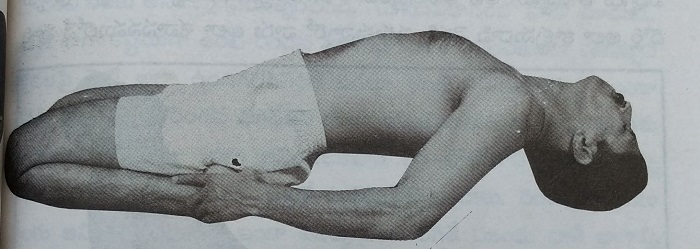
4. This time, make the complete back, legs, hands and head touch the ground and to bend the back downwards and to lie down. The waist part won’t touch the floor. To close the eyes completely.
Asana state: In the asana, lie down at rest, make the mind thought-less, and focus on the thighs. To focus on the thigh parts and focus from the knee part to the upper thigh part. You can stay in the asana as far as possible, and when you cannot bear the pain, to hold the legs with hands, pushing the elbows to the floor, push the head and chest part to move to one side, and to get up and sit in vajrasan. Those who are obese or who have a lot of weight, cannot do as descried above. Such people to move from the supta vajrasan, stretch the legs, and lie down to the back.
Rest state:
It is very difficult staying in this asana. You will feel like coming out of the asana as early as possible. Those who move out of the asana, stretch the legs and lie back, they will take rest in the shavasana. Some people, come back just as they do the asana, sit back in vajrasa, will take rest in the sukhasana. As soon as you do rest asanas, close your eyes and focus your mind on the breathing and get relaxed. Take rest till the shortness of breath and leg pains are reduced.
Another method: If obese and overweight people do this asana, there will be so many benefits. Though it is a difficult asana, if it cannot be done completely, and if you do ardhasupta vajrasan, the result will be complete. To do this asana, you should be able to do vajrasana. Sit in vajrasana, bend to one side, try to keep one knee to the floor (Look at the image. If you feel it difficult, don’t touch the second knee to the ground, focus on the thighs and try to stay as long as possible and to come out of the asana. If you can bend back, touch the second knee as well and stay like that. If you cannot bend the head back more than this, stay in the state just as shown in the second image, for some days. Stay there with the mind focussed. After placing both the knees on the ground, if are able to bend backward, bend the chest part back side, lift the two knees upward, and touch the centre of the head to the ground.
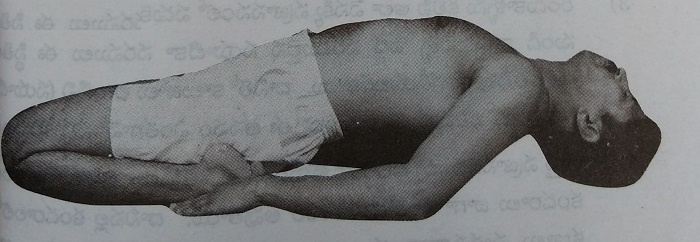
Like this, in this state (as shown in the image), to get habituated for some days, and after the pain is healed, try to touch the chest part. If you practice it like that, without any inconvenience, obese people can also get better results for their body. After taking out the asana, you will take rest, as said before.
Wrong state: In this asana, there are no mistakes made. At whatever level the chest is bent, the result will be good.
Benefits
1. For women, especially, the thighs will be touching and bruised. They cannot bear the weight and feel a lot of inconvenience. In this asana, especially for the obese people, the fat melts from the thighs and they lose weight. No other ways will work to reduce the weight of thighs. The body weight can be reduced but the weight from the thighs cannot be reduced. To reduce weight from thighs, no asana can help. Do the supta vajrasan twice a day and try to be more time so that you can get benefits.
2. Those who do not have any fat in the thighs, if they do this asana, the thighs will become strong. More blood circulation happens to the thighs and the health of the thighs improves.
3. If you fold the two legs and lie back, in vajrasan, the big sciatica nerves that go from backbone to the legs will be stretched during this state. As a result, the sciatica pain never comes in the future. This asana helps you in that perspective.
4. By lying down like that in supta vajrasan, the muscles in the thighs and waist part get contracted more. As a result, the cells in the muscles, discharge waste matter and get life energy. As a result, from the top of the knees to the waist part, there will be good effect.
5. When you lie down like that in the asana, as the stomach muscles and intestines get contracted, their energy increases more and they perform well.
Note
1. People who suffer from back pain and sciatica pain should not do this asana till the pains are reduced.
2. Doing this asana is a difficult thing. Those who start asanas recently, can do this asana after 7-10 days. Meanwhile, the body gets habitutated.
3. Those who are able to sit for 5-10 minutes easily, they can do this asana. After vajrasana is done, if you experience pain, then do not try this aasana.
4. When learning this asana initially, in the first 4-5 days, you better do not do this asana for a longer time..
5. While doing this asana, or coming out of this asana, you need to be very careful, and patient. Otherwise, you will be affected by some spasm or you will feel pain somewhere in the body.
Ustrasana
Ustramu is camel. The front part of the camel. Just as the neck is twisted and turned to the back, similarly, it will look same when you do this asana. That's why it is called ustrasana.
Method of doing
1. Make sure that the blanket is soft a bit, stand on the two knees. Keep one feet distance between two knees and the two feet. Keep the feet on the front part of the fingers.
2. Bend the waist and neck back slightly, bend to the left side, hold the heel of the left hand with your left hand.
3. Then, slowly, bend the waist to the right side and hold the heel of the right hand with you right hand. Close the eyes completely. Now, hold the two heels with your hands, bend the neck part back side, push forward the hip part and waist part, and stretch the waist part. In any case, do not open the eyes.
Asana State: In ustrasan, when you enter the asana state, if you are able to bend the forward the waist, and while bending like that, you will focus on the waist and just below the part of the waist. You will feel pain in the neck part. Stay in the asana and bear the pain as much time as possible. When you are not able to stay in the asana, come out of it carefully. Otherwise, you will feel giddy. For some people, after coming out of this asana, the body will feel like dozing. Without opening the eyes, leave the heal from one hand, carry the waist forward, and bend the neck forward and gradually, take out the second hand and sit in the vajrasan.
When we bend the neck, waist back, to bring the parts to natural state, when the ustrasan is taken out, you need to do some asana where the waist can be bent forward. Then, you have to the rest asana. Those who have neck pain, back pain ad sciatic pain, they should not do forward bending asana and move forward to the rest asana. All the remaining people, should do the asana which I am going to tell. After we come from ustrasa to vajrasan, place both the hands, hold them together, exhale air, and touch the head to the floor. The chest part touches the thighs. As the head comes down, release all air. While you are down, hold the breath. When you need air again, getting up slowly, inhale till the head comes up. This is called yoga mudrasan. Even in vajrasan, you can keep the feet wide, keep the seat touching to the ground, and can bend forward. If can do that, it is good for feet.
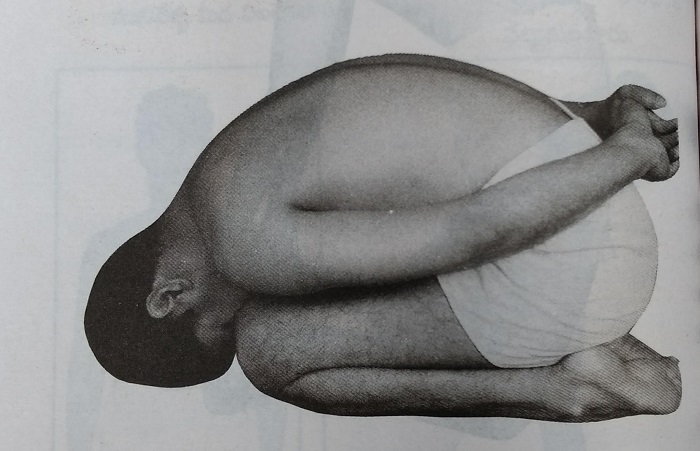
Rest state: When the waist is bent back, as the lungs are stretched, only little air enters. After ustrasan is taken out, around 1 litre of air is taken deeply. When such deep breathing happens, the body gets more energy. To take back the legs from vajrasan, lie down to the back side, keep the legs and hands freely, and can take rest for 2-3 minutes. During this rest time, every breath should be deep, and it fills the lungs. During this time, the mind will be very peaceful. Now, if you focus on the breathing, the mind will be peaceful without any thoughts.

Complete state: When you are doing ustrasana for the first time, it will be difficult to hold the feet with hands. After practising for some days daily, the waist gets habituated to bend back, and you feel like bending back a bit more. In such a case, the hands that are to be placed on the heels, will be placed on the feet, and bend further back, can push the waist forward. By doing like this, it will be tougher. As a result, the result increases.
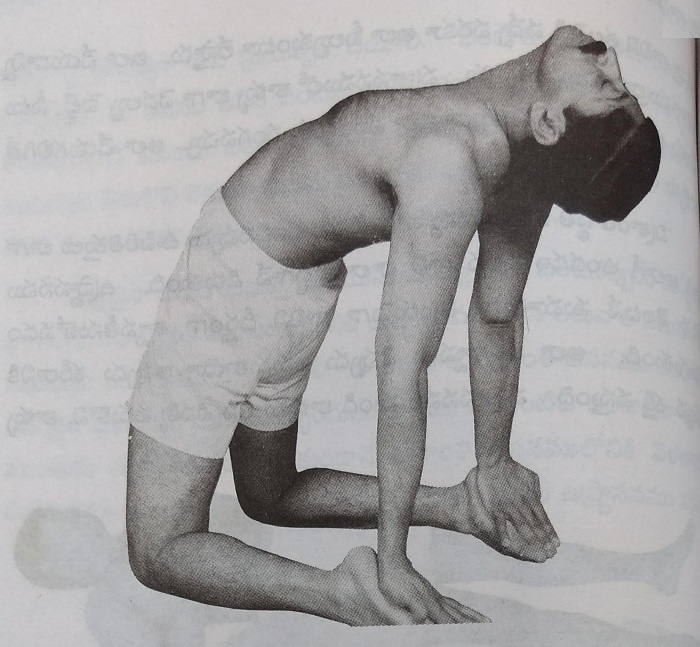
Another method: Those whose shoulders are heavy, those who have fat around the waist, who have bulged stomach, cannot bend their waist. Though they can bend a bit, as the fat obstructs in the armpit, you cannot hold the feet with your hands. If you stop doing this asana, assuming that you are not able to touch the two hands, then you will lose a lot. We have to do this asana somehow. First, stand on the two knees, stretch the legs, stretch the feet on the fingers, to bend to one side first, to touch the heel with hand fingers, with the second hand, hold the waist part as shown in the image. With the holding hand, push the waist forward, try to bend the neck and waist back and to stay in the effort. As you hold with one hand, the hand fingers should not slip away. While bending the waist as well, you should be very careful and slow. Otherwise, there is a chance of falling to the side. To stay in the asana as far as possible, and then slowly to take out the asana. And to sit for 20-30 seconds till the tiredness goes off, to do the same thing like this in the same way. Once you do this for two sides, then to bend front and do yogamudrasan. After that, take rest in the rest state and enjoy peace.
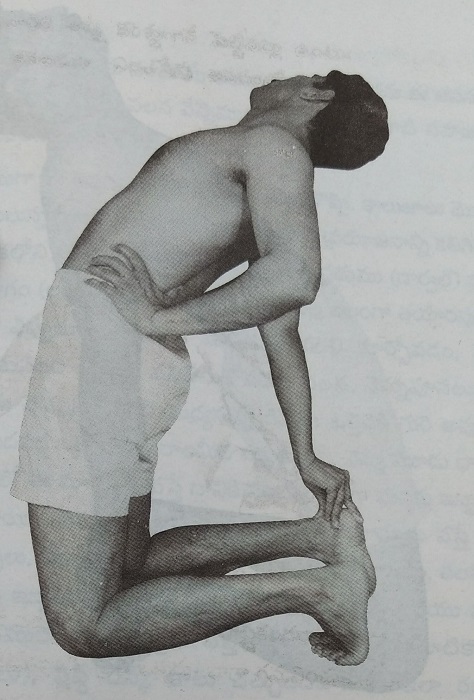
Wrong state: To get good result in this asan, to bend the waist well like an arch. Similarly, you need to bend the neck back. In the image shown below, the feet are well held with the hands. But the waist is not pushed enough forward. As a result, the waist did not bend back. If it is not bent like that, we cannot get the change we desire. For some people, the waist will be tightened. If it is tightened heavily, it looks like as shown in the image. If there is no such inconvenience, it can bend further more. There should not be any insufficiency in our effort and to bend further, it will bend as far as possible. That’s the benefit. Though there is an opportunity and still we cannot push enough, then we don’t get the benefit. When we do this aasana, pain comes below the backbone. If you don’t feel any pain in that area, it means, you haven’t pushed enough. Similarly, there is benefit to the neck as well. So, bend the neck gradually to the back.
Benefits
1. We are generally habituated to bend the backbone forward. But, in this asana, as we bend backward, the backbone will regain its lost natural state and stability.
2. This asana is primarily useful for people who suffer from back pain, neck pain, sciatic pains etc. The three parts of the spinal cord: neck (cervical), waiste (dorpal), the below part of the waist (lumbar) will become strong with this asana. As we always sit with bending the waist forward, doing things by bending the neck forward, the backbone disks are pressurized. With the pressure on the disks, the nerves get affected. Among the three parts of the backbone, according to the pressure on these parts, we will get problems. If changes come in the first part of the backbone, we will face neck pain, sciatica pain of hand, hand numbness, hand nerves pain, headache etc. If changes happen in the waist part or the in the part down the waist, we face different problems in disks, prolapse, sciatica pain, slipped disk, leg paralysis etc. The reason for all these problems is protruding of the backbone beads. If you do ustrasan twice a day, they will be bent backwards and enough gap is formed betweeb them. As a result, pressure will be reduced on the disks between the backbone beads. Because of this reason, if you do ustrasan daily, in 1 to 2 months, all problems mentioned above will be reduced. The neck pain will come down in a shorter time.
3. As we bend the bottom part of the waist completely backward, there will be pressure on this part and the fat melts there.
4. This asana helps in reducing the pressure that the side bones, muscles, chest part create on the lungs, and ensure that the lungs become wider and we can take deep breaths throughout the day.
5. It creates good movements to thyroid gland, digestion process, pancreases gland and provides good blood flow to all these parts and makes them healthy.
6. By doing this asana daily, we can get rid of back pains, neck pains, spasm in the waist, nerves pain in the waist etc. Everyone must do this asana as a precautionary step.
Note
1. Whiling coming out of ustrasan, if you open the eyes immediately, you will feel giddiness. You may feel the nerves in the head are moving. So, you should not open the eyes immediately.
2. During the first seven days, after the asana is done, be in the asana for only 5-6 seconds and then take it out. Once you get habituated, you can stay for more time. Initially if you bend it more and stay in more time, there will a spasm in the waist.
3. Those who have neck pains and back pain, should do it carefully. After this asana, they should not do any asana where we bend the back forward.
4. To get good result from this asana in lesser time, you should do it two times a day without fail and every time you do, do it two times i.e., after completing the asana once, do it again.
Uttana paadasan
Uttan means to getting up. In this aasana, we lift the two legs up and stop them, this is called uttata padasana. It is easy to do this asana. But staying in this asana is very difficult.
Method of doing
1. Lie down on the blanket flat, keep the two legs together, రెండు కాళ్ళను దగ్గరగా జరిపి, రెండు పాదాలను ముందుకు చాపి, రెండు చేతివ్రేళ్ళను కలిపి తలక్రింద పెట్టుకోవాలి.
2. Now, lift bother the legs together to one feet above the ground, without bending the knees. Keep the eyes closed.
Asana state: Stay in the asana as far as possible by not moving the leg, keeping them in one feet height, with focus on the below part of the waist. After some time, the muscles under the navel part will be tired and are unable to bear the weight of the legs and leave them. In such case, we will come out of the asana.
Rest state:
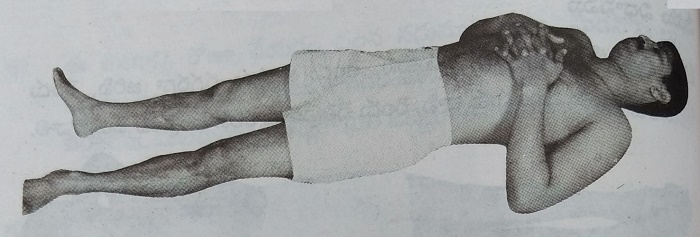
When you are in the asana state, the stomach muscles contract more. As a result, there won’t be any diaphragm movements and the lungs do not extend well. As a result, the air does not enter the lungs well. Breathing happens superficially. That’s why, we feel more tired in this asana. Once you come out of this asana, deep breathing happens. Now, lie down flat, take out the hands from behind the head, keep them on the chest, and take rest. Now, without opening the eyes, focus the mind on the breathing, and be in the rest position till you come to the normal state. Instead of keeping the hands on the chest, keep them wherever you feel comfortable. The mind won’t have any thoughts now. Because, after taking out the asana, as deep breathing happens, more oxygen is supplied to the mind and the body, and the mind becomes peaceful. Such peaceful experience you won’t get otherwise. That’s why, when doing asanas, after taking out the asana, the focus on the breathing gives good results.
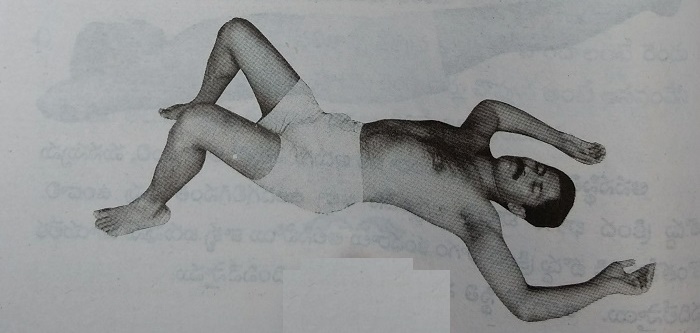
By bending the legs slightly up, as the bottom part of the waist and the muscles around bear the weight, they get tired. For some people, after this asana is done, below the waist, and in the hips area, a slight inconvenience is felt. Those who feel like this, after the asana is done, instead of stretching the legs, they can fold the legs and make them stand on the feet, it will be good. By placing legs like this, the bottom part of the waist touches the floor well, those parts take complete rest and become painless. Individuals can prefer one of these two rest positions according to their preference.
Another method:
Those who are obese, who have heavy thighs, calves, whose stomach muscles are weak, who are sensitive body, cannot lift the two legs even slightly. They can lift one leg, but that is not useful. For such people, there is another way. As they are not able to lift them without bending the legs, till you learn the asana, bend the two legs slightly, lift them up. Lifting to one feet of height may be tough, so, you can lift at your comfort. Even if you can do it for a shorter duration, that would be fine. If you do the asana for 10-20 days, even the obese people can also do it. Overweight people have to do the rest asana by bending the legs up, it would be comfortable.
Wrong state:
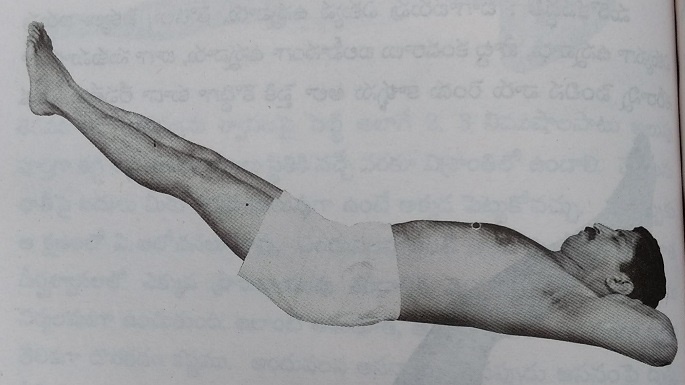
People make mistakes even in such easy asanas. There won’t be any damage because of the mistakes done in the asana, but you won’t get the benefits from the asanas. By not bending the two legs, when you lift the legs up for one feet length, all the weight will be on the bottom part of the navel muscles and nerves. If the weight falls on these arts, the benefit comes in the area. Some people lift the legs from the ground to 2 feet height. They think, the more height, the better it is. But, as they lift to more height, all the weight of the legs will be on the top part of the navel, instead of the bottom part of the navel and stomach muscles. As a result, no body part gets the good results. We are doing another asana next which will be useful for the top part of navel. This uttanapadasan is especially useful for the below part of the navel, so, you should not lift the legs more than a foot from the ground. This is important for this asana. Similarly, when you are in the asana state, you should not move the legs to top and bottom. The results will come down if you move like that.
Benefits
1. This asana’s main effect is for melting the fat under the navel. We won’t get this kind of benefit with any other asana. Everyone has some level of abdomen. If you want to get rid of it, people leave it as they do not know the methods to reduce. If you try to reduce the body weight in different ways, you can reduce some weight out of the overall weight, but we cannot reduce the fat under the navel. This asana is good at melting the fat there. The weight of both the legs can be 20-30 kg. The body parts under the navel can bear for 1-2 minutes. Because of that, the fat will melt in that area. If you do the asana for 4-5 months, the fat in that area will be melted. The belly will come down to a great extent.
2. This asana is more useful for women who have given birth to children. For many women, the body part below the navel, and the above the navel, will be stretched after giving birth. If they do this asana for 2-3 months every day, twice a day, the belly part will stick back to the stomach, just as the baby sticks to the mother.
3. A lot of pressure happens on the large intestine and rectum. In the asana state, the bottom part of the navel will be tight as stone. It means, it contracts to such an extent. During this asana, there is more pressure on the large intestine, and faeces moves forwards and sideways. That’s why, this asana is useful for people who have weak intestines, who have constipation, and who have low intestine muscle power. After this asana, smooth motion happens.
4. This asana gives special result to the uterus. As the stomach gets contracted much, the uterus gets more energy, and there won’t be any problems such as stretching of uterus or increasing its size. If there are any such problems, they can be done with this asana. In exercises, movments don’t happen in the body parts. But, with asanas, each asana helps one part with special movements, blood circulation, muscle contraction.
5. As long as you are in this asana, the lungs expand well. After you come out of the asana, they will contract. As contraction and expansion happen in the lungs, air flows through the lungs well. As a result, we can take more oxygen into the lungs. When a lot of oxygen intake happens into the body, our efficiency increases to a great extent.
6. The muscles of the stomach and intestines will become strong.
Note
1. Some people want to reduce weight on the first day, and stay in the asana as far as possible. As a result, you will face many pains and not able to walk or lie down. People who are starting it for the first time, should not stay in the asana for more than 5-6 seconds.
2. If you hold the breath and do this asana, we cannot stay in the asana for a long time. As a result, the effect will be less. If you do the asana without focus on breathing, the lungs will inhale the air which the asana needs. That’s why you should not hold the breath.
3. Ensure that bowel movements happen before you do this asana, so that you can stay more time in the asana. If motions was not smooth, you will feel pain in the asana and you will come out of it soon. To get results, it is mandatory to have free motions.
Naukasan
When you do this asana, our body will be like a ship. That’s why, it is called naukasan. The enzymes which are important for the body health, the glands which create hormones, are effective on the chest part, and streamline the life energy flow. That’s why, it is called pranasana.
Method of doing: This asana is easy to do. But, it is difficult to stay in this asana.
1. Lie down flat, stretch the legs and hands, keep the two legs together and do not bend the knees, lifet from the floor to one feet height.
2. Then, don't keep the hands to the floor, hold the thighs with the hands lift the head, chest up and hold. The back part should not touch the floor.
3. Now, leave the two hands stretch them above the thighs in the air, to keep only the hip part and the waist part to touch the floor and to keep the remaining part in the air. Then, close the eyes.
Asana state: Without moving the body and head, stay in the asana and focus on the stomach, above the navel. When you are in the asana, as the top part of the navel and the chest are tight, will be moving slightly and tremoring. That is natural. Staying in this asana is tougher than uttanapadasan. As far as you can stay like that, as you don’t get tired, and when you think you can no longer stay in it, lie down back and close your eyes.
Rest state: To stay in this aasana for 20-30 seconds without moving is very difficult. You will be tired even in that duration. You will feel the chest part twisted. As you list the chest part and hold it that way, the breathing will stop 80-90%. That’s why we feel so much shortness of breath. Once you take out the asana, deep breathing happens. Then, the mind becomes peaceful. Once you come out of this aasana, lie down flat, release the hands and legs freely, focus the mind on the breathing and experience the peaceful state for 1-2 minutes. Till your breathing comes to the normal state, be in that rest mode.
In this asana, as you hold and stop the legs one feet above, if you feel pain under the waist part, once you come out of the asana, as shown in the image, fold the legs and take rest. As a result, the back touches the floor and the burden is reduced.
Another method:
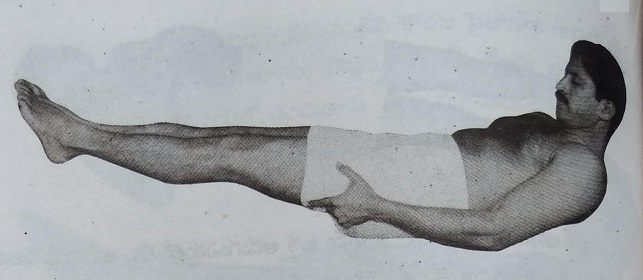
Those who are heavy, who has belly, heavy chest, as said above, they cannot get up in this asana. For them, to keep the hands on the thighs in the air, it is difficult. If you keep the hands up like that and keep them without any hold, it will give good results. If you find it difficult, after lifting the legs one feet above, lift the chest part slightly, hold the thighs with hands, push the two elbows to the floor, holding the chest weight with hands, try to stay in the asana. Though the obese people take the help of the hands, they can get complete benefit. By stopping the body like that, there will be a lot of strain on the the top part of the stomach and inside the abdominal part. Compared to lean people doing it completely, obese people doing it half the asana, it will give full results. The obese people will get more results. As you can stay in the asana as far as possible, then lift the legs up slightly, and take the rest posture lying down. Obese people generally feel shortness of breath. In this asana, they will feel more shortness of breath. They need to take rest till the breathing becomes normal.
Wrong state:
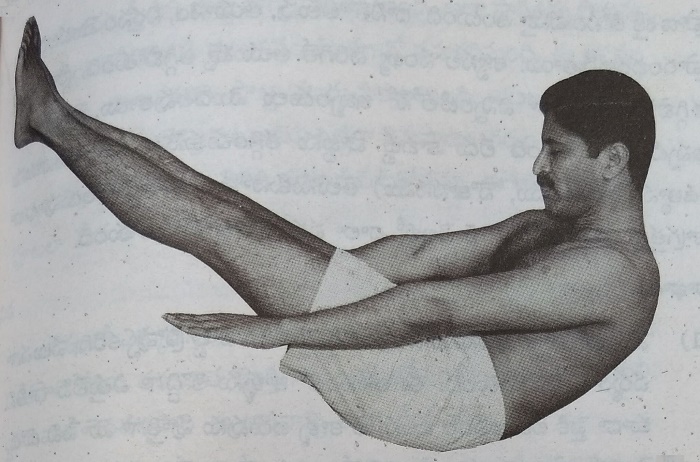
In this asana, if you make a mistake, the result will change its place. Normally, if you lift the legs one feet up, without holding the chest, head if lifted to some height, the weight of the legs is on the top part of the stomach. As a result, the top part of the navel gets contracted and gets more result in the asana. For us to do this asana is give good result for the top part. Just as we get good result under the navel, in the uttanapadaasan, in this asan, you will get result on top of the navel. As a result, both of these asanas are good for chest part and abdomen part. Some people do it as shown in this image. If you do like this, you can stay in the asana for more time. People think that he got up well and the asana has come well. 60-70 percent of the result will be gone. Lifting the legs to 2-2.5 feet is one mistake. Similarly, listing the chest to such height is the second mistake. As you are lifting both the sides, there won’t be any pressure on the top part of the stomach. That’s why, there won’t be any tiredness. Breathing will be lighter. If you didn’t get the result, it means, there is some mistake. If you do like this, shown in the image, there is no use.
Inconvenience with the stomach
For many people, belly is a big problem. Above the navel part, it is more visible. Everyone likes to have flat waist. Some people do not know how to reduce belly and some people, with negligence, looks at it growing. Though, it may not cause us much difficulty, it causes difficulty for respiration and diaphragm movements. Due to the belly, breathing does not happen till the last part of the lungs. As a result, the lungs will not be full with air. Because of the belly, breathing happens on the surface of the lungs. As a result, the number of breaths will more than normal. Since then, the body will have deficiency of life energy. Then, shortness of breath, fatigue start. If the number of breaths increase, life span reduces. Efficiency decreases. Many similar problems start. That’s why, it is good to control the belly with the asanas such as uttanapadasan and naukasan. If you do these two asanas two times a day, in 4-5 months, the belly will melt down.
Benefits
1. Due to naukasan, just above the navel, the fat melts and the skin becomes thinner. In this asana, lift the legs to some height, lift the chest as well, the weight of the legs are carried by the top part of the navel part and the top part of the stomach muscles. As a result, though it is less time, there will be good result to the stomach. There are people who practice this in 3-4 months, and reduced their 5-6 inches of stomach. In no other asana, this kind of effect is possible for stomach. Remember that naukasan is the asana of the top part of the navel.
2. This asana shows effect on the pancreases gland in the abdomen area. When you do the asana and stay in it. When you do the asana and stay in it, to the stiffness, there will be an effect on the pancreases gland, and the insulin producing cells are affected. In this asana, the gland gets massaged well. If diabetic patients do this asana, the sugar percentage in the blood will be reduced a bit.
3. As different organs which support in digestion – liver, gallbladder, small intestine, stomach are affected in this asana, their efficiency is improved. Powerful digestive acids are generated. It helps in curing indigestion, loss of appetite etc.
4. After delivery, for women, the stomach will be stretched. This asana helps in reducing the stomach. Because of this asana, the fat gets melted and the stomach gets folded, especially, the stomach muscles gain strength and become strong. They can regain the status of the stomach that was earlier, before the delivery. It is good to do this asana twice a day.
Note
1. You cannot stay in this asana for long time. So, to get more benefit, after doing it for the frist time, take rest completly till all tiredness is gone, and then to do it again.
2. In the beginning, till you get habituated, do it only for some time and then to stop. Once there are no pains in the body, when the body is habitutated without having any pain, you can do it for the second time.
Sarvangasan
Every asana affecs some organs and gives separate result, but one asana cannot affect on all the organs. But, sarvangasna can affect all organs and body parts. That’s why, it is called sarvangasan. Its effectiveness is in its name. shirshasana is not possible by all. If it is not done properly, it has bad effects. But, there are not bad effects in sarvangasan and it gives good results.
Method of doing
1. Initially, ensure that you lie down flat with legs stretched and keeping hands to the sides and the blanket touching the head part. Then, keep both the hands together, not to bend the knees and keep the feet looking towards the sky, and make the legs in line.
2. This time, fold the legs slightly, lift the waist up in one push, and place the palms on the waist to hold it so that the waist doesn’t fall down. The knees will come to the head or face front part.
3. If you do not hold the waist properly, it will fall down. As shown in the image, the four fingers should touch the waist part and the thumb finger to hold the side part of the waist. If you hold like this, you will get a grip on the waist.
4. Now, hold the waist part tightly, push the legs to move forward in line.
5. Now, make sure that the legs and waist are moved in line. From shoulders to the feet, the body should be 90 degrees straight. The feet should be stretched towards the sky. Close the eyes and keep the body like that, without moving.
Asana State: Once you do sarvangasana, it won’t stand still. The hands will be moving. Intermittently, you need to adjust the hands and hold the waist. The waist bends intermittently. You need to keep it straight. Once you complete sarvangasana, focus on the blood flow. From feet to the hip part, you need to observe the changes. If you do sarvangasana only for 1-2 minutes, it won’t be much useful. You need to stay as long as possible. After 2-3 minutes, numbness starts in the feet, the blood circulation stops in the feet etc. In the stomach and chest part, after 2-3 minutes, the blood flows fast, the eyes become red. In the sarvangasana, the chest doesn’t make contraction and expansion. Little amount of air enters into the body. As a bend comes in the neck part, the breathing doesn’t happen well. As a result, there is some is little air supplied. As long as you stay in the sarvangasana, the blow flow will be reduced and numbness to the legs increases. If you stay in the sarvangasana for 5-6 minutes, from the thighs area to the feet, there is not sense of touch. From throat to the navel part, the blood circulation happens and it looks inflamed as in the rose color. The eyes become red. The face become red. If you are able to stay in the asana like this from 5-6 minutes, there will be changes in the blood circulation. If it happens like this, it will be beneficial to all the organs. You need to stay as far as possible and once you want to come out of it, you can try the halasana, you need to go from this asana. Those who cannot do halasan, will come out of sarvangasan slowly. Those who can do sarvangasana well, those who are earlier habituated to it, those who can bend the body easily, can try halasana. Let us see how we can go from sarvangasana to halasana.
Halasan: 'Halamu' means plough. In this asana, the body looks like a plough. Tht's why it is called like that.
Bend the legs that are in the air in the sarvangasana gradually, bend the knees, bend the two knees coming to both sides of the face, touch the feet to the ground beyond the head. Then, remove the hands from the waist and place them on the floor. Then, arrange the two knees gradually, moving the feet afar, from the feet to the buttocks area, make that the legs are in line. You can stay in this state as far as possible and then folding the legs, bringing down the chest part, and to come to the normal stage and lie down flat.
After coming out of sarvangasana, the legs will be numb. So, without taking rest, if you do the pashchimottasan, it will come good. After doing paschimottasan, you have to take rest. Similarly, those who move from sarvangasan to halasan, without taking rest after halasan, do paschimottasana and then go for rest.
Another method: For obese people, it is difficult to do sarvangasan. Those who can try the asana, can do it. If obese people do sarvangasan, when they lift the body up straight, it won’t come straight. They can do at their best and the result will be like that. If obese people are not able to do, they can take the help of someone, who can hold their waist and stop the weight of the legs. As shown in the image, if they hold the hip area, it would be good. They can stay in the asana as long as possible and to come to the normal state. In this asana, there is not much chance to do mistakes.
Benefits
1. Due to this asana, more blood is supplied to the thyroid gland, and it controls the imbalances of the hormones. As a result, the inconveniences about thyroid will come down. Those who do not have thyroid problems can ensure they do not get affected in future.
2. In this asana, as the head is down, the blood flow is more to the pituitary gland and pineal gland in the head, their efficiency is improved. As the pituitary gland controls all the production of hormones. Because of this asana, all the endocrine glands improve their efficiency.
3. As you do this asana, in children whose growth is stopped, hormones are produced.
4. Because of this asana, people who suffer from Varicose veins (the bulging of the blood vessels in the feet), the veins in the legs get strengthened and can carry more blood. Those who have this problem, the bad blood doesn’t go up to the blood and stays in the legs, there are more inflammations and pains. They must do sarvangasan, twice a day. If the pains in the legs are more, they need not do sarvangasan completely. As shown in the image, they only need to do the first part of the asanan – keeping the legs up for 2-3 minutes. They will feel very comfortable. They can do it for 5-6 times a day.
5. Legs and feet are the farthest organs. Because of this reason, the blood circulation generally happens slowly. For those who always work, due to their work, the blood flow happens. To those who do not do physical exercise, the blood circulation doesn’t happen well and they will feel numbness, inflammation, loss of touch sense etc. Medicine cannot cure such things. People of age 40-50 face such problems more. Due to sarvangasana, for legs and feet, the blood circulation happens very actively. If you do sarvangasana daily, we can protect ourselves from the clotting, closing, narrowing of blood vessels in the fingers of legs.
6. In this asana, primarily, the blood circulation to the mind happens well. As a result, more oxygen is supplied to the mind, and the mind functions well. If students do sarvangasana daily, their memory power and thinking power improve a lot.
7. As long as you stay in the sarvangasan, the shoulders carry the body weight. As a result, the neck part becomes strong. There is no chance for the generation of neck problems and pains.
8. Blood circulation happens well to the throat part. We no longer feel the problems such as tiredness in the throat as part of talking much, or pain in the throat. The throat muscles become strong and they co-operate in pumping the blood that goes to the head.
9. If you practice sarvangasana every day, the muscles, nerves and bones come under our control and they work well. the body can be twisted well.
10. For those who do not do physical exercises, there won’t be any inside organ movements. But, especially with the sarvangasa, the organs will get good movements, good blood flow and good life energy and all organs work well with good efficiency.
Note:
1. People who have neck pain, back pain and heart problems and high B.P should not do sarvangasan.
2. Those who are learning it new, should do other asanas for 1-2 months and then start sarvangasan.
3. People who are too obese and cannot do sarvangasana, can leave it for some days.
4. People who are beyond 60 years - if feel tiresome - can leave this asana.
Paschimottaan
‘Paschimam’ means back, the backside of the body. As we bend the back part into front, this is called paschimottasan. Similarly, as this asana makes the life energy pass through sushumna route, this is called paschimottasan.
Method of doing
1. Stretch both the legs front, and do not bend the knees, and sit keeping the legs touching the ground.
2. Bend the back front, hold the fingers of the legs with both the hands. Do not bend the legs at knees.
3. Bend the head just as kissing the knees, and keep the hands touching to the ground. Now, keep pressing the legs against the ground without lifting them up. Keep the eyes closed.
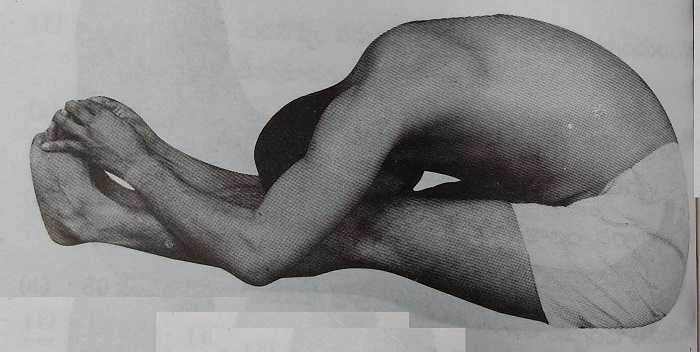
Asana state: Without lifting the legs up, touch the head to the knees, stay in that state, and focus on the bottom part of the knees and thighs and to stay as long as possible. This state is very difficult to stay. The nerves in the legs are stretched. The nerves will be paining. There won’t be any benefit by bending the legs. That’s why, better stay without moving the legs. In this asana state, in the stomach area and above, there will be pains. In such case, come out of the asana and take rest. Throughout the asana, the diaphragm will be contracted. As a result, only litter air enters inside. Because of this, one feels shortness of breath. You can stay as long as you can and when you cannot stay and you need air, you can come out slowly. While coming out, unknowingly, you will inhale air in deep breathing. After doing sarvangasana, instead of taking immediate rest, if you do paschimottaan, you will feel more tired. It is better to give rest to the body.
Rest state: In paschimottasan, as you are very much tired in sarvangasan, take rest by lying down flat, keep the legs and hand free, and keep the mind on the breathing and get peace. As you don’t get good amount of air in the paschimottasan, now, deep breaths run and they keep the mind peaceful. Like that, take complete rest for 2-3 minutes. After this, you need to do tiring asanas. That’s why, unless you take good amount of rest, you cannot do asanas.

Another method: Those who are very obese, who have a lot of weight, cannot do paschimottasan completely. If obese people look at the complete asana, they will be scared. They think that, ‘how can we do such asanas, we cannot do all these things, we are unfit for asanas’, and they gradually move away from asanas. Though we may not be able to do the complete aasana, we can get some good results. Most of the people do not know this secret. Whoever is doing the asana, according to the effort they give, the results will be accordingly. If everyone knows this secret, most of the people do this. Those who have heavy belly, don’t be disappointed that you cannot kiss the knees. You can bend as far as possible and stay in it. Try to bend your back as far as possible and try to lift the knees at your best. If you are able to do this much, as shown in the image, the result would be good. You will get similar results like that of who can bend completely. But, the results will be zero, if you don’t stay in the position after bending to whatever length you can. The time that you stay without moving, giving the good results. For many people, despite not having belly, they cannot do this asana. It seems fat people are better for this asana. For thin people, the rod-like waist doesn’t bend forward. This is in fact the toughest asana, which many people cannot do at all. Of all the asanas that I teach, most of the people have trouble with this asana only. Whether you are thin or fat, if you try this asana as far as possible, - bend and stay in that position, and focus the mind, you will get good results. Then, you have to do the rest asana.
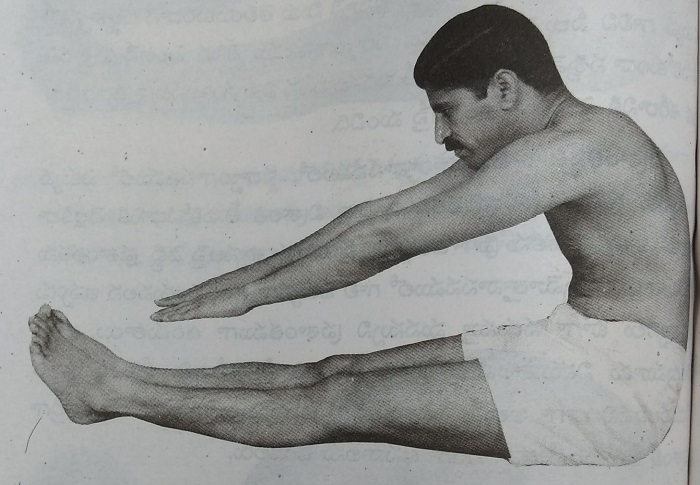
For some people, kissing the two knees is very difficult. For those who cannot bend forward, let us think about an easy method. If they can do it with one leg, after practicing for some days, and once bending becomes habitual, better do with two legs. Now, we will learn about the single-leg paschimottasan.
1. Stretch on leg completely, without bending, to bend the second leg completely, as shown in the image.
2. Now, bend the waist forward, to touch the foot with two hands, and ensure that the leg is not lifted up.
3. Without lifting the stretched leg at the knee, touching the head to the knee, place the elbows to the ground.
Like this, without lifting the leg, you can bend as far as possible, stay some time, and when you cannot stay, take out the asana, and do the asana where you can take rest sitting in a resting asana for a minute. Then, fold the leg that was stretched earlier, and stretch the other leg again. Like this, do this asana, two times, separately for two legs. Then take rest.
Wring state:
There is a chance that many people may do wrong. They only thing about kissing the knees. They think, if we can do it, we can do the whole asana. The mistake that all people in this asana is: when we are touching the head to the knees, as it is difficult, they bring the knees to the head. As shown in the image, it is a mistake if the knee bends like that. In this aasana, it is okay if you bend to any extent. But, if you lift the legs, the effect is zero. When you bend knees, the nerves that go from backbone to the legs are not stretched in this aasana. The stomach muscles do not contract well. As a result, the changes won’t come that are supposed to come in the aasana. You should know that it is important not to bend the knees and kissing the knees is not that important..
Benefits>
1. In this asana, the backbone will stretch as far as possible. Compared to the normal sitting stage, the backbone stretches 20% more in this asana.
2. The muscles at both the sides of the backbone will become strong. The blood circulation happens well.
3. The nerves between the waist and the hip become strong. As a result, all the organs connected to the nerves work well.
4. In this asana, especially, the nerves that go from backbone to legs get stretched. In this asana, when you bend well, the nerves pull in the thighs, and we feel the pain and the stiffness. Because, as the big nerve, sciatica is stretched, in the future, there won’t be any sciatica nerve pain problem.
5. In this asana, the muscles under the knees and the thighs are pulled and get contracted. As a result, the muscles become strong.
6. When bent well, in this asana, the stomach muscles get pressed well. As a result, pressure increases and in that area, the fat melts and the stomach becomes thin. It helps to stiffen the stomach.
7. For sugar patients, this asana is very useful. When we bent forward, the pressure on the pancrease gland increases the strength to the cells. As a result, some percentage of insulin is increased.
8. It gives pressure on the large intestine (rectum). When you are in the asana, due to the pressure, the stored faeces is pushed forward. The intestines gets more energy to push faeces. As a result, intestines will help to solve the constipation problem. Faeces can come out in large quantity so that free motions is possible.
9. In this asana, the muscles, nerves and the lungs that help in respiration, get energetic to contract well. This change helps in increasing the air quantity to breath in. As a result, the number of breaths will come down.
10. In this asana, the uterus, urinal bladder, liver, stomach, intestines, spleen get good movement and the blood circulation happens well.
Note
1. Those who have back pain, sciatic pain, neck pain should not do this asana.
2. If you take someone’s help to press the knees forcefully, it is dangerous. It should not be done like that.
3. When you are learning for the first time, if you do it more initially for 2-3 times, you will have so many pains that you cannot walk. The calves of the legs will be stiff. Once you are habituated, try to be more time.
4. When you bend forward, though you are not able to touch feet with hands, don’t get disappointed. It takes months for many of you to get this asana right. If you keep trying, it will give results. Don’t think that you cannot do it.
5. Those who have liver problems, high B.P., heart problems, it is better not to do this asana.
Bhujangasan
Bhujanga means snake.When the snake opens its hood and rises up, the body in this asana looks like that. That's why, it is called bhujangasana. Just as the snake move forward and side so swiftly, we also can twist the waist, if we master this asana.
Method of doing:
1. Make sure that the blanket comes to the head part, and lie down with back faced towards the sky. Keep the two palms, on the waist, both the sides, as shown in the image, only with fingers touching the waist.
2. Then, pushing the two elbow parts inside, keep the elbows in the chest line. When you are going to do the asana’s main posture, the gap between the elbows should be like that. It should not grow.
3. Now, pressing the elbows inside, stretch the two legs together, try to push the head, chest part, from the navel. To bed the neck backside and to close the eyes completely.
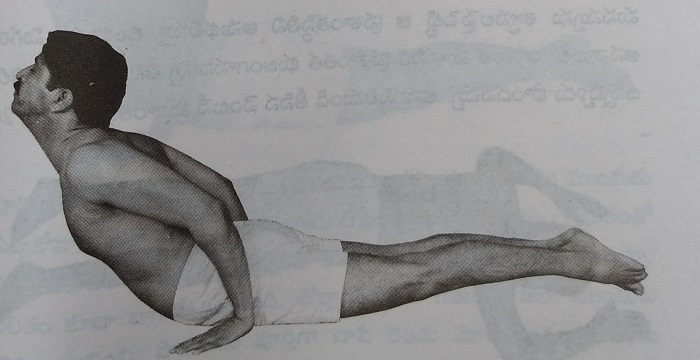
Asana State: Once you lift the head and chest part from the navel, as far as possible, focus the mind on waist to neck part, and stay in the position without moving. As the chest is bent back, the lungs, side ribs, muscles expand well and stay like that as long as you are in the asana. So, in this asana, only 10-15% air enters the body. As a result, you will feel tired, with lack of air. The back and the waist part will be painful and you will feel, it is squeezed. It is difficult to stay in this asana for more than 10-20 seconds. With practice, you can stay 1-2 minutes. Everyone can do this aasana, but in less time, it gives more tiredness and more results. If you are able to keep the body in that state for a long time, then you will get more results. The results will come according to the time we are in the asana. That’s why, you need to stay in the asana, till the moment you will feel that you can no longer stay in the asana. As you come out of the asana, bring down the chest and lie down on the floor. Do not open the eyes.
Rest state: lie down with back facing the saky, leave the legs and hands freely and keep the face sideways and take rest as shown in the image.
Focus the mind on breathing, and enjoy the peaceful state. You can feel more peace compared to other asanas in bhujangasan. Once you come out of the asana, in the rest state, 20-25 deep breaths happen. As a result, the life energy enters the body fully. In the rest state, the mind won’t get any thought and experiences emptiness for 2-3 minutes. Till breathing comes to normal, you will stay in that state and take rest. If you don’t take rest properly, you cannot do the next asana well. Especially in the four asanas that you do with back facing the sky, you need to take more rest.
Another method:
As some people don’t have strong back muscles and backbone strength, they cannot do the asana as described above. For such people, and for obese people, let us discuss an easy method. In this asana, if the palms are placed under the navel part, it is very difficult. The small change in this asana is, moving the hands a bit forward. Instead of touching the fingers as in the above explanation, you place the palms completely. Keep the two palms just a bit ahead of the navel. By placing like this, you can get up with the help of the two hands. As a result, you can do this asana easily. The result will also be good. Lie down with chest touching the ground, stretch the feet completely, push the two elbows inside, lift the chest and the head with the help of the hands, and stay in the complete state. Close the eyes.
Wrong state:
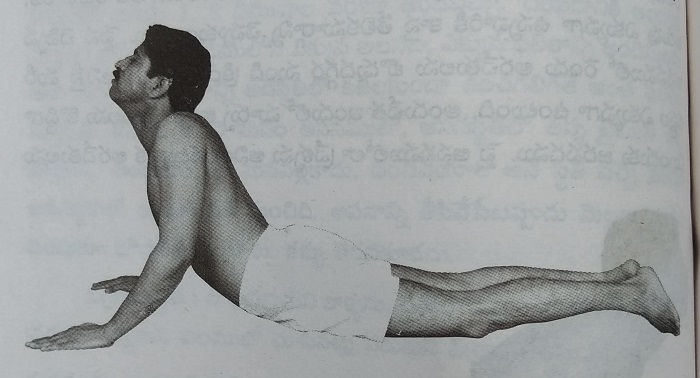
In this asana, many people do mistakes. The result in this asana changes according to the way we place the hands. Many people when they do bhujangasan, with hands keeping forwards as shown in the image. Placing the hands in such way, the chest weight, from the navel needs to be lifted up. Once you lift up the chest, the hands will be carrying the weight, not the backbone or waist. If the hands carry the weight, the backbone doesn’t get any benefits. Snake lifts its body without any support. We should also do bhujangasan without any support. If you use hands to lift up the body, the meaning of the asana is getting changed. If you keep the hands under the navel part and do bhujangasan, there is only 10-15 % of use, and 85% of benefit will be given to the backbone and waist part. If we do it in another method, if we push the hands ahead, 30-40% of help comes from the hands. So, only 60-70% of benefit reaches the backbone and waist. If we do it as in the wrong state, if we keep the hands front, 80-85 percent of help comes from the hands. As a result, there won’t be more than 15-20 % of benefits to the backbone and waist. According to our physical capability and our endurance, we can change the state of the hands and get good results from this asana. Those who have heavy back pain, if they feel inconvenience in this asana, gradually to adjust their hands. With this asana, the body weight will be reduced, and the fat at the waist will be reduced. Whoever wants to get this result, the more extent, they keep the hands to the chest, they will get the better results. One more important thing! When lifting the chest, if you don’t push the elbows inside, there is a chance that the body may be lifted on the hands. That’s why, to get better results, to push both the elbows inside, and push the waist up. Though you are not able to place the hands as I mentioned, gradually, you can move them backwards according to your comfort.
లాభాలు
1. With bhujangasana, you can get good results, for backpain, neck pain, sciatic pain, or other back-related issues. For such problems, this asana is a great boon. As long as you stay in the asana, as you keep the back and neck bend back, the distance increases between the vertebrae. As a result, the pressure on the disk is reduced. This asana ensures that the nerves don’t get squeezed between the vertebrae. For those who need to go for surgery for back and neck, will also get better with this asana. This asana needs to be done two times a day. It needs to be done once and then to take rest and to it again one more time and to take rest, and to do like this 2-3 times morning and 2-3 times evening. If you feel back pain, initially apply coconut oil, hot water massage and then to do asanas. Like this, if you do for two times, you will get relief.
2. These days, most of the people have some problem with waist or neck. There are no medicine, which can cure permanently the neck and waist. Once the problems have come, no medicine works. No physical exercise can save you from these problems. The only solution is asanas. Instead of suffering after the problem come, it is better to prevent these problems with the help of these asanas. Then, you won’t face any problems related to waist and neck.
3. It is one of the asanas which are useful to reduce the weight of the body. As doing this asana is difficult, more energy is spent and the weight gets reduced. If you do this asana two times a day, the weight reduces well.
4. For many people, fat is accumulated around the waist. In Bhujangasana, the fat become thinner in the areas of below the neck to waist part, both the sides to the backbone. With this asana, there will be pressure on this part. This is the most important aasana to reduce the fat in that area.
5. It give pressure to the kidneys and removes all blood flow problems.
6. This asana helps the lungs so that the body takes deep breaths 24 hours. As a result, the body gets more energy.
Note: 1. As it is not difficult to do this, many people do it multiple times on the very first day and cause troubles. In the initial 5-6 days, you should do it lightly. If you do it in hurry, you will feel neck and back pain.
2. Those who have hernea, should not do this asana.
Sarpasan
If you look at this asana, it is like the snake gets up to open its hood. There is some difference between this asan and bhujangasan in place the hands. We will know this change in this asana.
Method of doing:
1. Lie down with chest touching the ground, ensure that the head part is placed on the blanket. Move the two feet together, stretch the two feet, with the fingers of two hands, to hold the bottom of the two buttocks..
2. Pulling the buttocks area with hand fingers, to lift the chest part from the navel part, and to bend the head back. In that way, it is better to lift the chest and the neck as high as possible and stop it there.
Asana state: From the navel part if you lift the front part, stop it there and focus on the bottom of the waist part and neck part. In this asana, as the hands are not touching the ground, it is more difficult than the bhujangasan. It is difficult to stay in this asana. To stay in it for 20-30 seconds, it takes a lot of energy. You can stay in the aasana as far as possible and once you are not able to stay in it, you will come out of the asana and lie down with chest touching the ground, you should not open the eyes.
Rest state:
The body would be tired a lot. You need to take rest lying down like that with legs and hands placed freely and take rest. A this time, focus on the breaths and experience peace. The lungs will expand more compared to bhujangasan. As a result, we get more tired. When we are in this asana state, the back part and the waist part gets contracted. These parts would be painful in the asana state. When people come out of this asana, they will feel much relief. In a short time, this asana can give good results. In the rest period, deep breaths happen and it gives good life energy and removes body’s tiredness. Till the body becomes to normal position, you need to be in the rest period. There is no mistake as to be done in this asana. You will get good results, in whatever way it is done.
Benefits
1. All the results written for bhujangasan are applicable to this aasana as well. Similarly, it is good for those who have back pain and neck pain.
2. Because of this asana, you may reduce weight. Those who want to reduce weight, have to do this asana twice a day.
3. While doing sarpasan, the pressure that you feel on the back, the adrenaline in the kidneys will show good effect on the glands and helps in their functioning.
4. In sarpasan, with 90-95 % of back bone strength and muscle power, the chest is lifted up like that. So, it gives strength to the waist and the vertebrae and the muscles around. Of all the asanas that are possible for all, sarpasan gives more results.
5. It gives support to the body so that it ensures the co-ordination between the mind and the body.
6. Despite lifting up weights of any size, and sitting as you like or turning around as you like, there won’t be any problem of back pain, or misplacement of disks etc.
7. Due to sarpasan, there will be benefits for the lungs. When you are in the asana state, the breathing will be inside. As all the body’s weight is on the stomach, the pressure in the stomach pushes the diaphragm up. As a result, the pressure on the chest increases, the pressure will be more on the air in the lungs. As a result, the alveolies that are not working as they are closed, will be opened and the air filling capacity will increase. The carbon dioxide will be sent outside, and oxygen will be taken inside. Because of this, the blood circulation happens well to the heart muscles and the heart becomes powerful.
8. Gives pressure to all the organs of the abdomen area, and improves the digestion and discharging activity.
9. The fat in the waist area will be reduced and the waist becomes thinner.
Note
1. In the beginining, it is good to do this asana for 5-6 seconds.
2. Those who have high B.P, heart problems, hernia and ulcers should not do this asana.
Shalabhasan
Shalabhamu means grasshopper or cricket. For a grasshopper, the front part is bent and the back pat is lifted up. Similarly, when we are in this asana, the back part will be lifted up and looks like a grasshopper. Hence that name.
Method of doing
1. Ensure that the head part comes onto the blanket, lie down with chest touching the ground, make two fists with the hands, place them below the two thighs (as shown in the 2nd image). Bring the legs together and stretch the feet. Touch the chin to the ground and close the eyes.
2. Holding the waist part and legs tightly, without lifting the knees, try to lift the legs up. Lift the legs up as far as possible. You have to lift the legs up like that and to hold.
Asana State: In shalabhsana, lift the legs, holding them, focus the mind on the buttocks, below the waist. As long as you are in the asana, do not move the legs. Also, ensure that the legs are not moved down and to hold them in a height. For some people, the legs tremble. At this stage, keeping the legs like that needs a lot of energy. The whole body from neck to the feet is tightened. Unless it is so tight, the legs won’t be lifted up. The lungs will be closed 80% and the breathing runs superficially. That’s why, in this asana, we will feel tiredness. As long as you are in this asana, you won’t think any other thing. You can stay in the asana, as far as possible and when unable to do it, you can come out of it.
Rest state:
Without opening the eyes, lie down like that, open the hands, keep them free, keep the legs loose, and to focus on the breathing. Once people come out of this asana sate, they feel so relieved. This asana gives that much tiredness. To quench the tiredness, the lungs supply oxygen with deep breathing. Once you come out of this asana and stay in the rest time, the mind experiences a thought-less state. The fickle mind now stays in the body. We can now know how asanas help us in getting stillness to the mind. Till the body comes to the normal state, it should stay in the rest period and you should not open the eyes.
Another Method:
For those who have heavy thighs and calves, it will be difficult to do this aasana. To lift the legs, it takes a lot of energy. The nerves shoud be very strong. Without these two, you cannot lift the legs even slightly. To get the benefits from this asana, you can try in another way slowly. Those who cannot lift the two legs up, can at least lift one leg. If you lift one leg, it will be lifted to a greater length. You can lift it as far as possible and hold it there. You can stay at that stage as long as possible. Compared to lifting two legs, when you lift one leg, it won’t be much tiring. If you are able to keep one leg for some time, you will at least get some result. When you no longer can hold, bring the leg down and take rest and lift the second leg. People who have sciatic pain, can do with one leg at a time. With one leg, you can hold in the asana for 2-3 minutes.
For some other people, we will learn another method. If you lift the two legs without bending the knees, they will be lifted only to some extent. Those who have heavy thighs, can lift only upto one feet length and still, the thighs will be touching the ground. It won’t give sufficient results. If they can lift the legs by bending the knees a bit, the result would be good. For those who are obese and not able to lift the legs, bending the knees gives good results. We must do it – somehow. There is no chance for doing mistake in this asana. However way you do it, you will get good results.
లాభాలు
1. Especially, this asana is good for ladies. Due to this asana, the hip area will be reduced. We all know that there are no other methods to reduce the hip area. No asana is better used than this to reduce the hip part. When we stay after lifting the legs, the weight of the legs will be on the buttocks, and on the bottom part of the waist. By carrying such weight, a lot of energy will be spent. As this part is affected, the fat will melt here. The more you stay, the more fat will be melt. For those who do not have much fat, these body parts will become stiff and strong.
2. This asana is good for losing weight. To stay in this asana is very difficult. Due to difficult asanas, we will lose weight quickly. Doing this asana can help us if we do it twice daily.
3. To those who suffer from sciatica pain, this aasnana is special. As you lift the leg and stop it there, the nerve stops pressing in the back. If people do it twice a day, there will be a lot of good change in the vertebrae and things become better. Pain in the leg and overweight problems can be solved with this asana.
4. This asana wall effect The below part of the waist, the bottom part of the backbone, and protect them from any harm.
5. Holding the legs tightly, lifting the legs up and keeping them there, the leg muscles become strong/. As a result, it doesn’t matter, how long you will walk or how hard you work, you will not suffer pain in the legs.
6. For calves to lose weight, to give energy for them, this aasana is useful.
7. By doing shalabhasana daily, the bad blood vessels in the calves, thighs area, will pick up the energy to carry the bad blood to the heart. As these blood vessels are strong, there is no chance for varicose veins.
8. It has good effect on both the kidneys. As long as you are in the asana, the pressure of legs will reach till kidneys. As a result, they will feel massaged.
9. Those who have pain in the middle of the back pain, can also do this asana. As a result, all the back pains will disappear.
10. When you lift the legs and stop them like that, some weight of the legs will affect the rectum, below the navel part. As a result, there are some movements in the intestines, and they will have the strength to move the faeces. This is good to solve the constipation problems.
Note
1. When doing initially, there will be spasms in the calves. In such a case, stop doing the asana and take rest for some time.
2. Hernia patients should not do this asana.
3. It is better to do lightly in the beginning.
Dhanurasan
After this asana is done, the body looks like the bow. That’s why, it is called dhanurasan. The firmly held legs and hands resemble the bow thread and the remaining body show a bow. This asana is the completeness of the two asanan – bhujangasan and shalabhasan.
Method of doing
1. Lie down with face down, keep a feet distance between the legs, bend the two legs from the knees and to make them touch the buttocks. Now, stretch one hand and hold the leg heel.Similarly, hold the other leg.
2. Hold the legs with hands firmly, push the two legs up, lift the chest and neck up, and hold the chest not to move, and not to move the legs. Eyes to be closed.
Asana state: Doing this aasana is quite easy. Once the body comes to the bow shape once the hands hold the legs, you need to stay in the same state, and focus the mind from calf to the neck part – where there is pain or inconvenience. In this asana, the breathing happens 30-40%. So, you won’t get tired. In all the four asanas which we do with head facing the floor, in this asana, we can stay for longer time. Try to be in this asana, as far as possible. Some people will be moving as in he is in cradle. Those who have heavy belly, it will be swaying like cradle. Swaying is good but in asana, you should not move. Till the body needs rest, stay in that position like that. As this is the last asana we are doing, try to be for a longer time in it. Then, come out of the asanan slowly, remove the hands and lie down on the floor.
Rest state:
If you leave the hands and legs freely, lying downwards the floor, keep the neck aside, and focus on the breathing and take rest. As you stay in this asana for more time, as you might have tired, it is better to stay in rest for 2-3 minutes. During the rest time, deep breathing happens and the mind becomes peaceful. It is better to experience this peace in this asana more compared to other asanas. Once the body comes to the normal state, you can come out of the rest period and have to do savasan.
Another method:
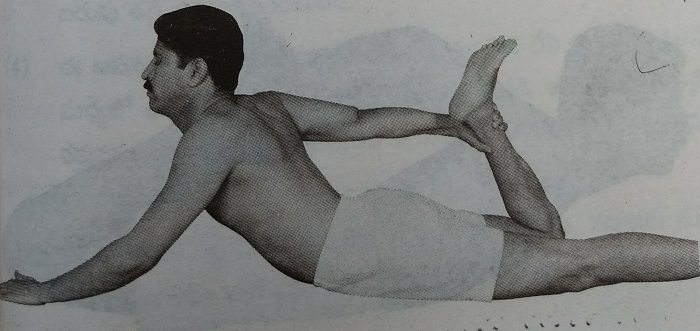
For those who have heavy calves, shoulders, thighs, it is difficult to hold the legs with hands. Some people cannot hold the legs at all. If you cannot hold the legs, you cannot do this asana. If you cannot hold the legs, instead of stopping the asana, try differently. Even for those people, dharusan is more helpful. Lie down downwards and keep the two legs a bit widely and hold with hands. First you fold the right leg at the knee and make the feet touch the buttock area. Then, stretch the left hand ahead of the chest, with the hand’s help, lift the chest and neck. Now, hold the leg heel with the fingers – if not hold the feet. Now, pushing the leg back, try to lift up the chest from the navel part. As long as you are in the asana, keep the hands and legs stretched. You can push the stretched left hand further or to keep the hand at the shoulders and to lift the chest up. You can stay as long as possible and to enter the rest state. For those who have belly, this asana is good for them. The belly touches the floor as a pillow, and is used to bend the waist back. Once you complete the asana to one side, then you have to do it to the next side as well.
Wrong state:
Only for small amount of people, there are chances of doing mistakes. As shown in the image, it is okay to hold the legs with hands, but as unable to push the legs up, the chest is not lifted up. When the chest is not lifted up, there is no use. To lift the chest well, make the hands hard (without bending), hold the legs tightly, push the legs back forcibly, and try to lift the chest. It will be easy to do the asana. If it doesn’t come like that, take the help of others, and if they lift our legs and pull up, our chest comes up. Then you stretch it well and hold it like that and ask them to leave. Like that in the complete dhanurasan, the boy gets good results. In this asana, pushing legs up and back. Then, there is no chance for mistake.
Benefits
1. This asana gives good results for people who have backpain, neck pain. It removes the pain in those areas and gives relief. You need to do this asana every day so that the pains won’t repeat.
2. By doing this asana, the extra fat in the leg calves will be melted. As long as you are in the asana state, the calves undergo pressure and good result comes. This is the best asana for calves to lose weight.
3. Those who want to reduce the body weight, must do this dharasan. Though sarpasan and shalabhasan are much difficult, in this asana, more energy is spent. As a result, there is a chance for more weight loss.
4. In this asana, as the front part and the back part are lifted up, there is more pressure on the waist part, good blood circulation happens in this part. With this asana, the waist becomes thinner.
5. Because of this aasana, the relationship between vertebrae, waist muscles, nerves get better, and the waist part comes under control. It will be bent as you like.
Note
1.Once you are completely free of tiredness, you will do shavasan.
2. Those who are learning this asana, can do for 2-3 days lightly and then try to stay for longer time later.
3. While doing these face down four aasanas, ensure that there is not much urine stored in the urinal bladder. If you feel there is excess urine in the bladder, you need to discharge it out.
4. We need to consider that these four face-down asanas are more important among all asanas. And, we should get good results from them everyday.
Shavasan
Once all asanas are completed, this savasan is used to give the body complete rest. We generally think that when we are lying down without moving, or sleeping with eyes closed, we think that we are taking rest. When we are taking rest like this, unknowingly, the organs will be moving. In the position of muscles moving like this, it is not possible to take complete rest. Rest is very important for everyone. Many people think that in sleep, they are giving the body rest. But, in these lives of tensions, people who are tired a lot in the morning, are still suffer in the night during sleep, in the pursuit of solving their problems. Such sleep won’t give rest. That’s why, many people, feel tired when they get up in the morning. The same state continues till the end of the day. Again, with the tired mind and body, they go to sleep again. And in the morning, they get up like that. This cycle will be running like this. Sleep is important to the body but more times of rest can be gained by other methods than sleep. Asanas are one among such methods. By doing asanas, there will be a co-ordination between the mind and the body and you will get rest. Our physical and mental states get completely transformed after we start doing asanas. Though we do asanas for one hour a day their effect on our life is tremendous – in terms of giving equilibrium. Despite any problems in life, we can handle them without tension and the mind and body always stay in a rest position. Yogasanas, pranayamam, and meditation all such things help us take rest.
Due to the work we do in the day time, the muscles are exposed to tension. The nerves also get tired. In addition, if we have mental tensions as well, their effect also will be on the body. Because of the mental tension, the body muscles get tensed. When muscles are tensed, they need more energy. When more energy is required, the lungs and the heart need to work more. As the body works more, we will become ill in a few days. When there are fear, anger and tension, the adrenal glands are aroused and as the muscles and blood vessels contract, the heart’s work increases. In the current situation, every is facing tension, so, the adrenal glands are working always. As a result, we face different problems. The immunity of the body comes down. All the digestion related ulcers are affected due to tenstion. To prevent all such things, and to enjoy happy life, we need to give rest to the mind and the body.
If we observe animals and children in sleep, we will understand what is ‘taking rest’. If children play, they really play; if they sleep, they really sleep. Elders while working, sleep in the mind and while sleeping, working with the mind. As a result, the energy is getting consumed through thoughts. That’s why, to control these thoughts, we need to focus the mind on body organs, and breathing. We need to keep the body at rest, without moving. Let us see what happens if we keep the body like that. When we don’t use muscles, the nerves which carry signals from muscles to the mind and the nerves which carry signals from the mind to the muscles get stopped. As a result, we will lose the physical consciousness. The more we keep the muscles loose without moving, the lighter state we can experience. The cells in the muscles, the nerve cells, all the cells of the organs are taking complete rest, and gaining more energy. As there is no work to the mind, it is also taking rest. If we focus on the breaths, body organs, the mind relaxes for some time, forgetting everything and takes rest. In this state, taking rest depends on the mind’s focus. As the mind is focussed on the body and breathing, the adrenal glands work properly. All these effects are given in the shavasana. After doing all these asanas, doing shavasana for 5 minutes, it gives more rest than we sleep at the night after working throughout the day. Shavasana is more useful in get rid of the tiredness that we get physically and mentally. You can stay in this asana as far as possible. Generally, if you stay in this asana for 5-10 minutes, you will get good results.
Shavasana: In this asana, the body will be lying down on the ground, wihout any body movement or muscle contract. Tht's why, it is called shavasana.
Method of doing: You need to lie down on the blanket facing the sky. Keep the legs slightly apart and stretch them straight. Stretch the two hands straight, and keepm them to both the sides. The palms should be open to the sky. Eyes to be closed.
Now, check if all your body is touched to the ground. This is a good way to keep the focus of the mind on the body.
First, observe whether your hip part is touching the ground or not. If the buttocks are stiffened, loosen them, and make sure that their weight is on the floor, and keep them at rest. Now, check for some seconds, if your right leg heel part is completely placed on the floor or not. Similarly, observe the left leg heel.
Now, check if the right hand, right leg, left hand and left leg, the back part, the shoulders, the back part of the head are touching the ground and focus on each organ for some seconds. Now, observe that the whole body is touching the ground. Now, observe that the right leg is heavy and it is stuck to the ground. Similarly, left leg, left hand similarly become heavy and are sinking into the ground. If the hands are making fists, keep them open. Keep the shoulders loose and do not feel any weight at all. Because, in tension, we keep the shoulders pressed. Don’t frown. If you frown, it means you are in tension. Don’t hold the bottom jaw tightly. Keep the mouth closed. Like this, keep all the muscles of the body in rest position. At this stage, if you are getting any thoughts, don’t suppress them, but divert them to other organs and breaths. Stay in this position for 5-10 minutes, and then open the eyes, fold the hands and leg and can get up from the asana, by folding legs and hands.
Wrong state: As shown in the image, the legs and hands should not be stiff.
14. Surya Namaskaras
The sun gives light and heat to the world. Without sun, there is no life on the earth. That’s why, man is working Sun, since ancient times. It’s an age-old tradition in all parts of the world that people are worshipping the sun. The God’s energy cannot be displayed but, the sun is visible directly. The sun’s light and heat is experienced by all. As he is the base of our lie, we give our homage to him by thanking him and respecting him. The sun’s three stages show the creation, existence and destruction. The sun rise shows the creation; the afternoon energy of the sun shows the ruling of the creation; and the sun set shows the destruction. The sun is indestructible. Every day, He rises and hen sets. Sun removes the darkness from the world and gives light, waking up the sleeping world. As there are so many specialities, the surya namaskaras are introduced in ancient India. In Ridveda and Yajurveda, it is described how to worship sun in the morning. There is a difference between the current day surya namaskaras and the ancient surya namaskaras. In ancient India, surya namaskaras were being done, with mantras and with fixed postures. The present day surya namaskaras are used as exercises. They are not part of yogasanas. But, let me tell you the relation between yogasnas and the surya namaskaras. Before doing aasanas and pranayama, if you do surya namaskaras, the stiffness of the joints and muscles will decrease and they will become flexible. They can dispel the sleepiness in the morning, and make the mind active. If it is not possible to do in the morning, you can do at your convenient time. When the body is tired or when the mind is irritated, if we do surya namaskaras, they will work like medicine to the mind and body. You need not prepare for the. As each part of the body is bent in surya namaskaras, in everyday life, the body will be natural while we sit, stand the lie down. Surya namaskaras give such benefits. So, it is better to learn about them and then do.
1. In surya namaskaras, there are 12 postures. These 12 postures represent 12 rashis. Each posture represents one rashi. In sun's journey, he stays in each rashi for 3o days, and after 30 days, he will move to the next rashi.
2. The speciality in surya namaskaras is: in each posture, the respiration happens automatically well.
3. These 12 namaskaras are to be done by reciting 12 mantras. Each surya namaskaram has one mantra. When the mantra is pronounced, its vibrations work on the mind and the body well. Apart from the surya namaskaras, if you pronounce beejaksharas, the mind becomes energetic. The 12 mantras and the 12 surya namaskaras are shown here:
1. Aum Mitraya namaha (Friend)
2. Aum Ravaye namaha (He who shines)
3. Aum Suryaya namaha (He who has beautiful glow)
4. Aum Bhanave namaha (He who has intelligence)
5. Aum Khagaya namaha (He who wanders in the sky)
6. Aum Pushne namaha (He who gives strength)
7. Aum Hiranya garbhaya namaha (He who has golden colour in the middle)
8. Aum Mareechaye namaha (He who is the king of the day)
9. Aum Adityaya namaha (He who is the son of Aditi)
10. Aum Savitraye namaha (He who gives benefits)
11. Aum Arvaya namaha (He who is powerful)
12. Aum Bhaskaraya namaha (He who gives ripeness)
Before learning these mantras, we need to learn to do these 12 surya namaskaras well. We have to check if the breathing is running according to the movements. Then, along with each surya namaskara, to check if the mantra recitation is happening well or not. In the last stage, we need to check if our movement, the breathing and the mantra are happening at the same time or not. If the mantra is recited loudly, then there will be result. If not possible, you can recite inside.
If you complete 12 surya namaskaras, it is completing one round. How many rounds to do, depends on our patience. From 2-3 rounds to 12 rounds you can do as many. Those who can do well, can do 12 rounds in the day. When you are tired, do not do much. If not in the morning, you can do anytime – only after 3 hours after the meal. Men or women or children, anyone can do them.
Method of doing surya namaskaras
1. Pranaamaasan:
Keep distance between the two legs, fold both the hands, doing namaskara, keep the whole body straight and stand. At this stage, recite the mantra - Aum Mitraya Namaha.
2. Hasta Uttasana:
Lift the folded hands up (namaskara posture), bend the waist and neck back. Bend the back a it backside. Recite the mantra - Aum Ravaye Namaha.
3. Paada hastasan:
From the top, bring down the hands to the ground, touch the ground, without bending the knees, kiss the knees. Recite the mantra - Aum Suryaya Namaha.
4. Aswa Sanchaalanasan:
Stretch the left leg backwards, keep the feet on the fingers, as far as possible, ensure that the knee is not touching the ground, fold the right leg at the knee, and place it in between the two palms, and holding the chest weight on the right leg, and two palms and bend the neck backwards. Recite the mantra - Aum Bhanave Namaha.
5. Parvataasan:
Now, push the right leg also backwards, keep both the legs touching the ground, lifting the chest on the hands, keep both the feet touching the ground, lifting the chest on the hans, bending the head inside, looking at the navel. Not to bend the two legs, and as shown in the image, ensure that the asana state is to appear. Recite the mantra - Aum Khagaya namaha.
6. Astanga namaskarasan:
Bring down the entire chest into the two hands, without touching the ground, the chest is to be held by the two hands. Similarly, the knees should also not to touch the ground. (If not, you can bend slightly at the knees, and touch the chest to some extent, and do namaskaram). Without touching the head to the floor, recite the mantra - Aum Pooshney namaha.
7. Bhujangasan:
Keep the legs not touching to the ground, lift the chest with the help of the two hands, bend the neck completely backside. Bend the chest completely backwards, so that the hands are aligned well. Recite the mantra - Hiranya gharbhaya namaha.
8. Parvataasan:
Keep the hands and legs like that, bringing the waist up, bend the head inside looking at the navel. Recite the mantra - Aum Mareechaye namaha.
9. Ashwa sanchalanaasan:
Keep the left leg between the middle of the two hands, stretch the right knee without touching the ground, keep the feet on the fingers. Bending the neck back, hold the chest weight on the two hands and and the left leg. Recite the mantra - Adityaya namaha.
10. Paada hastasan:
Now, bring the right leg as well between the two hands, lift the hip part, without bending the legs at the knees, keep it aligned, try to kiss the knees. Recite the mantra - Aum Savitre namaha.
11. Hasta Uttasana:
Bring both the hands together, lifting them up and standing, hold the hands lifted, bend the chesta and neck part backwards. Recite the mantra - Arkaaya namaha.
12. Pranaamaasan:
Keep the folded hands at the chest part, stand in the line and recite the mantra - Aum Bhaskaraya Namaha.
Note
1. Those who have neck pains and back pains, should not do surya namaskaras.
2. Those who want to do surya namaskaras, should first do surya namaskaras and then pranayama asanas.
3. If you do the above 12 asanas by reciting the 12 mantras quickly, it will be one round, If you are able to do 12 rounds, then it is very good.
4. When you don’t have time to do asanas and pranayama, on that day, you can do surya namaskaras in 10-15 minutes, 12 rounds.
5. Though asanas are done in surya namaskaras, these are actually not considered as asanas. They are treated as exercises. The great effect that comes in asanas, doesn’t come in them. In surya namaskaras, as we change the asanas quickly, and without stability we move the asanas, they are not treated as asanas.
6. You will get sweating, tiredness, shortness of breath in surya namaskaras, just as in physical exercise. So, it is better to do asanas along with surya namaskaras every day.
If someone serves us a meal stomach full with love, we thank them. When we are walking, if someone gives us lift, we thank them. Without expecting anything from us, if someone helps us in our job, business, we thank them by saying we owe them. We thank like that because we feel, it is our minimum responsibility. Every day, sun gives us light for 12 years. When that sun is not there, we pay some hundreds of rupees for the electricity we use. If we have to pay the sun for all the light he has been giving us light, can we pay? When the sun doesn’t come for four days, the environment and nature gets polluted. How much can we give him for cleaning up the pollution? Similarly, if sun is not there, no food is prepared on this earth. Likewise, he is helping us to make the food in the way we are able to eat. How much we can pay him for that? We cannot evaluate the help he provides us. He is benefiting us in such a way.
Are we thanking him for the benefits he is giving us? He is the sole reason for our very existence. Do we have the feeling that we owe him a lot? For how many people? He is the one who gives us life energy and giving us life. Our ancestors, after taking bath, would offer him water with hands for him, saluting him and expressing their respect. That is our culture. We are born in that tradition. So, every day, we need to salute him with two hands lifting up, reciting the 12 mantras, expressing our reverence, our gratitude. That is our minimum dharma. To keep our body health intact, we can add the 12 asanas to the 12 mantras and get health as well as happiness. What else can we do? So, we will do these surya namaskaras to uplift ourselves, submitting our reverence to him and live happily in the nature.
15. Who should do what asanas?
- Do Matsyasana well - cure neck pain
- Do Ustrasana well - Get sciatica pain cured
- Do 15 asanas every day - Lose 4 kilos of weight every month
- The upper part belly on the navel - Can be reduced with naukasan
- Don't stop asanas saying that no time - Atleast do 7 asanas a day
Among the important asanas that we are going to discuss, each asana gives a special result. Those who want to get the result, to do those important aasanas again in the evening. Let us see who should do what asanas.
1. Neck pain (Spondylitis problem)
1. Matsyasana
2. Ustrasana
3. Sarpasana
4. Bhujangasan
5. Dhanurasan
Those who are suffering with neck pain, till the neck pain is reduced, they should not do any other asanas – and to do only these asanas. For 1-2 months, they have to do these asanas twice a day, till all the pain is reduced. Once the neck pain is reduced, then, they can do other asanas, except these: sarvangasan, halasan, yogamudrasan, paschimottasan. After doing for 3-4 months, if they don’t find and problem, they can do the remaining 13 asanas, leaving sarvangasana and halasana.
If neck pain needs to be reduced quickly, you have to do the above mentioned 5 asanas, two times a day.
2. People with Back pain (Disc problems)
1. Ustraana
2. Sarvangasana
3.Bhujangasan
4. Vakrasan
Those who have back pains, should do the only the above-mentioned four asanas, twice a day. Till the pain is completely reduced, do ustrasana, bhujangasana 2-3 times in the morning, 2-3 times in the evening. Once all the pain is completely gone, do all the remaining asanas except these: the front bending paschimottasan, yogamudrasan, halasan, sarvangasan. Once the body is under control, then, you can do these fourl aasanas.
3. Those have sciatica
1. Ustrasana
2. Bhujangasana
3. Sarvangasana
4. Shalabhasana
5. Dhanurasana
Do these five asanas twice a day and stop all the other asanas. Till the problem is cured, do ustrasan and shalabhsan 2-3 twice in the morning and evening. Once the sciatica pain is cured, you can do all the asanas normally.
4. Those who want to reduce weight: Obese people must do asanas every day twice to make the body slim, beautiful and healthy. In the morning, they have to do the 15 asanas that were discussed. In the evening, as it takes much time to do all asanas, you need to do the following asanas:
1. Ustrasana
2. Supta vajrasana
3. Uttana padasan
4. Naukasan
5. Sarpasan
6. Shalabhasan
7. Dhanurasan
Apart from the above-said seven asanas, if someone wants to reduce shoulders, they have to do ustrasan; if they need to reduce waist, hey have to do ardha matsendrasan. Like this, twice a day, to do asanas for a good amount of time, if you do with focus, you can reduce 4-5 kilos of weight every month
5. Those who want complete health: To do the 15 asanas every day. Unless you do all the 15 asanas, there won't be effect on all the organs of the body. Those who do not do any physical exercise, can do these 15 asanas. It is enough.
6. Those who seek special results:Some people are lazy and cannot do 15 asanas, and don’t try them at all. They do walking and casually want to do one or two asanas. Similarly, people have problems specifically in some areas or over weight in some areas. They want to do asanas related to only those parts. For those people, the following asanas are useful:
1. To decrease the sides of the waist or handing folds – Vajrasana or ardha matsendrasan
2. To reduce the obesity in shoulders - Gomukhasan.
3. To reduce the weight in thighs – Supta vajrasan
4. To remove the belly under the navel – Uttana padasan
5. To remove the belly above the navel – Naukasan
6. To reduce the back part - Bhujangasan
7. To reduce the waist part – Sarpasan
8. To reduce the buttocks – Shalabhasan
9. To reduce the calves – Dhanurasan
10. To reduce the fat under the waist part – Ustrasan
All these asanas, said above, are not just for reducing the weight. For those who do not have over weight, for them, some special benefit is produced. For obese people, they will get their benefit. Those who have some problem in the body areas mentioned above, they can do those specific asanasan accordingly, so that those body parts will be affected.
7. Which asanas are to be done when there is no time?: Doing 15 aasanas every day, and on some busy day or when we are going on a journey, if you want to utilizet the 15-20 minutes, without stopping the regular routine of doing asanas, you can complete the following asanas in time. These asanas can give the good results for all body parts with movements:
1. Ustrasana
2. Supta vajrasan
3. Uttana padasan
4. Naukasan
5. Sarpasan
6. Shalabhasan
7. Dhanurasan
When you don’t have enough time, you can do these 7 asanas.
Though I have mentioned clearly, in what aspects, the above mentioned asanas are useful, in the book, ‘asanala vivarana’ (description of asanas), as they are scattered in the book, for your convenience, they are written here. All the 15 asanas we have discussed are important. But, when we seek special results, to provide details, this chapter is written.
16. Benefits of asanas for obese people
- You want to lose weight quickly? - Start your efforts with asanas
- Yoga is a great education - Don't do it as exercise
- Don't forget asanas - They are a boon to the obese people
- Don't worry about your weight - Start doing asanas
- To reduce fat in the thighs - There are special asanas
- After stopping fasting - To lose more weight, do asanas
- Lose weight wihtout any problem - Get mental peace
Many people are suffering with heavy weight these days. If a person has 10-15 kilos of excess weight, they don’t know the problems outside. If the excess weight is 20-30 kilos, then the joint pains, pain in heels, stomach weight, shortness of breath, fatigue start creating trouble. They will try to come out of them in many ways. Despite doing many efforts, the weight doesn’t come down and the problems are still persisting. People are suffering in a depressed state. If the body has excess weight of 20-30 kilos, it is like the fish tangled in the net. Because, once you have over-weight, if we reduce the food, we will have fatigue. To control fatigue, if you increase food, again, the weight increases. To reduce weight, if you do walking, there will be pains. To do exercises, it is not possible due to the overweight. To work more, again fatigue. If you don’t do exercises so that you won’t have any pains, then again you will increase weight. They cannot eat, cannot walk, cannot sit – they experience hell. The only way is – they have to sit and then to lose weight, and their pains also to be reduced. Is there a solution? Yes. To reduce the pains and weight, the food principles and asanas are to be done together. This method can give good results.
To reduce weight, many people do walking, do bicycling, do exercises. But, they rarely do asanas. When they look at the asana books, all the pictures, the twists and turns, they get disappointed as they think that it is not possible for them. This thinking is not correct. For over-weight people, asanas give a lot of support, just as for Lord Rama was supported by Hanuman. Yoga is what people can do by staying at home, sitting or lying down and can do it in a lighter way. But, if you do these asanas as exercise, then, you won’t get more results. If you learn to do asanas as aasanas, then the results will be good. If you are strong willed, you can reduce 30-40 kilos of weight in 8 to 10 months. So, you can say, reducing weight through asanas is good, but, we should learn the asanas and the body should bend, then only the result can be achieved. First, if this weight is reduced, then only the body bends and twists. Such kind of doubts people get. All the answers are in asanas.
As the obese people do not know the secret of asanas, they are not practicing them. The secret is: As far as possible, at your feasible level, if you do asana, you will get the result. From the first day, you will get the result. You need not wait for the result after you get perfection in asana or after you start bending well. Just as those who learnt the asana well and who is able to stay in the asana for 2 minutes, the person who started the asana newly, and who can stay in the asana for half minute, he will also get the same result. Let us understand this with an example. Let us see how it will be when we do paschimottasan.
The asana state done by the habituated person
Unbent state done by obese people
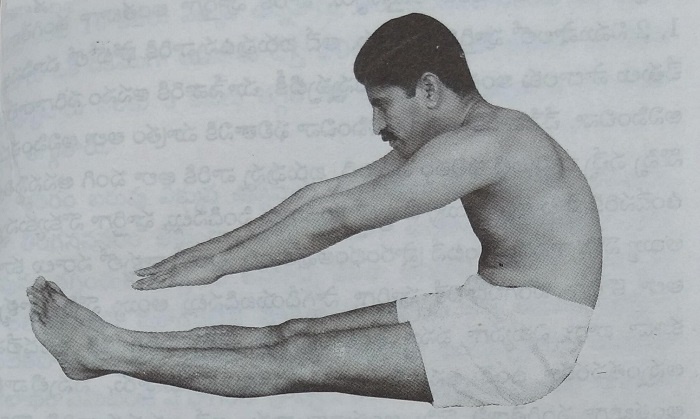
As shown above, ghe head should touch the knees, the two elbows should touch the ground and if you stay not moving, it is called paschimottasan. If you get that state, it means you are able to do the asana. This state cannot be get from the very first day. We get get it after practising for some months. If we get the results only after the day when we are able to do it so perfectly, then all the efforts of the obese people will go waste. Obese people, looking at the good asana positions done by other people, should not think that when can they in such a way. If we are going for aasana competitions, then we should think about the perfect asana position. Here, we want the result, not getting the correct asana position. If the asana is done fully, or half, or one fourth, all the three categories get the same results, provided you have to do it with focus and bear the pain till the position you could do and stay in the asana. This is the greatest advantage in asanas.
According to the position of the asana, those who have done the asana are staying in the asana till they are able to bear the pain, and then they are coming out of it. Unless they bend properly, they won’t get the complete pain in 1-2 minutes. In case of the obese person, as shown in the image, though the hands are far from the legs, and it may appear that the asana hasn’t come out well, the result won’t be like that. The result comes according to the pain experienced. As soon as the obese person bends in the asana, the stomach comes as an obstruction, all the muscles in the stomach get pressed and pain starts immediately. Similarly, the nerves in the legs get stretched and there is pain in the legs as well. They will stay in the asans as far as possible, and then they come out of the asana. For the lean people, unless they bend completely, they don’t get that pain. For the obese people, as they bend slightly, the changes in the body, the pain and the blood circulation, all happen in the similar way. What we need in fact are the internal changes that happen. They are the ones we need for our good. It doesn’t matter how far we are able to bend. As both of them get the same internal changes, both of them get the same results. If the obese people are able to do like this for some months, the body will be habituated to bend forward and the complete asana state can be achieved. Then, they need to bend completely well, then only they get the results. Initially, they would get the results, by bending this much. But, now, if you want to bend that much, you won’t get the results. So, those who are able to do asanas well, if they look at the new people, he should not think that he is not able to bend like them, Each of them will get the results accordingly. For obese people, more pain is experienced in less time. If they are getting more pain, it means, it is more difficult. Where there is more difficulty, there they get good results. So, people with more weight can reduce more weight. It means: those who have 10 kilos of excess weight and those who have 30 kilos of excess weight do the asanas in the same way, if the person with 10 kilos excess weight can reduce 5 kilos of weight per month, the person with 30 kilos of excess weight can reduce 10 kilos of weight.
Those who have overweight, no need to worry – they don’t need to roam anywhere, and they can stay at home and can reduce their weight by doing asanas at home. Whatever asana is done, we need to know the three things of the asana – doing the asana, staying in the asana and rest in the asana. If we know these three, we will get good results, even if we are not able to do the asana perfectly. Another benefit for over-weight people is: they can reduce the weight in whatever body part they wish to. They can make any body part thinner. Asanas has such flexibility. Apart from the body weight, if you only have more weight in the belly part, there are specific asanas to reduce belly. you can reduce it. For some women, all the body will be normal, except the thighs which will have lot of weight. To reduce the weight in the thighs area, there are specific asanas. Like this, anyone can make their body slim, healthy and beautiful with the help of aasanas. It’s time to start and make use of them.
If you do asanas in the desired way and in the optimum duration, the result will be more than you expect. Apart from weight loss, those who want heath to be bettered, they can follow food principles. If you want to bring down the weight speedily, if you follow food principles as well, the results will be more rapid. Following the food principles and doing asanas twice a day, one can reduce 5-6 kilos of weight easily. I have seen hundreds of cases like this. Even I have made some experiments on a few women and men to check how asanas work for weight loss. Those who come to me for weight loss purpose, I will tell them to have roti and curries without salt and oil. Along with it, I will ask them to follow other nature cure principles. So, after following those principles for 1-2 months, people are coming reducing 10-15 kilos of weight. For these people who have followed food principles for 1-2 months, we are teaching asanas and asking them to do them twice a day. People who are doing asanas like that are reducing around 5 more kilos in 3-4 months. Some people will be following only the food principles I teach them. With food principles, the weight gets reduced only in the first 2-3 months, then it stops growing as well as reducing. After 5-6 months, they will be doing fasting under my supervision. During fasting, their weight will be further reduced. After fasting is completed, they will be continuing the same food principles which they have practiced for 5-6 months. After doing fasting, in following the food principles, the over-weight people did not reduce weight further. It just stops there. We have taken those cases where weight is not reducing further, made them do asanas twice a day for one hour each, all the important aasanas in five types. With those asanas, they could reduce 5 kilos every moth, and could decrease their weight to the optimum weight. So, the weight that could not be controlled with food principles, is reduced with asanas in a rapid way. If we want to completely reduce the excess weight, the asanas help to reduce the excess weight completely. As the weight gets reduced every month (unlike the food principles where the weight is stopped at some stage), I have realized the greatness of asanas. If we have patience and desire, we can reduce all the extra weight with the help of aanas.
People with overweight need more life energy. The two lungs cannot give life energy to the whole body. In such a situation, to reduce over weight, if we can do workout or some physical exercise, the body needs more breaths than it requires. That’s why, obese people feel shortness of breath when they work or walk. Their heart also beats heavily. Like this, they will be having problems. If you don’t do any work, and sit or lie down at a place and do asanas, the heart doesn’t beat rapidly. Deep breaths happen and the body gets more oxygen in the asanas to the body. Asanas will help us reduce weight without causing any trouble to us. For obese people, their mental status becomes weak. With asanas, you can get complete mental peace. It is good to start the asanas which give us great benefits.
Keeping the obese people in consideration, to make them completely healthy, each asana is explained in their perspective. In the chapter, ‘asanaala vivarana’ (explanation of asanas), special advice and instructions are provided for overweight people. If you read them detailed, and follow food principles, I wish you can reduce the weight very soon.
17. Are food principles necessary for those who are doing asanas?
- Take nutrients well - Do asanas perfectly
- Don't eat cooked food - Natural food is good for health
- Take the alternatives - Cook the food tastily
- Eat in small chunks - Chew the food well
- Lead life in a greater path - Spend an hour everyday for asanas
The primary purpose of the asanas is to keep our body healthy and energetic. Because of the asanas, good blood circulation happens throughout the body, all the body organs work well and gain energy. When all the nutrients reach all the organs through the blood, the body gets energy. Without taking good food, what is the point in doing asanas? That’s why, let us now see, what sort of food we need to take for complete results.
Our food should be easily-digestible, and to contain all kinds of nutrients. In general, the food we take can be classified into 5 types: 1. Starch 2. Protein 3. Fats 4. Mineral 5. Vitamins. Our body needs all these 5 types of food every day. If our body gets all these types of food properly, we will get the energy to live healthily. These 5 types of food is available in the natural food – grains, grams, vegetables, leafy vegetables and fruits. When we cook and boil this naturally available great food, all their nutrients will die. Moreover, the ingredients that we mix in them when we cook food, such as salt, oils, spices, they will kill the nutrients of the food and spoil the value of the good food. That’s why, let us see how to take these food items without losing nutritional values.
1. Taking raw food: If we can take the natural food such as fruits, vegetables, grains, coconut etc., and make is 50% of our intake, it is good for our health. IN raw food, all starch, vitamins, mineral are loaded heavily. Eating raw food every day makes our digestion smooth. Similarly, the excretion activity happens smoothly. The body’ immunity increases.
2. Taking cooked food: By boiling the food, it loses the energy in it. Some vitamins will go out when boiled. If we eat boiled food, we lost some nutrients. But, if we add salt, oil, chilli powder, masala, they will obstruct our digestion process. As a result, there are more waste material stored in the body. Some people fry the curries more. As a result, the nutrients will die completely. The only carbon remnants will go inside. If you take such food, the health of the cells is affected. When the cells become weak, the body’s health will deteriorate. Many people take 100% of such cooked food. They also eat pickles. That’s why, though they are eating three times a day, they are getting affected by diseases.
3. The method to cook for health: As we are habituated to cooked food, though we eat cooked food, we need to ensure that the nutrients should not miss in them. Let us see what changes we need to do and what measures we have to take.
1. Not to used polished wheat.
2. While cooking curries, to use less water and to ensure that they are boiled with water vapour and at low flame.
3. When leafy vegetables are boiled, water comes out. We have to use the water without throwing it out. We should stop frying food items in the oil.
4. We should stop adding salt, oil, sour, masala, sweet, chilli power. Instead of salt, you can add, milk, curd, lemon, tomato. Instead of oil, you can use seseme powder, ground nut powder etc. For sourness, instead of tamarind, we can use raw tamarind, raw mango, lemon, tamarind leaves etc. Instead of sweet, we can use honey, dates, and for chilli powder, we can use green chilli. If we use fresh natural food items instead of these things, dishes will be tasty and healthy. Milk and curd can be used as much as you like.
It is better to take 50% of cooked food daily. Apart from food, water is the other thing which takes care of all the important things We need to drink water enough every day. We need to drink at least 5 litres of water so that it will be helpful to the body.
So far, we have talked about vegetarians. In the society, there are many people who are habituated to non-vegetarian food. They may have a doubt – cannot they do yogasanas while eating non-vegetarian food? Non-vegetarian food may contain proteins, fats and vitamins. But, eating it gives more bad effects than good. In fact, compared to non-vegetarian food, there are nutrient values available in vegetarian food. That’s why, we don’t suggest non-vegetarian food. For the body, only vegetarian food gives complete energy, peace to the mind and the body.
So far, we have seen what food needs to be taken. Now, let us see what food items not to be taken:
1. Polished rice, wheat, polished flour
2. Cakes, bread, backery items
3. Sugar and sweet items and liquids made with sugar
4. Not to eat processed food items. The ingredients used for taste, smell and preservatives are chemicals which damage the body.
5. Cool drinks and ice creams
All the above items should be compeltely stopped eating.
Preparing the food carefully is one thing and eating carefully is another. We need to follow certain rules when we eat the cooked food.
1. Eat in small chunks and slowly.
2. Chew the food well before swallowing.
3. While eating, not to talk with others.
4. While having food, we should not think about our problems and miseries. When we are angry or irritated, we should not eat. While we are having meals, we should be peaceful. It will help us digest the food well.
5. We need to drink water half an hour prior to the meal. We should not drink wanter till 2 hours of having food.
If we do one hour asanas every day, the blood circulation happens to all the body parts and all the waste will be removed. As a result, the organs get new energy. The energy that we get like this, is misused by eating any other food items and to digest them in a wasteful way. The energy and capacity that we acquire through asanas, is to be used to preserve our health, and to lead our life in greater path, instead of enjoying the tastes. The good effects that we gain through asanas, we should not limit to that one hour but, we can retain them for the whole day by following the food principles. If we follow food principles as discussed above, the breaths don’t run rapidly, and they run deep and slowly and as a result get mental peace. For those who do asanas, they can digest even stones. So, even some teachers and students think that they can eat anything. They have the opinion that if they do asanas daily, they won’t be affected by any diseases. The energy will be intact. With this opinion, they neglect the food part. That’s why many people who have been doing asans, are not able to live 90-100 years without good health. Our ancient yogis who have done asanas with food principles lived for 200-300 years. So, to get permanent results from asanas, it is important to follow food principles. I wish you all do asanas regularly and simultaneously follow the food principles and get good results.
18. Doubts - Clarifications
- Pains to be cured quickly - Do asanas 2-3 time
- Do asanas properly - No need of physical exercise
- For immediate asanas, don't do asanas - they will be cured if given rest
- To do sadhana without loss of effort - Takes 2 months for perfection
- Cover the food problem with food - With asanas give life energy
- With walking the weight will be on the joints - For joint pains, asanas are a boon
- If you don't move, it is the asana - The result won't be like exercise
- With teacher's supervision - Will get good training for practice
- No connection with age - Be ready for the asanas
- Though there is no sweating - heat is generated inside
- Do pranamya - Be prepared for the asanas
1. Can women do asanas during menstruation?
Answer: You should not do asanas for those four days. You can do from vajrasana to pranayama. To do shavasana twice a day and take rest. During the periods time, the uterus will be very delicate. If you do asanas, more pressure will be on the uterus and blood flow happens. As a result, you may feel fatigue. So, it is better to take rest during those four days.
2. Can we do the same asana once again, for 2-3 times? How many times can it be done?
Answer: It is okay to do some asanas like that. Each asana gives some special effects. If we want to give more good results for a particular body part, then we can do the asana again. For example, people with back pain, should not do all asanas. If they have the desire to cure it fast, and do the asana again, it is good. You can do the back-related asanas 2-3 times like that. When we said, 2-3 times, it is not advisable to do it fast and quickly. In each time, you should stay in the asana as far as possible. Take complete rest do the asana again. For overweight people, there are some specific asanas. Those people can do some asanas 2-3 times.
3. Those who want to do surya namaskaras, should they do them before asanas or after asanas?
Answer: Some people would do them before asanas and some people do them after asanas. There is no wrong in doing them any time. But, there will be difference in gaining the benefits. To get good results, we need to do them before asanas. Compared to surya namaskaras, we gain more benefits from asanas. We have to change them according to get more results in asanas. Surya namaskaras work as exercises. Exercises and surya namaskaras help the muscles, bones to get free. With these exercises, if you make the body free, then the body will be prepared for asanas. So, if you do surya namaskaras first and then do asanas, then you can do asanas well. It will help to stay in the asana for a longer time. So, it is good to do surya namaskaras before asanas.
4. Those who do asanas should do other exercises and walking? or asanas are enough?
Answer: Those who are doing asanas, can do other exercises or walking, but in fact, they are not necessary. Because, if you do asanas perfectly well, any other physical exercise is not necessary. With asanas, we can get all the benefits that the body needs. Then, why waste time for other things? If you have more time, you can do four more asanas, that will be better. Those who do walking or exercises, should learn asanas, because they cannot give complete benefit to the body. Those who can do asanas well, they need not waste time for other things.
5. Can those who have heart disceases and high BP problem, do asanas?
Answer: Though you have heart problems, you can do asanas. But, you need to do limited asanas. Some asanas are not be done. Among heart patients, there are different types. According to their problems, they need to check with the teacher what asanas can be done and what not. Similarly, high B.P. patients should not do aasanas. Initially, one should follow some food principles, and after the problem is cured a bit, you can start asanas. Those who is mild problem, they can do all asanas. The should check in between, and know the status.
6. When we have immediate disceases, should we do asanas or not?
Answer: When we have fever, it is better to stop asanas. In fever, the body will have pains and it will be heavy. At that time, if you give the body rest, during the rest, the body will cure its fever. When we have cold, we need not stop asanas. But, when we have the cold problem, we cannot breathe properly. So, in asanas, we get tired fast. Still, you need to do asanas without stopping. If you are suffering from cough, you can do asanas. In some asanas, the phlegm moves. When we have cough and phlegm, we cannot stay in the asanas for more time. When we do asanas, we feel fatigue. When we have cough and phlegm, we need not stop asanas. If you feel like taking rest, then do not do asanas. When you are suffering from headaches, you won’t have mental peace. When we don’t have mental peace, there is no point doing asanas. So, it is better to take rest till headache is cured.
7. In how many days, can we learn asanas?
Answer: Learning asanas is different and getting perfection in asanas is different. For gaining perfection in each asana, it may take months. Asanas are hundreds of types. To learn the most important asanas, we just need days. From the teacher, we can learn the expertise, i.e., doing, coming out of asana, the systematic way, taking rest etc. and then according to the rules, we need to practice the asanas, we will get completeness in them. For learning asanas, it won’t take more than 7-10 days. Remembering those points, it is better to do then regularly. If you want to learn asanas under the supervision of the teacher, you need to take training for some months.
8. Some people say that we can cure all diseases with asanas. How far is it true?
Answer: It is not true. If we get diseases just because of the physical problem, then asanas can solve those problems. And all diseases will be cured. But, for diseases, there are many reasons. Thinking that all diseases can be cured with asanas is wrong. In such a case, throughout the day, those who are working under the sun and sweating, they should not have any diseases. But, it is not the case. The diseases that we get through food, should be solved only with food, and not with asanas. The problems that need to be solved with asanas cannot be solved with food. The body is a mix of all. It needs all. So, we need to give all. If asanas are all, then it is a mistake. To attract people, some people tell like that. We should know with our experience how useful they are.
9. Can anemic people do asanas?
Answer: If the blood report shows 7-8 grams or lower, then they should not do asanas. For anemic people, oxygen doesn’t reach the body well. As a result, they will have shortness of breath. In such a situation, they will feel tired during asanas and they will feel fatigue. Even if they do, they cannot do well. They won’t get much benefit. If they have blood percent from 8-10, they can do some asanas easily. They should do those asanas and make changes in the food, then the blood percentage increases. For such people, pranayama helps a lot.
10. Apart from the asanas you have told, can we do any other asanas?
Answer: We have mentioned here the most important asaans, but there are many other asanas to be done. If I tell all asanas that I know, then you will be scared. That’s why, I am telling only a few. It is of course okay to be limited to these asaanas. If you have enthusiasm, interest and time, you can learn more aasanas and can do more. Doing other asanas is obviously good. There is not problem. If you already know other asanas, you can do them along with these asanas.
11. For people who have joint pains, is walking good or asanas?
Answer: Those who have joint pains, should not do walking. If they do walking, it affects the joints more. The worn out joints become more painful. For those who have joint pains with overweight, the problems will be more during walking. For such people, asanas give good results. For many people, asanas means, padmasan, vajrasan etc. They think that asanas are not for them, as their joints cannot be bent. Asanas will be according to the people, who wish to do. There are some asanas which everyone can do by lying down. Similarly, there are some asanas which we can do by lying with head down. For those who have joint pains, they can do asanas without their joint pains affected and to help the rest of the body. Asanas are good for them.
12. If we want to do walking, should we do it before asanas or after them?
Answer: Many people are habituated to walking. If they don’t do walking for one day, they feel deficiency on that day. There are people who get more results by walking. So, they don’t want to stop walking. In fact, no need to stop walking. You can complete walking first and then do asanas. After walking, the body gets heated up, and with sweating the muscles will be flexible. After you get such a situation in walking, it is better to do asanas. Then, asanas will be smooth and pleasant and while doing the asanas, the air goes well inside.
13. Why are asanas done like exercises these days?
Answer: Human mind will be always running. It has less stable. Asana means, sitting in a posture firmly. One needs to sit without moving for some time. Nowadays, for many people, sitting without making any movements, it is very difficult. For them to do asanas, their mind won’t allow. As a result, for such people, the asanas are a bit modified with some movements. In the asana, they are counting 1,2,3 so that some movements are being generated. If there are movements, it will be an exercise. If there are no movements, then it is asana. Some people think that if movements are made like that, then, they can learn asanas fast. Many people think that if there are such movements, the results will be better. They want to do asanas like exercises where there will be all kinds of movements. But, they won’t get the asana result, if they make movements.
14. When we are doing some asanas, there will be spasms in calves and below the lungs area. Why?
Answer: When we do asanas, the muscles will expand. When we do some asanas, according to the asana style, the muscles will be stretched. So far the muscles were still and not moving and all of a sudden, if it is stretched, the spasm happens. In the initial days, this problem comes. Once you are habituated, you won’t have this problem. In the paschimottasan (i.e., while sitting, stretching the legs, and kissing the knees), for some people, the spasm will be in the ribs. In shalabhasan, when the legs are up, the spasms will be in the calves. After 7-10 days, they won’t cause us any trouble.
15. Should we learn asanas only under the supervision of the teacher?
Answer: Yes. If we do under the supervision of a guru, we won’t feel fear. Otherise, we will have the doubt whether we are doing right or wrong. It will trouble us. Doing asanas by reading books is difficult. Gurus have been in practice for many years, so, they can help us with their experiences so that we can get good understanding. While we are learning, they will explain our mistakes. When we do them by looking at the books, we won’t realize our mistakes. If we don’t correct our mistakes, we will be habituated to them. If we do like that, we will be facing some problems. If you already have the experience of learning with any guru, and the previous experience of doing sadhana, then you can use my asana book and can do sadhana. You need not go to anybody again. For those who do not have any idea about asanas earlier, they should read the book completely. If you have an opportunity to learn asanas for 10-20 days, you can go and do the asanas there. You will get some experience. You will lose fear. To that experience, add my techniques and do the asanas. If not, if you don’t have time, or if you don’t get a guru, you read the book completely, remember all the techniques, and if you do not have any doubts, you can do at home, some light asanas. After some days, learn other asanas as well, and if you have any doubts, get help from others or you can contact me through a letter or phone. In the book, the description is clearly given without any mistakes so that anyone can learn them by sitting at home. Anyway, do in whatever way, according to your facility. But, what is suggestible is to learn asanas under the supervision of a guru.
16. At what age can asanas be done?
Answer: Asanas are not connected with age. Asanas can be done by children to old age people. If parents do asanas at home, children will learn from them. If children are taught asanas at this age, and make them do regularly, their life goes well. If asanas are done in a systematic way, the mental change. They excel in education and physical activities. Similarly, the retired people if they do asanas for 1-2 hours, at that age, their energy gets revived and the health will be good. If asanas are for their aid, they can spend their remaining life happily. However, if asanas are not done, despite the age, all people lose something valuable in their life.
17. If we stop asanas for some months, do we gain more weight?
Answer: This problems is not in asanas. It is no harm doing asanas for many years. With asanas, people won’t have excess hunger. The appetite will be same before and after doing asaans. Eating won’t change before and after doing asanas. But, in case of exercises, it changes. If people do heavy-tiring exercises, the stored fat gets consumed and to replenish it, they will get more hunger. As a result, the food intake quantity changes before and after doing exercises. If we continue the exercise and eat heavily, it will be burnt and it won’t turn to fat. But, after some day, they will stop doing exercise, but they won’t reduce the food quantity. As a result, the excess food will not be burnt and will be converted into fat and it will be stored in the body causing to overweight. If you are habituated to 5-6 idlis, it is difficult to be content with 2-3 idlis. Through they stop exercise, they don’t reduce the food quantity. That’s why, the body size increases compared to earlier. But, it doesn’t happen in asanas because, unlike in exercises, the muscles won’t stretch in asanas. The body gets contracted. After stopping asnas, it won’t do any harm if you take time to resume them again. It is not harmful.
18. If we don't get sweating during asanas, are we not getting any benefits?
Answer: When we do asanas, we generally sweat less. In summer, we get more sweating. In other seasons, we just feel the heat is generated inside. For only some people, sweating can be seen. We generally feel that only when we sweat, we feel the physical activity is done. In exercises, we see sweating. In asanas, without the outward movements, movements happen in the inner organs, and changes happen in the blood circulation. That’s why we won’t sweat. If we don’t sweat, it doesn’t mean that we are not getting the benefits. The inner benefit is what we get when we feel it. When you are doing asanas, don’t expect to get sweating. If you do your activity, the inner changes that are supposed to be done in the body will happen.
19. Those who do physical work need not do asanas?
Answer: In physical activity, the results are different and in asanas, the results are different. With physical activity, we get tired. We may get fatigue. But, by doing asanas, we will get more energy. Especially, the oxygen will be filled in the body. Through asanas, we will get mental peace, control on the body. Despite doing heavy physical activity, it is good to do asanas if there is an opportunity. As a result, you can do that physical activity with more activeness. By doing asanas, the mind will be more aligned to the body. As a result, whatever activity we do, the mind will be focussed on it. You can get such a great benefit from asanas and can do the daily physical activities with more efficiently and effectively and with more ease.
20. If we need to do asanas and pranayama daily, which is to be done first?
Answer: It is better to do pranayama first, and then to do asanas. Some people do asanas first and then do pranayama. In whatever order you do it, it is not harmful, the asanas will yield few profits. If we do pranayama first, the profits will increase more. Whether pranayama is done before or after, there is no additional benefit for pranayama. Let us see the benefit that we get when we do pranayama first. With pranayama, we get full oxygen to the body. As a result, deep breaths happen. After doing pranayama, the number of breaths will reduce considerably. Similarly, the mind becomes so peaceful with pranayama and it is not affected by the agitation of thoughts. In a way, pranayama prepares the mind to a peaceful state. In pranayama, the lungs get good contraction and expansion. By creating such mental and physical state in the pranayama means, it is 20-30% more beneficial to the asanas. When the oxygen is more stored in the body, we can stay in the asana for a longer time. We won’t get tiredness and shortness of breath immediately. In the asana state, the mind doesn’t do any other thoughts and can focus only on the asana and the body. As long as we are in the asana, the mind can observe, with focus - the changes that happen during the asana state. Even during the rest state, if the mind is peaceful, the nerves will be more energetic. If we do pranayama first, deep breathing runs in the asana state. In pranayama, the body will become heated up and waste matter will be moved. Now, during the asanas, there is an opportunity for them to move out of the body. If we do pranayama first, there are benefits to the body and the mind. The physical and mental changes that happen in pranayama will help the asanas in a better way.
Experiences - Feelings
Day-long joy
My name is Vishala. I am 33 years old. I have an interest on asanas since my childhood. During childhood, for me, asanas were like making poses. I also wanted to try posing like that. For the first time, when I was studying 8th class, I learnt some asanas, practised for some time and then stopped doing them. 5-6 years ago, I did asanas for some days, following a book. I stopped them because, no one told me how valuable they are to the mind and body. While doing asanas, we need to focus on the organs. I didn’t even know that the mind should be focussed. I only knew that if the posture has come out well as instructed. That’s all I knew.
I couldn’t show interest in doing asanas, even after getting married. Though I have been following the food principles, I knew that I am not completely healthy. If I would do more work, I used to get tired and face fatigue. Sometimes, I used to get sciatica nerve problem. I felt that I should also come out of all these problems and want to become completely healthy like my husband Dr. Manthena Satyanarayana Raju garu. Moreover, I am a doctor by profession. If I get tired frequently, how can I advise my patients? I felt that if I do asanans daily, I will become perfectly healthy. Then, I started learning them with interest. While learning them itself, I felt very satisfied. When I was doing each asanas, unknowingly for minutes, the mind and the body would undergo great joy. After getting habituated to asanas completely, I have started observing the greatness of the asanas. The true joy of the asana is known in the rest state after doing the asana. Without our conscious effort, the lungs will exhale and inhale full of oxygen. When we do asanas, the contracted body parts will received more blood and become pleasant. The mind will become still and peaceful. Many people tell us to change to the next asana when one asana is completed. But, they never tell us to relax. In the method that Dr. Raju garu suggest, it is special to close the eyes while doing asanas and to relax after doing the asanas. Because of these two things, we will get more results. While doing the asanas, the mind will be very happy. Doing pranayama first, and doing meditation and asanans. It would take 2 hours for the whole thing. If we are able to control the mind for 2 hours like this, the results will be great. Its effect will on the rest of the day. The mental peace and the activeness in the body will continue for the whole day. The benefits that asanas do to the body are immense. The joy that I experienced in doing asanas is a great experience to me. In the 3rd week of my starting the asanas, all my fatigue is cured. I am able to do all tasks actively. Sciatica pain is also cured. Unlike others, Dr. Raju garu has taught some very important and useful asanas in an easy method. Anyone can practice them easily. Through nature cure method, Dr. Raju garu has been inspiring people and making them healthy, and as part of the activities, he is teaching asanas and pranayama in a simple way. My deep-felt thanks to him him for all the efforts he is making for the welfare of the people.
Dr. Manthena Vishala,
Hyderabad.
Could reduce weight
Good Morning to all!
My name is Uma. Age 46 years. 20 years ago, my health was affected. Since then till 1996, when I met Dr. Manthena Satyanaraya Raju, I suffered a lot with different diseases. Along with the ill health, I became over-weight. By the time, I met him, my weight was 75 kilos. Under his supervision, I did fasting for 18 days, and I could lose 5 kilos of weight. After completing fasting, with the food principles, my health was becoming better. All the earlier problems were cured such as allergy, joint pains, shortness of breath, ‘neerudu manta’, bloating with water, but my body weight was not reduced. He suggested me to do asanas and taught me all the asanas to do in an easy way. Since then, I have been doing aanas every day, twice a day – one hour morning and one hour evening, with complete focus. As I did asanas like this, in 5 months, my weight reduced from 75 kilos to 53 kilos. I could lose 3-4 kilos a month. Earlier, the belly was loose and the body was not stiff. With asanas, the body is not stiff, the belly is stiff and the stomach has come to the regular size. I felt very happy and surprised that in such a short time, the weight could be reduced in an unimaginable way. Since then, I did not stop doing asanas for a single day. That’s why, in these 5 years, there is no change in my weight. My weight is now according to my height and I am happy and healthy. As I got all the health benefits from doctors’ natural life style, I have been helping others with that inspiration. I am trying to share my joy and experience with others. I am feeling it is a privilege for me. I wish you all learn and practice the food principle and practice asanas by knowing their values.
S. Uma,
w/o.Suryanarayan Raju,
Amalapuram.
Health is improved with asanas
I am M. Malla Reddy, working as a stenographer in secretariat, in Hyderabad.
I met Dr. Manthena Satyanarayana Raju in August 1999, through my colleague R. Bhujanga Rao. Dr. Raju garu has spread the natural way of life style through his four books in an easy way so that all walks of people can understand.
I have realized through doctor’s discourses that by making changes in the food and drink intake, we will get great benefits and the harmful effects of the food that we take for tastes. Earlier, if there was not enough salt in the curry, I used to add a spoon of salt and eat. Because, I was so fond of salt. But, when I learnt from the doctor that the salt that we use in the curries for tastes, causes us so harm. I have realized my mistake and since 2-9-1999, I started to eat without salt for one time and with salt for the second time. From 24-12-1999, I started to eat two times, of the day, without salt. I also learnt to do asanas. Because of these changes, I could see a lot of good change in my body.
After changing my food, I could reduce 2 kilos of my weight. After doing asanas, I reduced 3 more kilos. Three inches of my stomach width is reduced. Sharpness is improved and my face glow is also changed. Earlier, even when I changed my diet, I could go for motions only for once a day. After doing asanas, I am able to go for 3 times. Moreover, earlier, I used to feel that my blood was thick. Now, I feel that my blood is less thicket and red. My mind is peaceful and I am active day-long. After looking at all these changes, I have realized that apart from changing the food habits, it is also very beneficial to do asanas. The asanas that doctor has taught are so easy and anyone can practice. Among all the asanas, though I am doing nine asanas, I am able to get good results. For specific body parts, if there are any problems, as doctor has said, we can cure the problems with the help of these asanas. I wish you also change your mind and come to this life style and lead life happily.
M. Malla Reddy,
K.P.H.B. Colony,
Hyderabad.
Perfect health with limited asanas
My age is 65 years. I have been doing asanas and meditation for the last 30 years. Since my childhood, I have been very careful about my health. I used to follow all health habits whoever tells me. With the acquaintance of Dr. Pratap Kumar, I got interested in the teachings of Dr. Satyanarana Raju about natural cure method, I and my wife, who is 60 years old, have started following these methods for the last three years. Though I don’t have any health problem, considering the future health and my age, I am practicing these methods.
The people of present day, in the name of civilization, have forgotten the healthy natural food and are habituated to the artificial food and getting ill. Along with the good food, we should have enough physical activity and rest and mental peace for health. In this current active, civilized, fast world, people are not working enough and are leading pressurized lives, and are being affected by many diseases. To solve this problem, we can regain our health by doing yogasanas, pranayamas, meditation.
Since ancient time, many people have been telling us about the benefits of yogasanas. In the current human lives, it has become so tough for humans to follow all good habits and are not able to get good health. That’s why Dr. Satyanarayana Raju garu is suggesting only most important yogasanas In the limited time, we all can do these asanas without any inconvenience. There is a widespread opinion in the people that yogasanas, pranayama and meditation are to be done by rishis who has left everything, and to be done by the householders. But, Raju garu proves that this opinion is not true, and yogasanas can be done by all and to get best results from them. He is suggesting some asanas which can be done by everyone such as – matsyasan, vakrasan, yogamudrasan, gomukhasan, supta vajrasan, ustrasan, paschimottasan, pranasan, bhujangasan, sarpasan and dharurasan.
I have the habit of doing asanas for a long time. I add some more asanas to the list of Sri Manthena Satyanarayan Raju and do every day. If I don’t do yogasanas, I feel dissatisfied and the body will be heavy and non-enthusiastic. Along with me, my also does the yogasanas. We are getting good health and joy through yogasanas. We thank Dr. Raju garu for providing us joy and health in our lives.
B.V. Satyanarayana Raju,
Advocate, Kuppanapoodi,
Aakiveedu mandal, West Godavari district
Leg pain - complete cure
My name is Laximkanthamma. My age is 43 years. I am working in a bank. For the last two years, I have been following the natural way of life style by Dr. Manthana Satyanaraya Raju. I could successfully come out of the health problems and I am happy now.
In 1995, my right leg started paining me. It was extreme pain, which was unbearable. I couldn’t sit, stand and I used to suffer a lot. Despite using many medicine, there was no result and I had undergone the laminectomy operation. After the operation, I was well for 6 months. Then, the pain started like before. Gradually, I couldn’t move at all. When I consulted a doctor, he told me that there was an infection in the area wehre the operation is done. Despite using many medicine there was no use. I have consulted many orthopaedic doctors. Many of them told that, it may not be cured. In such a situation, I could not do the job and took leave and spent time in the bed. Fortunately, in 1999, I could meet Dr. Manthena. After following some food principles, still there was pain, on the advice of doctor, I started fasting. After one month of starting fasting, I got some relief. By then, I have been on leave for a long time, I had to join the job. While the fasting was going on, I joined my job. It took 95 days for my fasting to be completed. But, I could do them successfully. After fasting was completed, though the pain was cured, it could not be cured completely. After three months of fasting, doctor has taught me to do asanans. As suggested by him, I started doing asanas daily. In the first 2 months of doing asanas, incredibly, there is change in the leg pain. The pain was almost cured. Earlier, I used to have neck pain. I couldn’t hold anything. Now, my neck pain is also reduced. Now, I am completely healthy and I am able to do all my tasks. I am able to do my job well without any problem. I simply forgot my leg pain.
Doctor has given me new life. Every minute, I remember him. During my difficult time, he gave me courage and helped me take up this method. I owe him a lot. I pray the God to grant him perfect life span and health.
Laxmikanthamma,
Hanuman Tekki, 4-1-77,
Troup Bajar, Hyderabad
Good for implementation
I think it was August, 1999. My co-brother-in law, GVSR Krishna, and his wife Vimala Krishna, were doing fasting in the naturopathy hospital of Jubilee hills, under the supervision of Dr. Satyanarayana Raju. I went there with my wife, to see them. I met Dr. Raju ono that day. The natural way of life is really marvellous. For the first time, I have strongly decide to follow his foot steps. For 6 months, I had salt-less food. Then, under the supervision of doctor, I have done fasting for 30 days. After fasting, my health was quite good.
Doctor garu has taught me yogasana, pranayama. Earlier, Suri Raghava Dixitulu garu taught me pranayama and yogasana. I put aside the yogasanas what Dixitulu garu has taught me. Because, I liked the scientific reasoning and conviction in the pranayama and asanas that Dr. Raju garu has taught me. What doctor teaches is a special technique. After opranayama and yogasanas are done, we will sweat a lot and the mind becomes very peaceful. That feeling, we cannot express in words.
He taught us 10 yogasanas.They can be done by all age groups of people. All will get the results same. By doing yogasanas, I am feeling very enthusiastic. Every day, I will get up at 3 am and do pranayama and yogasanas. Then, I do meditation. Pranayama helps meditation a lot.
Dr. Manthena Satyanarayana Raju reminds me Ramana Maharshi. Suffering from complex problems in life, many devotees used to come to him. With a smile on his face, he used to say, ‘know yourself first. All problems will be solved’. The devotees would take a sigh of relief. They used to return home happily. This is similar here. Many people come to him with chronic diseases. The diseases can be anything – however chronic it may be. He would say with a smile, the same thing, ‘It will be cured. I will definitely be cured. All your problems will be completely cured’. They would ask, how can they be cured - such hard-core diseases? He says, ‘drink water as I suggest – eat as I suggest’. What a short formula. Simple formula. Not at all expensive. No doctor’s consultation fee. I usually feel – if all people follow doctor’s life style, no diseases will be there – similarly, there won’t be any mental illnesses. Mahatma Gandhi’s society of equality will be established. All people will be pure. They will become like pearls. They will become with an ideal lifestyle. This will be done. He is lord Sri Krishna. I pray the doctor couple will get infinite of energy and they get enormous energy to pursue the social cause.
M. Vishnu Prasad,
8-3-430/1/4,
Ellareddy Guda, Hyderabad.
With asanas, weight is decreased
My name is Kamala. My age is 27 years. I am a doctor by profession. From the age of 15 years, my weight started growing. Five months ago, my weight was 91 kilos. To reduce my weight, I have done so many efforts, but, no use. After I met Dr. Satyanaranaya Raju garu, I became confident enough to reduce my weight through naturopathic life style. I joined the Jubilee Hills nature cure ashram, and eating as he suggested me and started doing asanas. In the week days during my stay in the ashram, I could reduce 2 kilos of weight. Then, under the supervision of the doctor, I fasted for 20 days. After my fasting was completed, I could reduce 8 kilos of weight. The body has become lighter and active. Since then, I have been following the food principles, and every day, I am doing asanas for 1 hour along with pranayama. I am doing asanas in the evening, whenever it is possible. Now, my weight is 76 kilos. In this method, in three months, I could reduce 5 kilos of weight per month and three months, I could reduce 15 kilos of weight. I got the confidence that I can reduce more weight. Through doctor’s discourses and his books, I have learnt so many things which as a doctor I didn’t know. I feel that this life style is ideal for all people and is practical to implement, and all people need to implement this. We owe him a lot for the unselfish and pure-hearted piece of advice that doctor has provided us. Along with me, my family members are also following this method. My sister-in-law followed these food principles and doing asanas could reduce 5 kilos of weight. Through his discourses, he is doing a great service to the mankind. I wish his services are more useful to the people.
Dr. Kamala,
G-2, Doomej Apartments,
Shivagiri, Malkajgiri, Hyderabad.
With asanas, all pains are reduced
My name is Manthena Suryanarayana Raju. My age is 50 years. At the age of 20 years, I developed my back pain. After 10 years, asthama has started. Then, mouth ulcers are started.
In 1996 December, pain started at my buttock. As the pain increased, I consulted a doctor in the NIIMS hospital. He suggested me bed rest and prescribed some medicine. But, still, it was not controlled. That’s why, in 1997, I had undergone operation to my back. After two months of my operation, the side effects have started. I could not sit on the floor at all. I was suffering a lot with the pain. I used to have left leg and left hand pain, back pain a lot. When I consulted the NIIMs doctor, he prescribed me many medicine and suggested me to do some kind of exercises. But, the problem was not cured. Unable to bear the pain, I stopped doing the job after some time.
One of my relatives suggested me to get naturopathic treatment. I went to the nature cure hospital in Jubilee Hills. On 20-2-2000, I listened to doctor’s speech and from that day, started drinking 5 litres of water, stopped drinking tea and coffee. I read the four books of doctor and started following the method. Before I entered the naturepathic method, I used to go for motions for 2-3 days once. Now, I am able to go for 2-3 times a day. After I started following the food principles, the pains reduced gradually. As doctor garu told that by doing asanas and pranayama, we will get greater results, from 27-6-2000, I started doing asanas and pranayama every day. After starting the asanas, I found many benefits. Earlier, I couldn’t sit on the floor. Now, I am able to sit on the floor and able to do puja. After the operation, my leg pain is reduced almost completely. As I left the job due to pain, now I am able to walk normally. I am able to travel. Though my hand pain and neck pain are not reduced, life was going on. By reducing the remaining pains, and to gain complete health, I did fasting from 29-3-2001 to 18-4-2001, under the supervision of Dr. manthena Satyanarayan Raju. After doing fasting, my appetite was increases a lot. The body became light. The mind is active. I got the confidence to work. Because of the naturopathic life style, my backpain 80%, asthma 90%, leg and hand pain 60% are reduced.
Since the day I met Dr. Satyanarayana Raju till today, I have been following all the food principles, asanas and pranayama. I was suffering with lot of problems and I gained confidence through this method. That’s why, I am always grateful to the doctor. I owe him a lot for the help he has done. My heart-felt thanks to him.
M.V. S.N. Raju,
H. No. 124, K.V.K. Raju Nagar,
B.H.E.L., Hyderabad.
Anger is cured
My salutation to all!
My name is Alluri Venkatapthi Raju. I have done MS (general surgery) and I have been practicing since 1975, in Amalapuram.
I don’t have any bad habits. I don’t have B.P, sugar, cholesterol. I am completely healthy. But, I have the problem of anger. I take a small thing and take it seriously and think deeply about it. If patients don’t follow medicine, if they don’t do as I instruct, if they don’t bring prescription, I used to get extremely angry.
In my childhood, I have learnt doing asanas in 1958. Till in 1965, when I joined M.B.B.S, I used to do asanas. Then I stopped and I used to do occasionally from 1975. In 1992, February, I had severe heart attack. I got treatment from Dr. Raghavendra Rao who saved my life. On March 1, I got angioplastry by Dr. Somaraju. Then, I was advised to walk for 15 minutes in the morning and 15 minutes in the evening. I used to do like that and take the medicine. I stopped asanas. In 1996 october month, I met Dr. Manthena Satyanarayana Raju. He advised me to follow naturopathic treatment. I requested him to teach him asanas. One day, he taught me some important aasanas. From that day since today, I have been following the asanas. I also watched asanas on TV and practicing some which are convenient to me.
I read Dr. Satyanarayana Raju book, ‘Upavasa Dharmam’ in March, 1999. I developed confidence in Naturopathy and from the next day, I started doing fasting myself and did 60 days of fasting and since then, I have been following naturopathy.
I will explain my daily routine. I will get up at 4 am. I drink water (I store one and half litre water in the night in a copper pitcher). Wash face and do shaving and go for motion. I start asanas at 4.20 am and for 20 minutes, I do pranayama, then, do asanas for 10 minutes. Then I drink 1.5 litres of water again. Again the free motion happens. Then, I do headbath.
I mix honey in the 400 milli litre vegetable juice and drink the juice. I eat sprouts, and peas and eat tiffin without salt and oil. In the afternoon, I eat boiled vegetables, half dish brown rice, with dal and curd. In the evening between 6-6.30 pm, boiled vegetables with curd and eat fruit. In the morning from 10 to 12, and again in the evening at 4 pm, I drink litre water. At 9 pm, I go to bed.
Now, I am able to sleep well. (earlier, I used to sleep late). 70-80% of my anger is reduced. Earlier, I used to think every minute seriously. Now, I am able to take even a serious matter a bit lightly. Earlier, in a year, aroun 330 days, I used to have cold and sneezing. Now, they are completely cured and the mind is peaceful. Earlier, I used to take 14 tablets a day. Now, I am taking only Aten 25 mg. only. With 4.5 kilometres per hour, I am able to walk for 6 to 7 kilometers without any tiredness.
When I happen to do normal food on any day, I eat it and then I do fasting for one day.
Following Dr. Manthena Satyanarayana Raju advice and doing asanas every day, I am quite healthy. For that, I am obliged to Dr. raju garu.
Alluri Venkatapathi Raju,M.S.
Annapurna Nursing Home, Amalapuram.
The wealth of health - Is possible only with asanas
In these days, people are so confused that they think yoga is only works as exercise. But, Dr. Satyanarayana Raju garu has observed how our ancient rishis have lived intimately with the nature and with other living things, without a need to take any medicine. He realized that yoga is what they have passed to us with their deep experiential knowledge and for our well being. He also realized the significance of the yoga in making a person completely healthy. He is making every effort to make us aware about all these things and working hard adding his own experience. He is a nature cure proponent.
Dr. Raju garu has been trying to explain to us what asanas, pranayama, meditation are, what are the best methods to do them, and the ways to implement them. If we learn them in an orderly fashion and implement them, the joy is different and the experience if fantastic.
This we will know only when we practice with good understanding, dedication, at a specific time every and with discipline. Practicing a good life style with discipline is yoga. I have 9 years of experience in yoga. For example, I will tell you my experince. As part of making a yoga program arrangement, on March 16, 2000, I was going by scooter, and when I was reaching the gate of the public garden gate, the zeep which was coming from behind, hit me from my backside. In that accident, I had fracture for my right leg. Under the knee of my right leg, the chip bone was fractured, and the left ligment was damaged. On the calf on the right leg, as I was hit hard, that whole part was swollen and the blood clotted. Six people carried me to a nearby hospital. After X ray is taken, Dr. Vijay kumar tied a bandage till the right leg thigh. They suggested an injection, but I refused. They have prescribed 2 pages of medicine. I didn’t buy a single tablet. They told me that for the whole part to become normal, it will take 7-8 months, and I need to take 2 monoths bed rest.
But, as the blood circulation is stopped at the leg heel, and over it, the bandage is tied with plaster of Paris, the blood is jammed there and I felt extreme pain after 4-5 days. I was carried to the hospital again. Then, they spoke to me and used the crepe bandage. By that time I was on fasting. Dr. Vijay kumar knew it, he was not happy about it and he prescribed some more medicine.
But, from the next day I came home, I removed crepe bandage and continuing finger massage, warm water and cold water poultice, and did the useful asanas such as paschimottasan, paadottasan, bhujangasan, finger movements, nadi sadhana, pranayama, shavasan, and deep breathing and for 22 days, I continued my fasting.
In a month, not using a tablet, capsule or injection, or ointment (to my injured right elbow), I brought my leg, my hand into a normal stage through naturopathic methos. After a month’s time, when I met Dr. Vijay Kumar, he checked and felt very surprised for it getting cured so early. He called all the assistant doctors and explained to them all the situation and he felt very happy and showed interest to come to learn the yoga methods.
This new experience of mine gave a lot of confidence to me. In the second month itself, I woke up early in the morning, did yoga and started going to the yoga training centres. There is no doubt that yoga helps in driving us in the path of good mental and physical health and guides u in the spiritual path.
At the young age, Dr. Manthena Satyanarayna Raju has accumulated vast knowledge, acquired experience, and is sharing his knowledge with others, and making efforts towards a great change in the society. All his efforts towards naturopathic method will lead the yoga movement to a greater height. There is no doubt about it. His unbending confidence, patience, commitment, teaching method help to achieve the results.
I pray the God to grant blessings to Dr. Satyanarayana Raju in all his efforts.
Yogacharya P. Ravi Kioshore, President,
Twin Cities Yoga Forum,
Hyderabad.
Rebirth with Asanas
My name is Naresh Reddy. My age is 42 years. I have been working as a bank manager or the last 15 years. As I work in a grameena bank, every day, I used to travel 50 kilo metres a day on the scooter. Due to heavy work load and excess roaming, in 1994, back pain has started. In 1994, I got transferred and I used to travel by bus every day. As a result, the pain aggravated. I used to have fever and there was inflammation in the feet. At that time, I consulted a doctor and used medicine. When it was not cured, I got MRI test. Acording to the report, I came to know that there is a problem in the back in the 5 vertebrae disks. They said that It was not possible to get it operated. According to the advice of the doctor, from sept 1 to sept 15, in 1999, I was in the bed without moving. When the situation didn’t improve, till October I was in bed rest. The pain is relieved only slightly. There was no chance to join the job again. According to the advice some friends have given me, I had oil massages in Verana ayurvedic clinic in November, December and February months. I felt better in that treatment and then in March, I joined the job again.
As it is like this, in April 2000, when I went to Boddu Bheemayya ashram, there, I had to happen to see and read Dr. Manthena Satyanarayan Raju’s book ‘Paripoorna Arogyaniki Prakruthi Jeevana Vidhanam’. Through that book, I got acquainted with the naturopathic life style, and read his other books and also read different patients’ opinions multiple time and gradually I was interested in this naturopathic treatment. In 15-20 days, I started drinking 5 litres of water, and eating sprouts. From 2000 July 1, I started eating salt less food as well. Since that day, till date. I haven’t touched salt. After I started to follow food principles, the 50% of back pain is reduced. In the month of November, I learnt asanas from doctor. He explained me the changes that happen in the body by doing asanas, how each organ gets blood circulation. I liked very much his scientific reasoning. I was much satisfied. He taught me primarily 8 asanas. All are realted to the back bone: 1. Matsyasana 2. Gomukhaasan 3. Ustrasana 4. Bhujangasan 5. Sarpasana 6. Shalabhasana 7. Dhanurasana 8. Shavasana. All these asanas in the order, I have been doing every day from 4.30 am for one hour. After 2 months of starting the asanas, there was some result. With food 50% of pain was reduced and another 30% of pain was reduced through asanas. After starting asanas, now I am able to sleep peacefully. Earlier, it was difficult for me to lie down flat on the back. For many years, I didn’t have good sleep. After entering this life style, especially after starting asanas, I am able to sleep for 3-4 hours peacefully. I am able to walk fast even for longer distances. Jobwise, when I need to walk in the farm demarcation, people who accompanied me might stop, but I am able to walk without any problem.
For around one and half a year, I stopped using bike. But, now, I am able to travel. Without taking a single leave, I am doing my job now. Now, I am doing fasting under the supervision of doctor in the Jubilee Hills Naturopathy ashram. So far, I completed 40 days of fasting (by 18-6-2001). After 20 days of fasting, the inflammation of feet is also reduced. I am confident that the remaining 20% of my pain can be reduced, as I already reduced my 80% of pain. By doing the asanas that I learnt earlier, the pain is healed a bit. But, not cured completely. I suffered because I didn’t know what asanas to practice for my pains. If I had doctor’s acquaintance earlier, I wouldn’t have suffered. Once I entered this method, tension is reduced, patience is increased and forgiveness is also improved.
Doctor’s naturopathy method is really a boon to people like me who have back pain. If normal people follow such a great method of life, their life becomes quite better. There is no other heaven but following the naturopathic life style. This I can state with confidence with the experience of following it for 11 months.
My mother who is 65 years of old, is also following this method and is living healthily. I truly wish people of any age, in this life style, will follow the food principles, and do asanas and make their lives heaven like. My salute to naturopathy.
G. Naresh Reddy,
Branch Manager,
Sri Rama Grameena Bank, Nijamabad.
Training with aasanas - Protection for health
My name is Nerella Rama Roshaiah. My age is 47 years. I have been working as the president of Patanjali Yogarogya Kendram in Aakiveedu. I have been doing pranayama, asanas, for the last 4 years and I am quite healthy. I am attracted to Dr. manthena Satyanarayana Raju naturopathy method and want to bring his method to all the people, and arranging his speeches in Akiveedu since 1998. Since then, many people have been following these methods and getting rid of their diseases and are living happily. Last year, doctor garu spoke about pranayama and asanas in 5-6 classes in the last year and showed them practically. There was a lot of difference between what we have learnt earlier and what Raju garu has taught us. In our learning, we only learnt about asanas changing one after the other, but we didn’t know about taking rest between asanas. We also came to know that the more time you are in the asana state, the better are the results. Remembering these two things in mind, we focussed on the organs while doing asanas, and practicing them, we could see specific improvements in the body. As we started like this, we came to know that all the people in the Patanjali Yogarogya centre, all the people will get good results. Everyone is showing interest about this method. For me, the body is more active and lighter. Though I am working throughout the day, or travelling for so much distance, I am not getting tired. After doing pranayama and asanas in the way, doctor has suggested us, doing meditation is giving a lot of mental peace. We want to make all the people know that for complete health, apart from food principles, pranayama and asanas are also very important. We are also arranging yogasana training classes under the supervision of yoga teacher Kandula Satyanarayana, in the nearby villages, and are trying to make people motivated.
I wish all the people of stae come to know about the activities that Dr. Manthena Satyanarayana Raju is doing and to practise and gain complete health. Hope his services reach to all the people, and to continue.
Nerella Ramaroshaiah,
Aakiveedu,
West Godavari district.
The results are rapid
"Every creature works for food. Only humans work for food as well as liberation. But, in this way, there may be obstacles".
My name is Kandula Satyanarayana. I am 48 years old. For the last 20 years, I have been working as a yoga teacher and training many people in Patanjali yoga centre in Akivedu. In 1998, I met Dr. manthena Satyanarayana Raju and I have read his books, and listened to his speeches every month and started implementing the healthy life style he taught us. After two years of teaching food principles, doctor has taught us pranayama and yogasanas. In 2000, he gave speeches on yogasanas and showed me practically. I got attracted to what he told about yogasanas. The result of yogasana is according to the effort we make in the asana. This I liked very much. Those who cannot bend their bodies, who are obese, how they can do asanas, he showed practically. I recorded doctor’s asana classes and I watched the videos for 10 days continuously and like ekalavya I have learnt them. Then, I did the 14 asanas regularly and observed the effect. I have been doing asanas for so many years, but the effect that I didn’t get, I got from the way doctor has taught. Earlier, I used to get 50% of results, but now I am able to get 90% of results. Since then, in our yoga training centre, we started teaching the 5 pranayamas and 14 asanas. Every day, in our yoga centre, around 60-70 people attend. All of them got good results in this method by doing asanas and pranayama. Doing a few asanas and getting better results is a happy thing. Those who are obese, lost their weight. Even in diabetic patients, there is a great change. Mentally also, there were many changes in all of them. Compared to earlier, now, more people are attending the yogasana classes and learning enthusiastically.
My life’s ambition is to teach yogasanas to all the people and make them healthy. In a day, I do business for 4-5 years. All the remaining time, I talk about yogasanas. If I learn well and teach many people, so that they also can learn well and get better in the long run. That’s my dream. I am doing my best in giving yogasana training and introducing naturopathy life style to all and working towards giving good health to all people in the nearby villages in Akivedu. I suggest that each one should get up at 4 am, drink 1 to 1.5 litres of water, attend nature calls, take head bath, and then do pranayama, yogasanas.
Dr. Manthena Satyanarayana Raju garu has done research in finding out the food principles himself to offer people and along with that, he is also giving the pranayama and asanasa in a specialized way. For that I am very happy and I sincerely appreciate his efforts and contragurate him on his efforts and I wish all people follow his footsteps.
Kandula Satyanarayana,
Patanjali Yogarogya Center,
Akiveedu.
Last word
I specially congratulate all of you to have read this asanas book. Reding my other books is different and reading this book is different. People don’t have enough understanding about asanas. I hope, by this time, you might have understood that from other exercises, the results are less. By reading this book, if you feel why I didn’t do asanas so far, then, my efforts are successful. Getting some good understanding about asanas, from now at least, if you want to do asanas, then you are certainly fortunate.
First, read the chapter, ‘asanala vivarana’ 2-3 times. Among the 15 asanas that I taught, start doing some easier and convenient asanas. After 20-30 days, do all asanas gradually. Like that, for 3-4 months, every day, practice the asanas, once or twice every day. Observe the physical results. Similarly, observe the mental changes. If you don’t get the results as mentioned in the book, then you can start the exercises that you want again. But, if you are able to get the desired results, then, you can stop all other exercises and walking etc.
So far, we haven’t learnt the greatness of asanas and lost the benefits. Now, we are able to know about the great secret, at least from now, try to fulfil the gap. To do asanas daily, you need so much patience and commitment. I sincerely pray that such patience and commitment will be provided to you. I wish all of you will try your best to control the body and mind by practicing food principles and doing asanas, and do this effort – manasa, vaachaa, karmanaa (through mind, word and action).
//Sarve Janaa Sukhino Bhavanthu//
Best wishes
Yours
Manthena Satyanarayana Raju


